
Savvy Travel Advice

Nairobi Travel Guide: 24 Top Things to do in Nairobi Kenya
Last updated: August 30, 2023 - Written by Jessica Norah 34 Comments
We want to share a guide to the top things to do in Nairobi, Kenya. Nairobi is the capital and largest city in Kenya. The city has grown from a rail depot in 1899 to a city of millions. It is the business, finance, and cultural hub of Kenya.
Most safari-bound visitors in Kenya spend at least one night in Nairobi, which is known as the “Safari Capital of the World”. However, many travelers spend little if any time actually exploring the city itself. The city is often used just as a place to stay before or after a flight rather than as a destination to explore.
We think there are two main reasons that people don’t explore Nairobi. One is lack of time. Many plan a packed safari schedule focused on wildlife viewing with no time set aside to explore Nairobi. The second is fears related to safety and crime. Nairobi isn’t the safest city in the world, but you can safely explore the city if you take precautions.
Nairobi has a lot of visitor attractions, including museums, wildlife attractions, markets, cultural performances, parks, hiking trails, and great dining options. If you are interested in history, African art, wildlife, music, hiking, food, crafts, trains, gardens, or shopping, you are sure to find something of interest to do and see in the city.
It is also a city where you can really learn about Kenya, whether you are interested in colonial history, Kenyan independence, or modern life in Kenya’s capital city. From the ritzy suburbs to the busy Central Business District to Africa’s largest slum area, Nairobi is a multi-faceted city worth exploring.
We’ve been lucky to have visited the city a few times now and have had the chance to visit a lot of the attractions in Nairobi. We have really enjoyed exploring the city and find it provides a nice change from spending time on safari. So we are excited to share our experiences and tips with you to help you plan your own visit to Nairobi.
In this post, we’ll cover the top things to do in Nairobi and tips for visiting each. We’ll include the most popular tourist spots as well as some lesser known places. We’ll also give you information and tips on getting to Nairobi, how to get around the city, where to stay in Nairobi, where to eat in Nairobi, how to book tours, and how to stay safe in Nairobi.
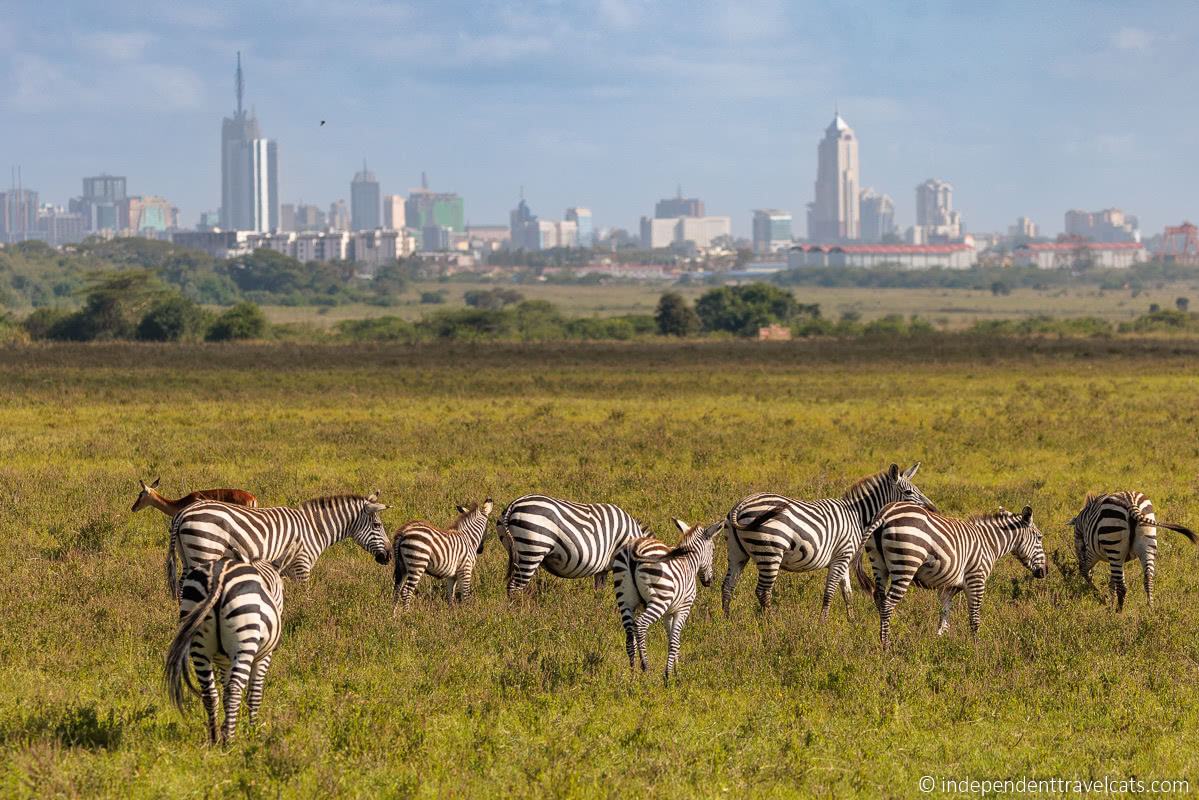
Table of Contents:
Getting to Nairobi
The main way that most international visitors get to Nairobi is by flying into the Jomo Kenyatta International Airport (NBO), Kenya’s main international airport. But you can also reach Nairobi by train, car, or bus.
The main airport in Nairobi is Jomo Kenyatta International Airport (NBO). It is likely that this is where you’ll be arriving into Kenya.
But if you are arriving from elsewhere in Kenya or East Africa, your flight may arrive at the smaller Wilson Airport in Nairobi.
To get from the airport to your hotel or downtown, you can take a taxi, a shared shuttle bus, an Uber, or book a private transfer. Your hotel may offer a free or paid airport shuttle, or you may already have a driver arranged with your safari company. If not, we recommend booking your airport transfer in advance as it tends to be the most hassle-free way.
If you decide to take a taxi, be sure to set a clear price with the driver before agreeing to the trip. Or consider booking an Uber in advance.
Currently, the railway system in Kenya only connects a small area of Kenya, mainly the cities of Nairobi and Mombasa. So the main travelers arriving by train into Nairobi are those who are arriving into Mombasa by plane or ship.
Historically, Uganda, Tanzania, and Kenya were connected by train but the rail connections have been closed for many years.
You can find out information about routes and stations and book train tickets on the Kenya Railways website .
Buses are by far the cheapest way to travel around East Africa. There are long-distance buses that arrive into Nairobi from throughout Kenya as well as from Tanzania, Uganda, and Rwanda. So I’d check online for options depending on where you are wanting to travel from or two.
For example, MASH bus , Modern , and Tahmeed Express are a few of the main bus companies that operate international routes around East Africa.
The Port of Mombasa is the main international seaport in Kenya and the biggest port in east Africa. Most international passenger and cruise ships arrive into this port.
From Mombasa, you can then take the train, a bus, hire a private driver, or drive to Nairobi.
If you have a driver and are arriving on a safari that begins in another country or you are driving yourself, then you may be arriving into Kenya via one of its land borders.
Kenya borders Ethiopia, Somalia, South Sudan, Tanzania, and Uganda. However, the only countries you can currently enter Kenya from by land are Tanzania and Uganda. The open land borders change fairly regularly and if driving yourself, we recommend keeping updated on which land borders are open and the current requirements.
You’ll also want to check the legal driving requirements for Kenya to ensure you have the proper documentation to drive in the country.

Getting Around Nairobi
You have a lot of options for getting around Nairobi including taxis, public transportation, hiring private drivers, joining a tour, renting a car, and walking. We talk about each option below.
Taxis and Ride Sharing Apps
Taxis and ride shares are very popular ways for visitors to get around Nairobi. Although more expensive than public transit, these tend to be easier, safer, and more comfortable.
Taxis can usually be found waiting at the airports, train stations, street corners in the city center, and also around popular hotels, tourist sites, and shopping centers. Licensed taxis in Nairobi are either yellow or marked with a yellow stripe. Just note that many don’t use meters so you will want to agree on a price before you get in the taxi.
You can also use a ride-hailing app like Uber or Bolt to get a taxi. This makes the paying process much more secure as you can pay through the app without needing to exchange any cash. Options in an app may include private car rides, shared rides, and boda boda (motorbike) rides, so just make sure you choose the option you want.
We personally have used Uber multiple times in Nairobi without incident. We find this is often the best option for us, especially at night.
Walking is a particularly attractive option in the central parts of Nairobi, particularly the Central Business District. Many attractions are within walking distance and there are good sidewalks in most areas. If traffic is bad, it is often faster to walk than take a taxi or bus.
However, it is harder to walk in other areas of Nairobi where attractions are much more spread out and there is often a lack of good sidewalks. For those areas you are likely going to need to take a taxi, bus, or hire a driver. This is particularly the case when trying to visit the popular sites in Langata and Karen.
However, you want to be sure to take safety precautions if walking around the city as pickpocketing and robberies do occur (see Safety section). You should also be prepared for people, including children, coming up to you to try to sell you things, ask you for money, etc. These people are normally harmless but they can be annoying.
We don’t recommend walking around the city at night or walking in the higher crime neighborhoods. If unsure if walking is a good idea in a particular area, ask hotel staff, a driver, or your tour operator for advice.
For instance, on our last visit we stayed in the Kilimani neighborhood for several days and walked around Kilimani and the Central Business District a lot during the daytime. But we avoided walking around at night and chose to take taxis after dark.
Public Transportation
There are several forms of public transportation available in Nairobi, including buses, matatus , tuk tuks, and boda bodas . Most tourists don’t take public transit in Nairobi but it can be an inexpensive option for budget travelers and those wanting to experience more local transit options. Public transit can sometimes be the quickest option (e.g., boda bodas) but is not always the safest option.
Prices are often not regulated so prices can vary. Most of these options require cash to board and you’ll want to carry small bills as some may not offer change. Boda bodas can be paid for digitally if you use a ride hailing app. Some services, such as the public buses, may also accept local payment apps such as M-Pesa.
Public Buses
There are a few bus companies operating the city routes with the main one being the Kenya Bus Service (KBS), but newer operators like Citi Hoppa also offer bus services in the city. This is probably the safest of the public transit options for tourists.
Routes are generally noted on the side of the bus and the buses run many of the same routes as the matatus . You can check out routes and how to get from one place to another using apps and websites like Moovit . Google Maps is another option but seems to show fewer options compared to Moovit.
Matatus are privately-owned shared minibuses that operate along set routes and can legally hold up to 14 passengers. They are the most common form of public transit taken by locals in Kenya.
They are also probably the most noticeable of the forms of public transportation in Nairobi as they are often colorfully painted and decorated around a theme (e.g., sports teams, cartoon characters, famous rappers, Biblical scenes) and playing loud music.
These shared minibuses make a number of stops along set routes and the route is noted on the side of the buses. You can find out about the routes on this website . You pay the driver or conductor upon boarding in cash or by Mpesa.
The city is trying to phase out matatus due to poor safety records and so many of them are old and not in the best shape. The one we took in 2022 was rusting and seemed like it was on its last legs.
Generally, this is not a form of public transit that tourists take but it is an inexpensive option. You might also travel by matatus as part of a walking tour with a guide.
The boda boda, or motorbike taxi, is a common form of transportation throughout Kenya as the motorbikes are inexpensive and can move through traffic faster than cars or buses. We’ve seen everyone from students to businesspeople using them.
Motorbikes are a very important form of transportation in Kenya; however, they are not the safest form of transit. The government has been trying to better regulate them in recent years.
Personally, I can’t really recommend boda bodas as I have seen too many horrible motorcycle accident injuries working in hospitals to recommend them. However, if you do want to give them a go, I’d recommend using an app like SafeBoda or Uber to hail rides to better guarantee a licensed and safe driver. A driver should offer you a helmet and vest to wear and I would not recommend jumping on without a helmet.
Some tours may include transport by boda boda but it is not common.
A tuk tuk or auto rickshaw is another public transit option in Nairobi. These 3-wheeled vehicles are perhaps a safer alternative to the boda boda. However, they are slower and seem to mainly operate for those going shorter distances outside the city center. We for instance took one in Kibera with our guide to get from one side of the neighborhood to the other.
Driving Own Car
Driving is of course another way to get around if you have your own car or plan to rent one in Nairobi. You’ll want to ensure you are knowledgeable about local driving rules and regulations and we recommend choosing a hotel that offers secure and monitored parking.
There is normally free parking at most major tourist attractions and shopping centers; however, you’ll likely need to pay for parking in more central areas. You can find out more about paying for parking in Nairobi here .
We generally don’t recommend driving in Nairobi if you can avoid it. Nairobi is a busy and congested city and traffic in the city is often bad. Most of the main roads are in good condition; however, there is almost always roadwork going on and some of the roads away from the city center are in fairly poor condition with lots of potholes.
Private Drivers & Tours
Joining a tour or hiring a private driver is another common way for visitors to get around Nairobi. If you are visiting as part of a tour or safari, you may have a driver/guide for your time in Nairobi who will handle all your transport.
There are a lot of tours which you can join and be part of either a group or have a private guide who will take you to see Nairobi’s attractions. These generally include pick-up/drop-off from your accommodation as well as all transport throughout the day. These are convenient options that are perfect for people who don’t want to deal with public transit or taxi services. You can see a lot of Nairobi tour options here and here .
Hiring a private driver can be a good idea if you need a driver to visit several places. For instance, we hired a private driver on Laurence’s birthday as we had a day’s itinerary planned out with several stops over an 8-hour period. This made our day really stress-free and easy and our driver was great.
If you have just one day in Nairobi, you can check out our 1 day Nairobi itinerary which details each of the places we visited on our first trip. It also includes a number of small group tour and private tour options if you want to do a similar trip.
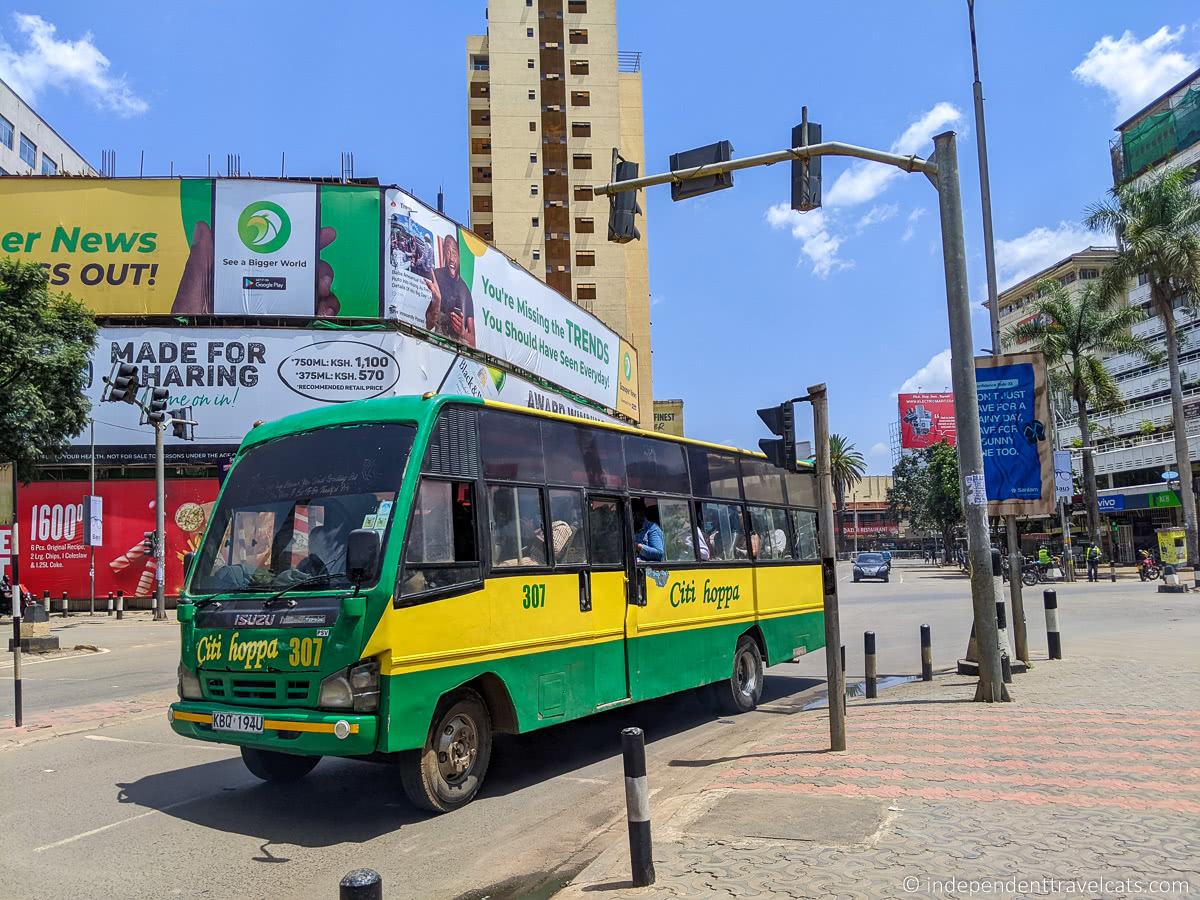
Kenya Travel Basics
In this section, we’ll cover all the basic travel info about planning your trip to Nairobi, including visas, electricity, money, language, weather, and clothing.
Most international visitors to Kenya will require a visa to enter the country. You should check your own government’s guidelines and those of Kenya for visa and entry requirements. You can apply online for an e-visa on Kenya’s government e-visa website here .
Note that if you are also visiting Uganda and/or Rwanda, you may want to apply for an East Africa visa instead. This visa covers Kenya, Uganda, and Rwanda. You can apply for this visa through the same website.
To enter Kenya, most travelers will need a valid e-visa, a passport valid for at least 6 months past their travel dates, a printout of their travel itinerary, a support letter (generally from your tour company or business hosting you), hotel booking details, and proof of planned departure (e.g., flight or booked safari itinerary). Many travelers may also be required to show proof of certain vaccinations against certain diseases such as yellow fever and COVID-19.
There are a lot of languages spoken in Kenya, but the main two are Swahili (Kiswahili) and English. Swahili is the most widely spoken language in Kenya, but English is also an official language and is widely spoken and understood. This is particularly true in Nairobi.
Tourists who don’t speak Swahili or English often hire a local guide who speaks their native language or hire a translator.
Communication
We just wanted to note that many drivers, guides, and small businesses in Kenya use Whatsapp messaging as the main way (and sometimes only way) to communicate. We recommend considering setting up a free Whatsapp account on your phone if you don’t already have one. This was the main way we communicated with our guides and drivers while in Kenya.
The currency of Kenya is the Kenyan shilling (Ksh). It is easy to find an ATM in Nairobi to take out local currency and we recommend using ones either at the airport or at a bank. Credit cards, as well as certain money transfer apps like M-Pesa , are widely accepted.
Foreign currencies, like the United States dollar, Euro, and British pound sterling are also regularly accepted in the tourism industry. The most accepted and most stable foreign currency in Kenya is the U.S. dollar. In fact, many tourist activities are priced in US dollars. So it is a good idea to have US dollars with you.
However, it costs money for locals to exchange foreign currency into local currency, so it is good to pay smaller businesses and to tip local guides in Kenyan shillings if possible.
In Kenya, we generally use USD to pay for things at hotels and tourist attractions and for large tips (e.g., main safari guide or driver). However, we generally used Ksh to tip local guides and staff, pay at markets and local restaurants, or to buy souvenirs. So it is good to have some of both currencies on you throughout your trip.
Some attractions, particularly after the COVID-19 pandemic hit, started only accepting non-cash payments. But a couple of places we visited only accepted cash. So it is a good idea to have both a credit card (or M-Pesa) and cash on you while in Nairobi.
Electricity
Kenya operates on a 240V supply voltage and 50Hz and uses a Type G plug. So you will want to avoid packing any electronics that don’t support 240V.
If you are coming from a country that does not use a Type G plug (three-prong one found in the UK), you will need a travel adapter to plug in your electronics. You can pick up a few simple travel adapter plugs like these ones , or you can take some universal travel adapters like this one which work in most countries around the world.
The average annual temperature is around 66° F (18.5° C). Daytime temperatures rarely go below 50° F (10° C) or above 85° F (29° C).
February and March are typically the hottest months in Nairobi with an average temperature of 69° F (20.5° C) and the coldest months are July and August with an average temperature of 62° F (16.5°C).
Kenya has two rainy seasons, from March to May and from October to December. The rainiest month is April with a lot of rain also typical in May and November. So you’ll definitely want to be prepared for rain if visiting during the rainy season, but we’d recommend being prepared for rain no matter when you visit.
Nairobi is a city you can visit any time of the year. The weather is pretty temperate throughout the year, being warm during the days and cool at night. Most attractions in the city are open year-round to visitors.
How to Dress in Nairobi
We recommend wearing comfortable clothing in Nairobi that are suitable for the weather. It is often sunny in Nairobi so be sure to protect yourself from the sun and check the weather forecast for rain.
It is important to respect the local culture and customs while in Kenya, which means wearing clothing that is more loose-fitting and conservative. This means avoiding really tight-fitting clothing or clothes that are short, show off your stomach, or expose a lot of skin. However, although Kenyans may wear more conservative styles, they love color and bold patterns!
Now, while safari clothing and hiking boots are great to wear when on safari or hiking, we don’t recommend wearing those clothes when visiting Nairobi (unless you are going to Nairobi National Park). We recommend wearing your regular travel clothes and leaving your safari clothing in your suitcase while exploring the city.
For shoes, you’ll likely be walking around a lot so you’ll want comfortable walking shoes. It is also good if you wear shoes that you don’t mind getting a little dirty. Laurence and I wore Allbirds Tree Runners shoes during our last visit to Nairobi and they worked very well.
For more packing suggestions, see our guide to what to pack for safari which should help with your general packing list.

Travel Health
We love traveling in Kenya, but there are precautions you need to take to stay safe and healthy during your travels. These include avoiding untreated water, avoiding being bitten by mosquitoes, and making sure you are up to date on recommended vaccines and medications.
We highly recommend that you talk to your doctor or go to a travel clinic before your trip to see what vaccines and medication are needed or recommended. You can also discuss water safety, preventing mosquito bites, managing any existing conditions you may have, and traveling with medications.
We also highly recommend reading the health advice given by your local government for travelers to Kenya. You can see the U.S. CDC travel health information and recommendations to travelers here , and from the UK government here .
Water Safety
The tap water in Nairobi is not considered safe to drink for travelers by most government travel organizations. In Kenya, it is recommended that you only drink bottled water or tap water that has been boiled, treated, and/or filtered.
Drinking untreated water or eating unclean food can cause travelers’ diarrhea and other water-borne diseases, such as cholera, hepatitis A, polio, and typhoid. So you will want to take the normal precautions as you would when traveling to any destination with unsafe water, such as avoiding ice, unwashed or unpeeled raw fruits and vegetables, unpasteurized dairy products, and cooked foods that are not served hot.
If you are wanting to avoid buying bottled water in Nairobi, you can read this article on safe drinking water when traveling for ways that you can treat water when traveling. We used a Grayl water filter bottle for filtering tap water for drinking, cooking (e.g, washing fruits), and brushing our teeth while in Nairobi on our last trip. This made it so that we didn’t need to buy any bottled water.
There are a number of vaccinations recommended for travelers to Kenya. You should talk to your doctor or go to a travel clinic before your trip to see what vaccines and medication are needed or recommended. These will depend on what parts of Kenya you are visiting, what you plan to do there, and your medical history.
I think before our last trip to Kenya, our doctor recommended 3 vaccine boosters for me and 2 for Laurence. We also got antimalarial medication to take throughout our trip.
You should make a travel health appointment at least 2 weeks prior to travel as some vaccines, such as the yellow fever vaccine, may take at least 10 days to be effective.
Proof of some vaccinations, such as yellow fever and COVID-19, may be required, depending on where you live, where you have traveled, and any recent disease outbreaks. Be sure to check the latest requirements.
There are mosquitoes in Nairobi although the risk of malaria and other mosquito-borne diseases if bitten is typically very low in the capital according to the WHO and other health organizations. The number of mosquitoes fluctuates based on rainfall, temperature, and time of year.
However, while the risk of getting malaria may be low in Nairobi, it is much higher in many other parts of Kenya. If you are visiting other parts of Kenya, you should talk to your doctor before your trip about antimalarial medications. Most visitors to Kenya take antimalarial medication during their trip and we have always done so.
But even if you are not worried about the risk of malaria in Nairobi, mosquito bites are annoying, itchy, and can transmit other diseases (e.g., yellow fever, dengue fever, Rift Valley fever, and chikungunya). We were bitten a few times on our 2022 trip in Nairobi because we forgot to use a mosquito net one night.
The best ways to prevent mosquito bites include using insect repellent with DEET , wearing long sleeved shirts and long pants, and using mosquito nets. Mosquitoes are most active between dusk and dawn.
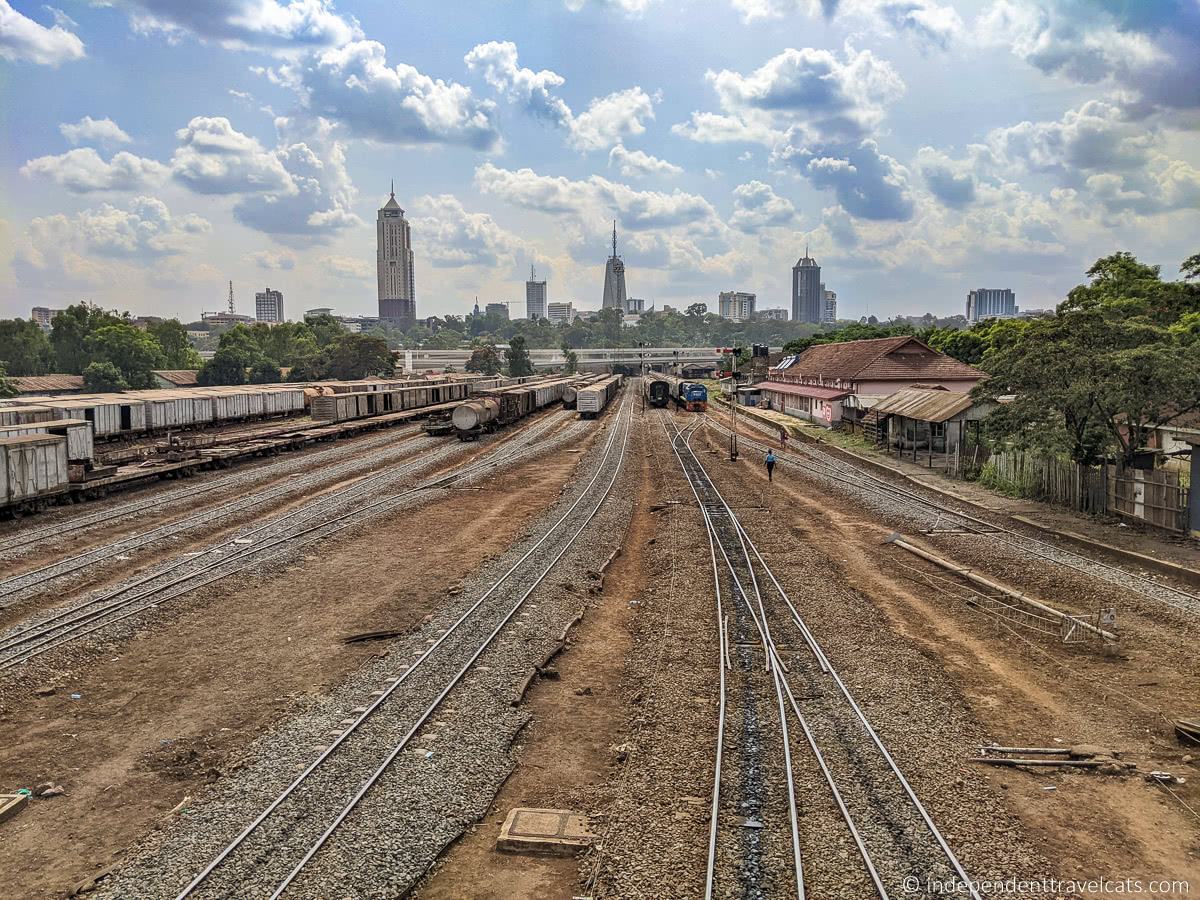
Is Nairobi Safe for Tourists?
Nairobi is not considered the safest city and its rate of crime is often rated as “high” compared to other cities in the world. But it has improved from the days when it was referred to as Nairobbery due to the high crime rates. While it is of course impossible to predict crime or terrorism, by taking precautions you can travel safely in Nairobi.
You particularly want to be careful with securing valuables and being aware of your surroundings. The most common crimes against tourists are pickpocketing, muggings, and carjackings. You also want to be skeptical of people approaching you asking to sell you something (e.g., cheap safaris or tours) or asking for donations for a good cause.
It is recommended that travelers avoid Nairobi neighborhoods where there is increased crime rates like Eastleigh and Kibera. We have visited Kibera but only during the day when accompanied by a guide.
Like in many major cities, we recommend taking extra precautions if out in the city at night. We always get a taxi or hire a driver if we need to get around at night.
It is best to carry around only the amount of money needed for your day so that if you are robbed, you won’t lose a great deal of money. If robbed, don’t resist, just give them what they want to avoid any physical escalation. It is also a good idea to have a money belt or similar separate place to hide your passport and a spare credit card.
If carrying a purse or bag, we recommend a cross-body one, a sling, or a fanny pack that is harder for someone to snatch and less likely for you to set down. If wearing a backpack, we recommend considering a small one with lockable zippers, such as the ones by PacSafe . We recommend carrying only what you need for the day.
Even if it may be fairly obvious that you are probably a tourist, you still want to avoid being too conspicuous by not carrying around big cameras, designer handbags, wearing expensive jewelry, etc. Best to leave your expensive gear and valuables at home or locked up at your hotel.
I’d also recommend avoiding holding out your smartphone while walking around, not only is it something that is easy to steal but it also distracts your attention. If you need to check your phone, do so before you set off or when in a safe spot. Also, it is always a good idea to have any important information and your photos backed up elsewhere so if your phone is lost, stolen, or damaged you still have all the data.
If walking around, especially in the city center, you will no doubt be approached by people trying to sell you cheap safaris and such. I’d recommend telling them politely but firmly that you are not interested and moving along. They will generally leave you alone but if you are feeling harassed or followed, I’d recommend going into a hotel, restaurant, or store to get rid of them or telling a nearby police officer or security guard.
Not all taxis and drivers in Nairobi are reputable. If you need a taxi, we recommend using a secure taxi-hailing app like Uber or Bolt. These make it so the prices are regulated and you can pay without needing to hand money to the driver. We have used Uber many times in Nairobi without incident.
Being stuck in traffic in Nairobi can attract street sellers, beggars, and thieves. When in a car, I’d recommend keeping your window rolled up and your door locked. If in a manatu , I’d keep hold of any bags or valuables to prevent thieves from snatching things.
Don’t be afraid to ask questions of your driver, hotel staff, local guides, tour operator, etc. about whether it is safe to do X or Y. If you are unsure if it is a good idea to walk or visit somewhere, it can be good to get a local opinion. Most people are very willing to give advice for visiting their city.
You want to be particularly cautious when traveling in Kenya around the time of elections or referendums as violence, rioting, and ethnic tensions in the country often escalate during these periods. If you are visiting at a more tense or politically unstable time, it is probably safer to stick to guided activities. However, thankfully, even though the 2022 presidential election was contested, it was a fairly peaceful transition of power.
It is a good idea to check with your local government’s advice on traveling to Kenya and take that into consideration. For example, at the time of writing, the U.S. Department of State recommends avoiding the Nairobi neighborhoods of Eastleigh and Kibera due to increased crime there. On many government agency websites, such as the U.S. travel alerts , you can also sign up for travel alerts by text or email to get updates while traveling.
We always recommend making sure you have travel and medical insurance coverage. If you experience a crime, you should report it to the local police. Even if they aren’t likely to be able to help (e.g., pickpocketing), you will likely still need a copy of a report for your insurance. For more serious issues, you may also want to contact your country’s embassy or consulate who can help direct you to further resources.
While the above may make Nairobi sound scary, we have visited Nairobi several times without any incidents. We have walked around a lot in the city on our own, especially around the Downtown area. We have hired local drivers, taken local transportation, and used Uber. We have done both guided and unguided visits to most of the city’s main attractions. We have also gone shopping on our own at both shopping centers and local markets.
Although we have traveled more independently in Nairobi than most foreign visitors, we still take the precautions we note above. The main thing we have experienced is people coming up to us to beg for money, try to convince us to follow them and visit their shop, or trying to sell us cheap safaris. Sometimes they are pretty persistent and annoying, but generally, they will leave you alone if you are firm and move away.
We recommend that those who are concerned about safety stick to guided tours or hire a private guide or driver. Guides can not only make travelers feel safer, but they can also help make everything run smoother and can provide invaluable background and context to the places you visit. But also remember that even a guide can’t always prevent things like purse snatching or pickpocketing, so you still need to use personal caution.
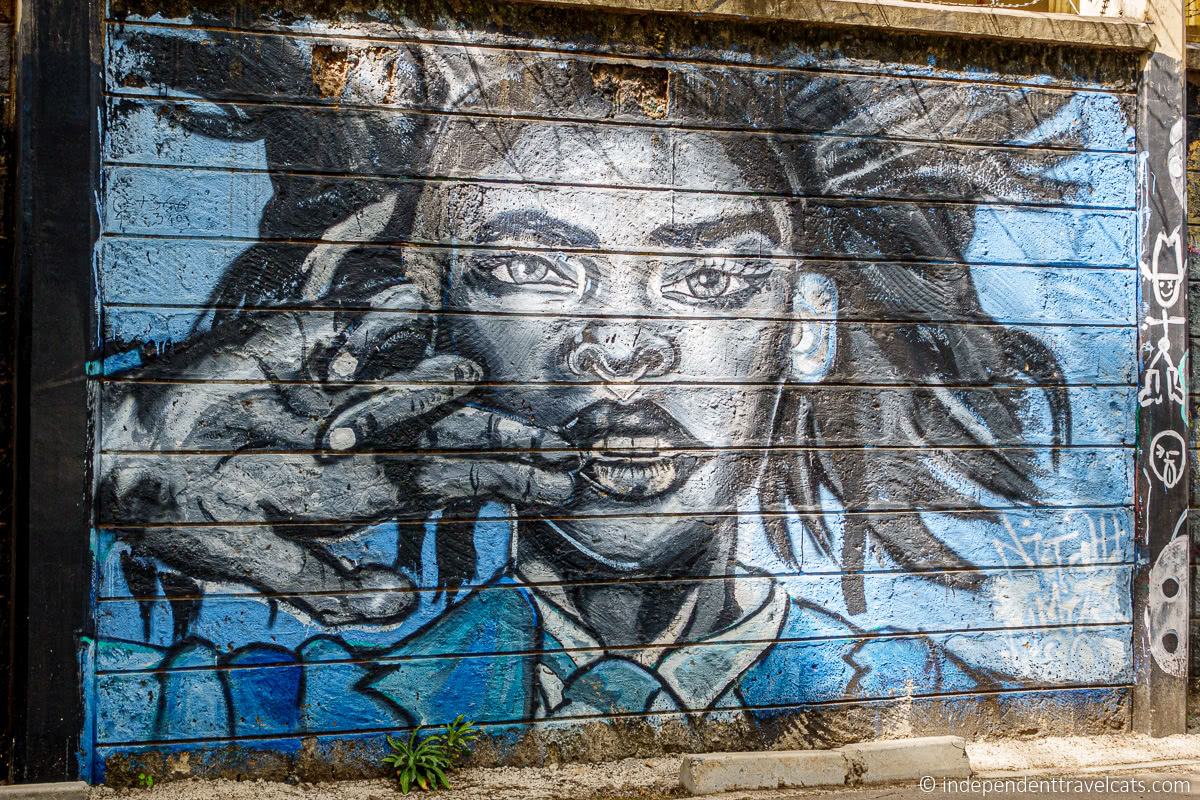
How Much Time Should I Spend in Nairobi?
How much time you want to spend in Nairobi will likely be determined by your interests and the length of your trip. There are lots of things to do and see in Nairobi and you can easily spend several days in the city as we have.
As the capital and largest city in Kenya, we definitely think that Nairobi deserves at least one full day of your trip. No matter your interests, whether it is history, culture, wildlife, shopping, art, or food, you are likely to find things that appeal in the city.
Personally, I’d recommend having at least 2 full days in Nairobi. That will give you time to see many of the highlights of the city. But you can still see quite a lot if you just have one full day. You can check out our earlier article to see our tips for how to spend one day in Nairobi which includes a detailed stop-by-stop suggested itinerary.
If you have a safari that begins or ends in Nairobi but your safari itinerary doesn’t include any sightseeing in Nairobi, you can easily book a guided day tour of the city such as these available online here or here . Or you can explore independently on your own. You may want to arrange to come into the city a day or two early or stay later to have time for sightseeing before or after your safari.
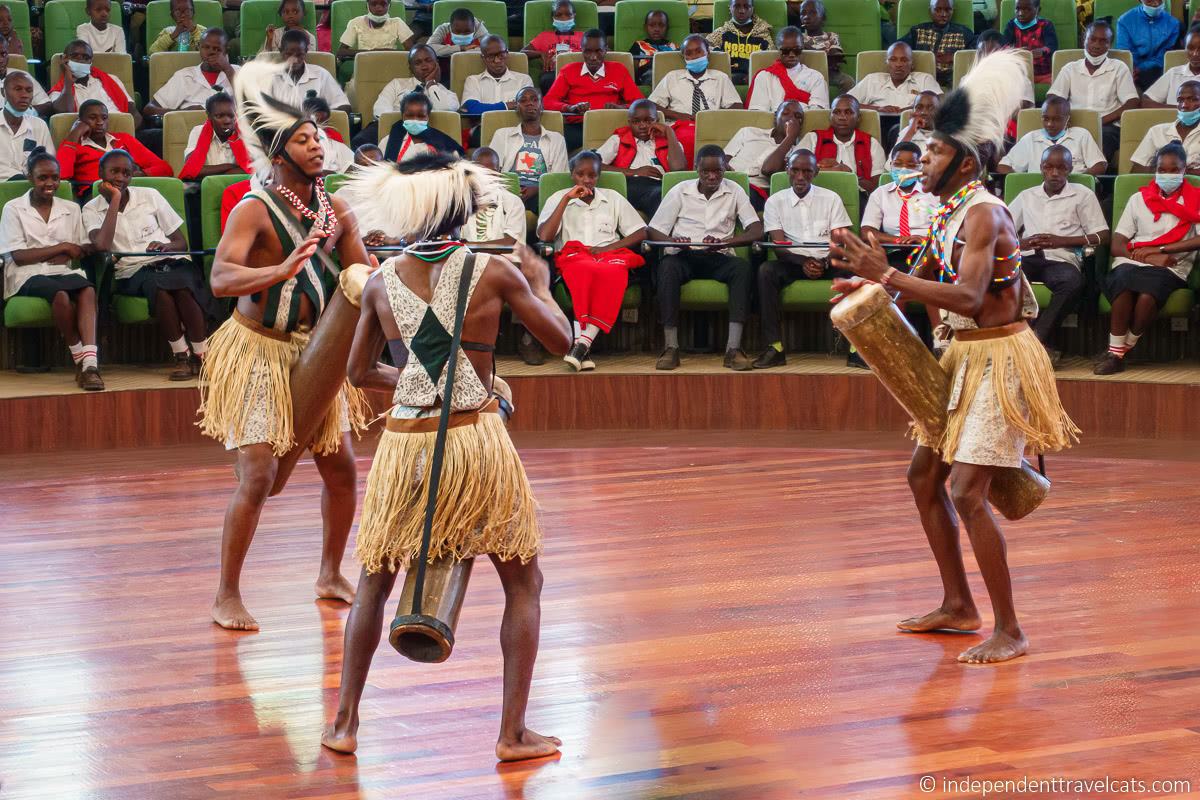
Where to Stay in Nairobi?
We recommend choosing your location based on the places you want to go in Nairobi, especially if you only have a short time in the city. Generally, we would recommend staying either in or near the Downtown area of Nairobi or in one of the western neighborhoods like Lang’ata or Karen.
Nairobi has a very wide range of accommodation options including hotels, guesthouses, hostels, apartments, and home rentals. Prices range from cheap $30 budget stays to $3,000 per night luxury stays. We have found it very easy to find mid-range accommodation during our stays in Nairobi.
If booking accommodation in the more budget range, just be sure to read recent reviews, check the details to see what is included, and make sure in an OK area of the city.
We generally recommend booking accommodation that includes an on-site restaurant (or cooking facilities if booking an apartment or hostel) as then you always have the option to eat your evening meal there. Even if you plan to eat out elsewhere, this gives you a very convenient backup option if you don’t feel like going out at night.
Downtown Nairobi and the Westlands
The Downtown area or Central Business District (CBD) is a great area for those planning to visit central attractions like the Kenyatta International Convention Centre, City Market, Jamia Mosque, Maasai markets, Central Park, Uhuru Park, Nairobi National Museum, Railways Museum, and downtown shopping. The Westlands area , located just north of the center, is also a good place to check and is a popular area for expats.
Here are some lodging options in both the CBD and Westlands areas:
- Stanley Hotel – The Stanley Hotel was Kenya’s first luxury hotel, dating back to 1902. This 5-star hotel offers 3 restaurants, a bar, a fitness center, a pool, and on-site private parking. It is located right in the heart of the Central Business District. If you are looking for a historical hotel in a central downtown location this is one to consider.
- The Norfolk – This 5-star Fairmont property is another one to consider if you enjoy historical hotels as the hotel is situated in a 19th century colonial building surrounded by gardens in the northern part of the CBD. It offers several restaurants, a fitness center, a pool, and 24-hour front desk.
- Hilton Nairoi – This 4-star hotel is a good option for business travelers and conference attendees who want to be super close to the KICC. The hotel offers on-site restaurants, bar, fitness center, business faciltiies, spa, pool, and 24-hour front desk. The hotel is located in the CBD and is just a short 5-minute walk from the KICC building.
- Best Western Plus – This hotel is a solid mid-range option located in the CBD. The hotel offers a restaurant, bar, a fitness center, and a swimming pool.
- YWCA – If you are traveling on a small budget, this YWCA is located just outside the CBD may be an option to check out. It offers private rooms and an on-site cafeteria.
- Nairobi Serena Hotel – This is another 5-star hotel that is located just outside the CBD, offering spacious rooms, on-site restaurants, bar, fitness center, pool, and 24-hour front desk. This hotel is part of the popular Serena hotel brand that has hotels throughout East Africa.
- Villa Rosa Kempinski – The Villa Rosa is a lovely 5-star option in the Westlands area, offering spacious rooms, on-site restaurants, spa, fitness center, 24-hour desk, and swimming pool.
- Lotos Inn & Suites – This mid-range hotel in the Westlands offers spacious suites, an on-site restaurant, rooftop lounge, and free private parking. Close to a number of restaurants and shopping centers.
Western Neighborhoods of Nairobi
Lang’ata and Karen are both good locations for popular tourist attractions such as the Giraffe Centre, Uhuru Gardens, Karen Blixen Museum, Bomas of Kenya, Carnivore Restaurant, Kazuri Beads factory, and Sheldrick Wildlife Trust Elephant Orphanage. It is also a good location for those visiting Nairobi National Park.
Another good area to consider is the areas just west of Downtown Nairobi which put you in between the Central Business District and the areas of Lang’ata and Karen. These include areas like Lavington and Kilimani . Good areas for those visiting attractions in both of these areas and where we often choose to stay.
Here are some accommodation options in the western suburbs of Nairobi:
- Hemingways Nairobi – This 5-star luxury boutique hotel located in Karen offers an on-site restaurant, bar, spa, swimming pool, and private butler service. All rooms are suites. This is one of the more luxurious properties in Nairobi.
- Karen Gables – This 4-star Karen lodging option offers a luxury B&B experience in a beautiful Dutch Cape style private home. Offers an on-site restaurant, lounge, and swimming pool.
- Tamarind Tree Hotel – This 4-star hotel in Langata offers an on-site restaurant, bar, swimming pool, fitness center, and garden. The famous Carnivore restaurant is on the grounds, a short walk away. Great location for lots of Langata and Karen attractions, Wilson airport, and Nairobi National Park.
- Palacina The Residence & Suites – This great mid-range option in Kilimani offers both suites and private apartments. The property offers an on-site restaurant, fitness center, and swimming pool.
- The Social House – This mid-range 4-star hotel is located near the Lavington area and offers an on-site restaurant, swimming pool, fitness center, and garden.
- Margarita House – This guest house located in Karen offers an on-site restaurant, swimming pool, and garden. A reasonably priced option in the pricey Karen area.
- Lavington Hill House – This 3-stars guesthouse in Lavington has an on-site restaurant and bar and is surrounded by leafy gardens. Before it became a boutique hotel, it was the official state residence of the President of Southern Sudan. This was the very first place I stayed in Nairobi years ago.
- Pori City Hotel – This budget-friendly 3-star hotel option in the Langata area offers an on-site restaurant, bar, business center, and a 24-hour front desk.
Near the Nairobi Airport
If you need to stay near the Jomo Kenyatta International Airport (NBO) you can look for a hotel in the Embakasi area . This area is mainly residential. The closest hotels are the Sheraton Four Points and Crowne Plaza airport hotels. A lower-priced option near the airport is Kozi Suite s .
If you need to stay near the regional Wilson Airport, you can see the closest lodging options here , many are in the Lang’ata area. The closest hotel to Wilson Airport is the Weston Hotel and another good nearby option is the Tamarind Tree Hotel . The Pinkroses Garden Hostel is a well-rated budget option in this area.
Nairobi National Park
There is currently only one accommodation option (other than basic camping) located inside Nairobi National Park and that is Nairobi Tented Camp . The tented camp is a great place to stay if you want to be inside the national park and feel like you are on safari. Just note that you will need to pay the park fees each day of your stay in addition to the lodging costs.
If you are looking for a place away from the city, there are also several other hotels located on the southside of the park. A couple of good options located on the edge of the park include Ololo Safari Lodge and Nyati Hill Cottages . They are situated overlooking the escarpment of the national park and you often see wildlife without leaving the property. Great places to relax and to stay for visiting Nairobi National Park, but not the best location for visiting downtown attractions.
Neighborhoods in Northern Nairobi
If you are just looking for the safest neighborhoods in Nairobi, then Gigiri and Muthaiga are two northern suburbs which are often rated as the safest places to live in Nairobi. They are close to Karura Forest as well as restaurants and shopping, but are further away from most tourist attractions.
There are a number of hotel and apartment options in this area including the 5-star Tribe Hotel and well-rated mid-range Trademark Hotel and Magna Hotel & Suites . All are located in Gigiri.
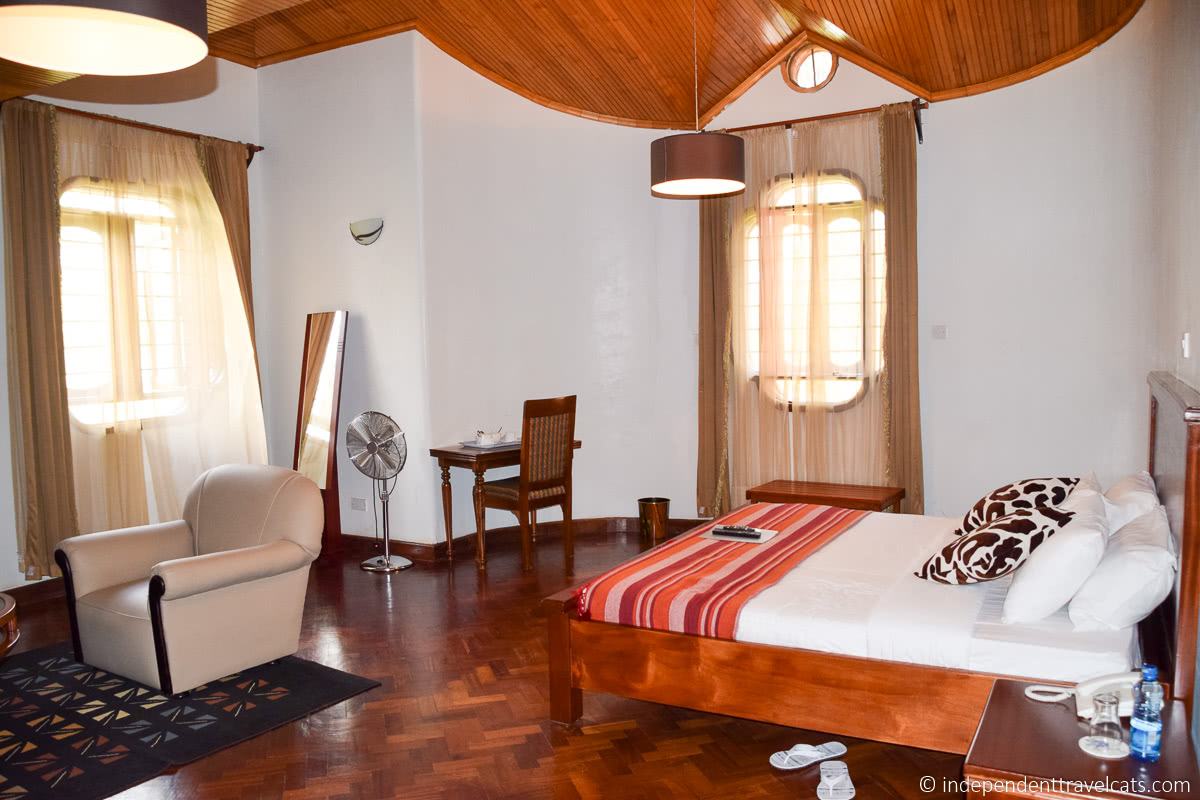
Booking Tours in Nairobi
Most visitors book some kind of tour or driver for sightseeing in Nairobi. You can visit just about any of the recommended attractions as part of a tour. There are a lot of tour options for both those wanting to join a small group tour and those looking for a private tour.
As always, when booking any type of tour, be sure to note what is included/excluded and any restrictions before booking. Entrance fees and meals may not be included so you will want to plan and budget accordingly. Some tours may also have minimum age requirements or health restrictions.
Also be sure to check the tour’s cancellation policies. We normally book tours with either GetYourGuide or Viator which both offer a 24-hour cancellation policy for most tickets and tours. This means you can cancel a tour up to 24 hours before it starts and receive a full refund. This helps give us peace of mind if our travel plans unexpectedly change.
If you are looking for a tour in Nairobi, here are a list of some popular Nairobi day tours (both small group and private tours) that may be of interest. These cover a wide range of Nairobi’s top attractions:
- This 6-hour guided tour includes a game drive at Nairobi National Park and visits to the Giraffe Centre and the Sheldrick Wildlife Trust Elephant Orphanage.
- This flexible private tour includes a downtown city tour, which can include stops to see the City Market, Kenya National Archives, and KICC rooftop, and lunch at Carnivore.
- This full-day tour includes visits to the Giraffe Centre, David Sheldrick Wildlife Trust Elephant Orphanage, Kazuri Beads factory, and the Karen Blixen Museum. This is very similar to the tour I took on my first visit to Nairobi.
- This full-day tour includes visits to the Giraffe Centre, David Sheldrick Elephant Orphanage, Kazuri Beads, and Bomas of Kenya.
- This 4-hour private downtown tour includes stops at the Nairobi National Museum, Railway Museum, City Market, and KICC rooftop. Tour is flexible.
- This downtown walking tour of the Central Business District is led by former street children who guide you through the downtown while telling their stories. Also includes a local lunch stop.
- This half day tour includes a visit to the Sheldrick Elephant Orphanage, Giraffe Centre, and Kazuri Beads.
- This half day private tour of Nairobi National Park includes a guided game drive, safari vehicle, and hotel pick up and drop off. Or save money by joining a similar small group tour of the park.
- This private tour includes transport, a guide, and entrance fees to visit the Bomas of Kenya.
- This guided tour of Kibera allows you to learn about and tour Africa’s largest slum area with a local guide who runs a non-profit organization.
- This guided full day shopping tour of Nairobi allows you to visit a number of shops, markets, and craft centers in Nairobi.
Now, if you are planning on doing a multi-day safari in Kenya, you should definitely research and book one before you leave home. It is possible to visit some of Kenya’s national parks (other than Nairobi National Park) as part of a day trip from Nairobi, but I’d recommend tours that stay overnight or longer so you are not rushed.
Popular places you can go on a safari within a relatively short drive of Nairobi are Lake Naivasha National Park (~2.5 hours drive), Lake Nakuru National Park (~3.5 hours), Amboseli National Park (~4 hours), and the Maasai Mara (~4.5 hours).
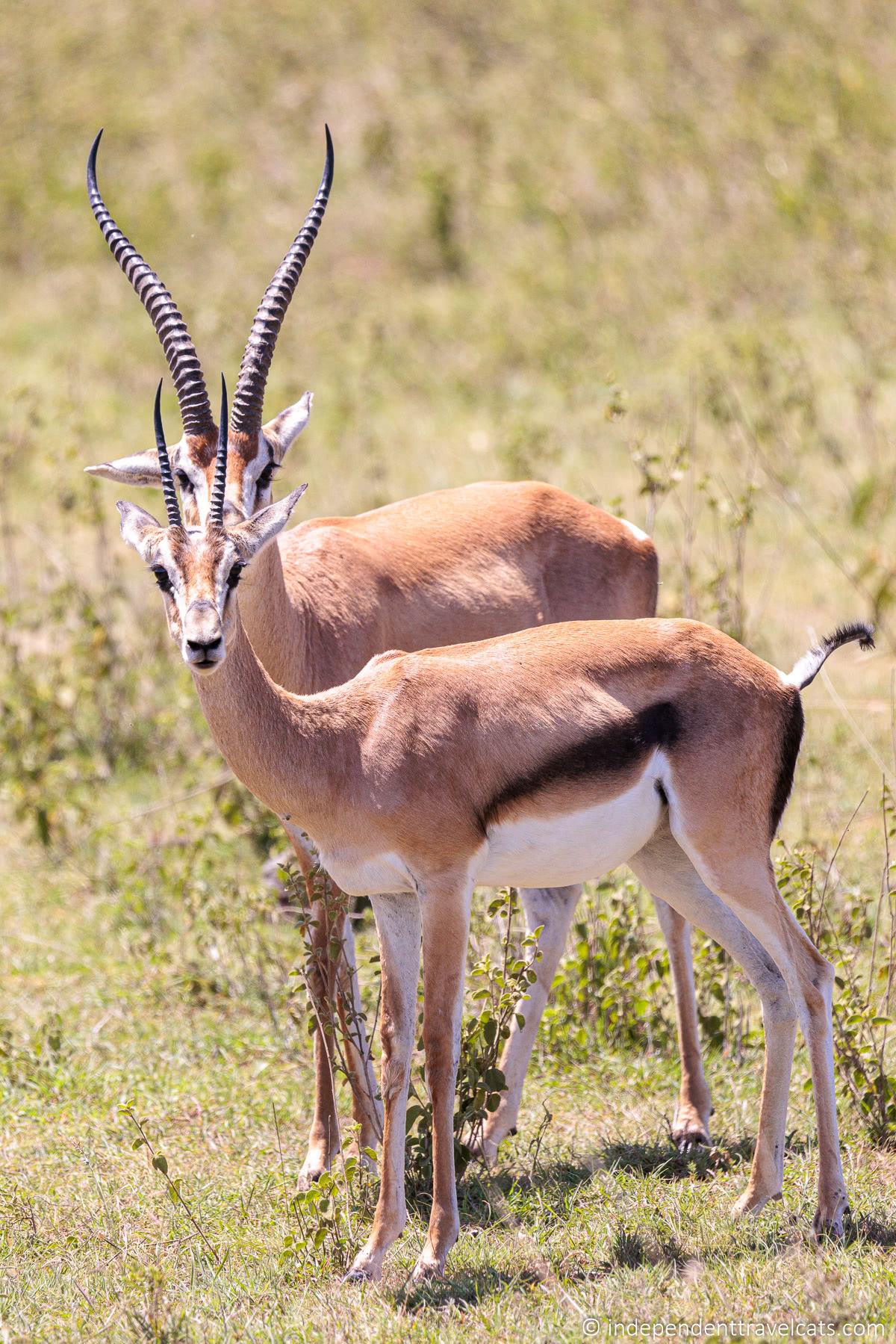
Top 24 Things to Do in Nairobi
Nairobi has a lot of attractions, including wildlife centers, museums, parks, gardens, and markets. We recommend using this list to choose the places you most want to visit so you can put together your own Nairobi itinerary.
Here is our list of top things to do in Nairobi:
Nairobi City Tour
A city tour with a local guide is a great way to see Nairobi if you are a first-time visitor. It is especially nice to explore the downtown area with a local guide to learn more about the city.
There are both walking tours and driving tours that you can join, depending on how you want to get around. You can hire a private guide or join a small group tour. The private tours are often flexible in terms of where they visit so you can choose from a list of attractions that best suit your interests. But you can save money by joining a group tour if it goes to the places you want to visit.
These tours are usually focused on the downtown Central Business District and often include visits to local landmarks, public parks and gardens, markets, the KICC building, museums, and other city attractions. They may or may not also include lunch.
You can check for available city tours in Nairobi here , as they vary in time, where they visit, what they include, and the forms of transportation. For example, this half day city orientation tour includes both private transport and walking (if you want). This tour also includes lunch at Carnivore.
For those interested in walking and getting closer to the city’s landmarks and people, you might consider this popular downtown walking tour , this storytelling tour , or this walking food tour .
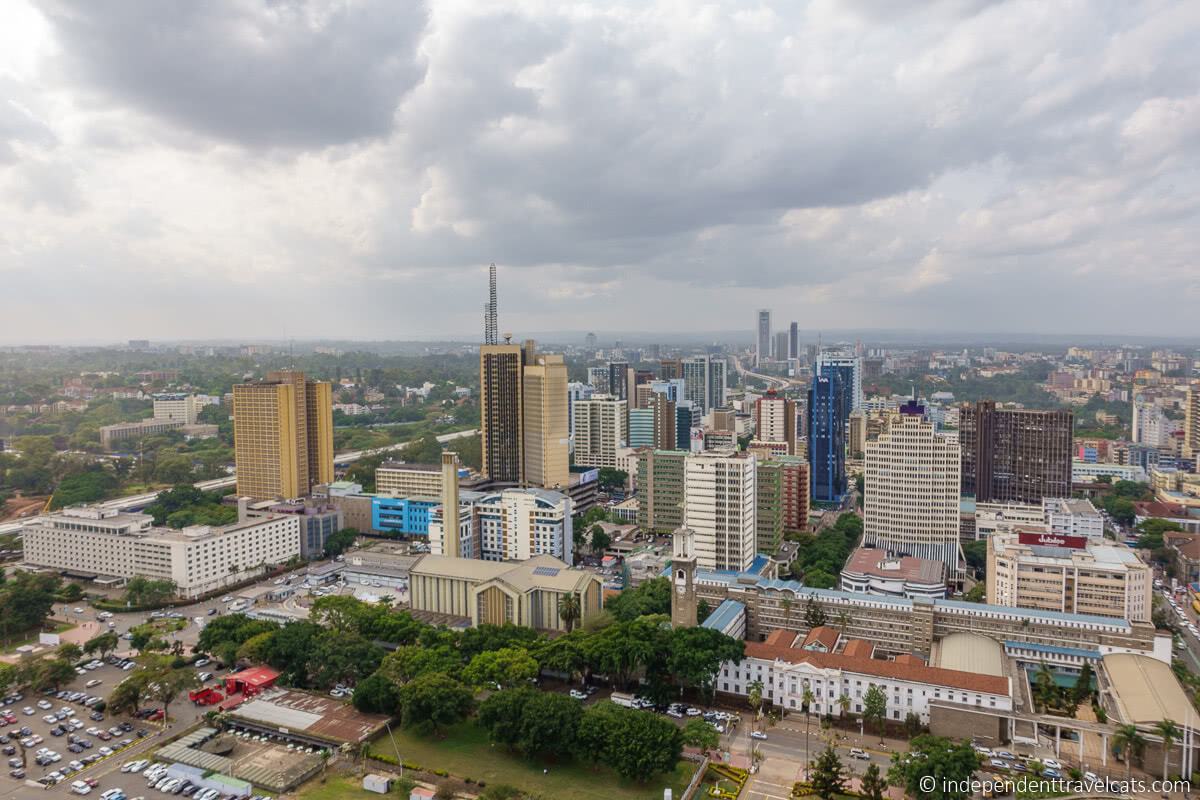
Nairobi National Museum
Nairobi National Museum is a great general museum to visit while in the city. The museum has been around in some form for over 100 years, first set up in colonial Kenya by the British. It carried on after independence and has been expanded and updated over the years. It is the flagship museum of the National Museums of Kenya.
The museum has a number of different galleries that each focus on a theme such as Kenyan history, mammals, birds of East Africa, cultural anthropology, human evolution, money, art, and musical instruments. There are also changing temporary exhibitions.
A couple of displays that international visitors often know about are the skeleton of Ahmed the elephant (one of the most famous elephants in the world) and the Joy Adamson Gallery (known for her book Born Free and the movie of the same name).
There is a fee to visit the museum. You can do a self-guided visit on your own or hire a guide. The museum is located in central Nairobi, just north of the Central Business District and just south of the Westlands.
In addition to the museum, you’ll also find the Museum Botanical Gardens, a nature trail, and the Snake Park at the same location. Visiting the Botanical Gardens and walking along the nature trail are free to do and worth doing if the weather is nice. But there is an extra fee to visit the Snake Park (you can buy a combo ticket), which includes a number of snakes and other reptiles on display. You can check rates online here .
Also here at Museum Hill you’ll find places to eat, gift shops, and the Louis Leakey Memorial Institute auditorium. You can easily spend half a day here.
Nairobi National Museum would be our top pick if you are looking for just one museum to visit in Nairobi. It is a good general museum and a great place to learn more about the country with a wide variety of displays.
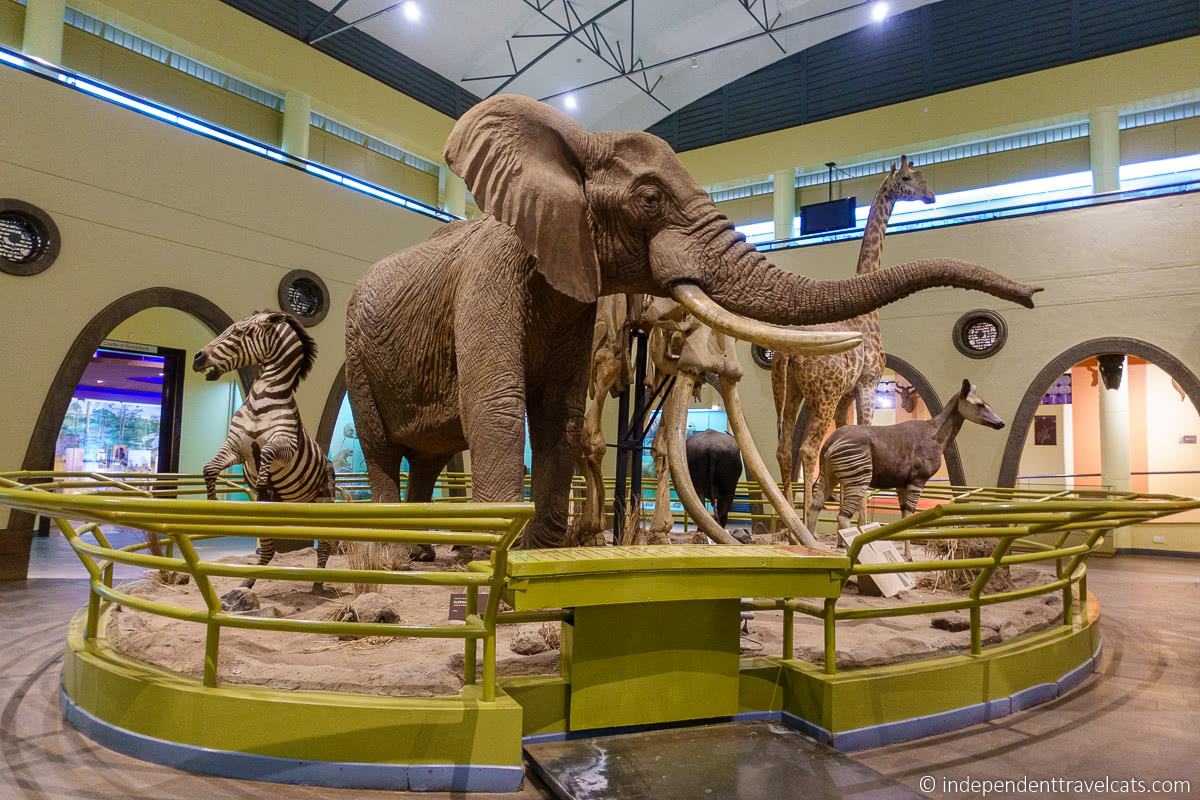
Nairobi National Park is unique as it is the only wildlife park located within a capital city. It is located just 10 km south of the downtown area of Nairobi. It is one of the few places in the world where you can spot animals with a city landscape in the background.
Although a somewhat compact park, it has over 100 species of mammals. It has 4 of the Big Five animals; the park does not have any elephants. It has many of the animals that people come to Kenya to see, including lions, leopards, giraffes, zebra, cheetah, hyenas, rhinos, hippos, impala, baboons, and crocodiles. Over 400 bird species have been recorded here.
If you plan to visit the park, we recommend going early and visiting in the morning. Many of the animals and birds are more active in the cooler morning hours. You can obviously see more if you have a full day. But if you just have half a day for visiting, we recommend choosing the morning rather than the afternoon to visit.
You can drive your own vehicle or hire a guide. We highly recommend going with a driver guide who knows the park and in a proper safari vehicle with a pop-up roof. A good guide can really help you see more and better identify the animals and birds you do see.
If you are looking for a half day morning game drive with a driver in Nairobi National Park, you might check out this popular small group tour or this private tour . These tours normally include pick-up from your hotel or the airport. Just note that the tour fees often do not include the national park entrance fees.
Lots of full-day Nairobi tours include a morning game drive of 3 to 4 hours in Nairobi National Park followed by visits to other attractions in the area such as the Giraffe Centre, Sheldrick Wildlife Trust Elephant Orphanage, Karen Blixen Museum, and/or Bomas of Kenya. You can see a list of available tours here .
We spent a full day at the park and were very happy with the variety of animals and birds that we saw, and were particularly happy to have seen a number of rhinos. According to my journal, we saw 5 lions, black rhinos, white rhinos, giraffe, hippos, zebra, warthogs, crocodiles, buffalo, wildebeest, dik dik, impala, Thomson’s gazelle, Grant’s gazelle, hartebeest, eland, baboons, vervet monkeys, ostrich, guinea fowl, secretary birds, African fish eagles, kingfishers, kestrels, storks, egrets, and lots of other birds.
I think Nairobi National Park is an underrated park and we really enjoyed our time here. However, if you are coming back to Nairobi after a long safari trip, it may seem a little underwhelming compared to places like the Maasai Mara. But this is a great national park, especially if you are at the beginning of your time in Kenya.
There are a couple of areas within the park where you can stop and leave the vehicle on foot. One site we recommend stopping is the ivory burning site which contains information placards telling about the ivory burning that has taken place by the government here. Another area where you can stop is at a walking trail that takes you around the hippo pools.
The park has several picnic areas with toilet facilities, and we stopped at one to have a picnic lunch. Just be careful to watch for monkeys if you plan to eat outside your vehicle. For those not planning to bring food, there was a cafe that served food located just inside the main gate park entrance.
It is possible to stay overnight at Nairobi National Park. There are public campsites with basic facilities or you can stay at Nairobi Tented Camp .
The park fees can NOT be paid with cash, so be sure to bring an acceptable credit card or you can also use M-Pesa to pay for your entrance fees. Day fees allow for 12 hours within the park. You can check opening hours, park rules, and the latest park fees here .
Also located within the wider park area is the Nairobi Safari Walk. This is located near the main park gate and is geared to families with children. There is a raised platform viewing area where you can walk around and see a variety of mammals, reptiles, insects, and birds. The animals here are part of the park’s animal orphanage. The Safari Walk Children’s Museum is also located here. There are separate fees for visiting the Nairobi Safari Walk. You can find out more here .
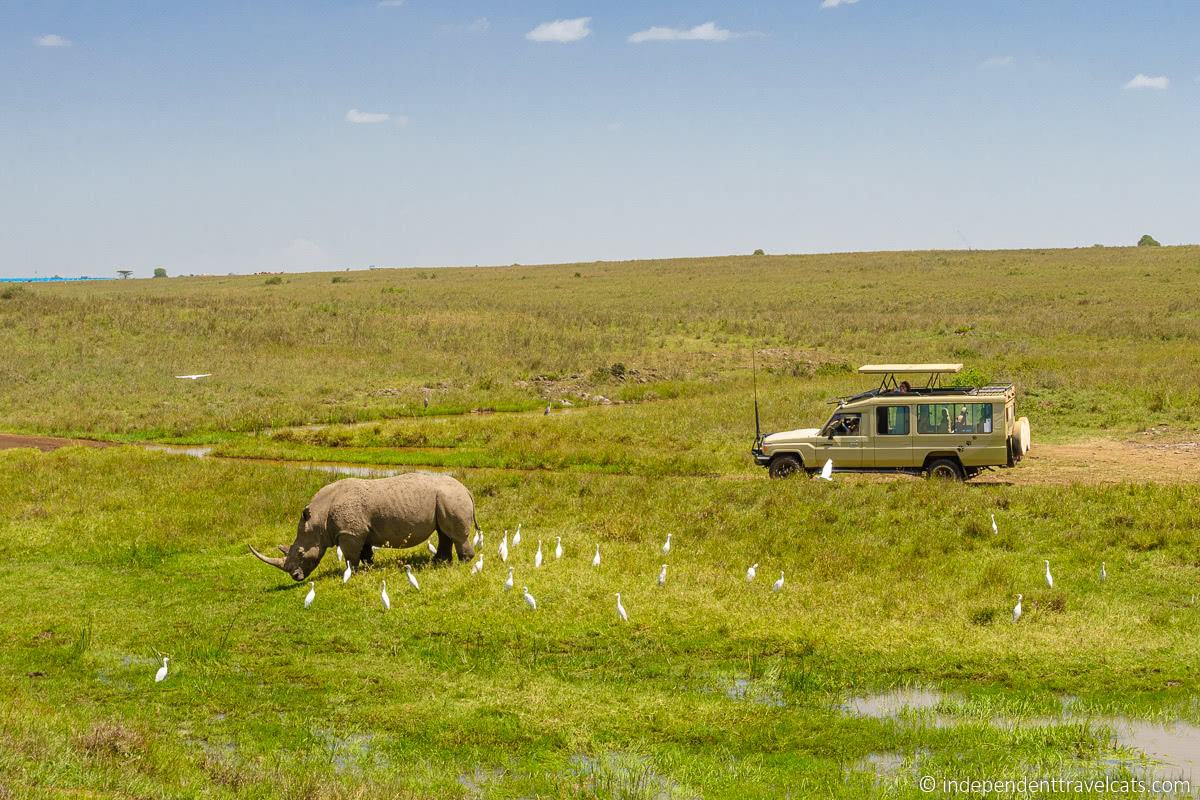
Giraffe Centre
The Giraffe Centre is an educational center run by the non-profit organization African Fund for Endangered Wildlife (AFEW). The AFEW was founded in 1979 by Jock and Betty Leslie-Melville to try to save the Rothschild’s giraffe through breeding, research, conservation, and education.
The Rothschild’s giraffe was the most endangered of the giraffe subspecies. At the time, there were only 130 of them left in Kenya and today there are over 300.
They started the program with a pair of young giraffes, Daisy and Marlon, who they brought to their home in the Lang’ata suburb of Nairobi. The center expanded and opened as an education center to the public in 1983.
As a visitor, you have an opportunity to get up close and feed the resident giraffes. I think there are currently about 10 giraffes here. They also have a family of warthogs you can see and feed as well that live with the giraffes.
After paying entry, you’ll be given a handful of pellets that you can feed to the giraffes while walking along a large viewing platform. The platforms are raised so that you are standing face-to-face with the adult giraffes and you can offer your pellets to the giraffes. They’ll eat them out of your hand. You’ll find that their tongues are wet and rough!
In addition to watching and feeding the giraffes and warthogs, we also recommend learning more about the giraffes by taking a look at the small exhibition and going to one of the free educational talks or lectures. These short talks about giraffes take place regularly in the small auditorium. If one is not happening, you can normally ask a staff member on the platform and say you are interested in one.
There is also a nature trail here that you can follow to see local plants, birds, and animals. It is located across the road from the Centre entrance and you can ask staff to point you in the right direction if you have any issues finding the starting point.
There is also a small tea room and a gift shop located on site. The center is normally open daily for public tours and visits from 9:00am – 5.00pm. You can check the latest opening hours and visitor fees here .
The Giraffe Centre is a popular stop to include on many group and private tours of Nairobi. it is easy to combine a visit here with a number of other attractions, including the Sheldrick Wildlife Trust Elephant Orphanage, Nairobi National Park, Bomas of Kenya, Utamaduni Shops, Kazuri Beads, and/or Karen Blixen Museum. If you are looking to join a tour, you can see a number of options here .
I’ve visited the Giraffe Centre twice and enjoyed my time here. Just be aware that this is a very popular stop for school groups (as is the Elephant Orphanage and Mamba Village) so it can get very busy here. I’d allow at least 30 minutes here if you just want to see and feed the giraffes, but I’d allow 1 hour to 1.5 hours if you also want to do the lecture and explore the nature trails.
If you really love giraffes and have a healthy lodging budget, you can also spend the night at the nearby Giraffe Manor and enjoy seeing giraffes on the front lawn. This is the former home of Jock and Betty Leslie-Melville that has been turned into a boutique hotel by the new owners.
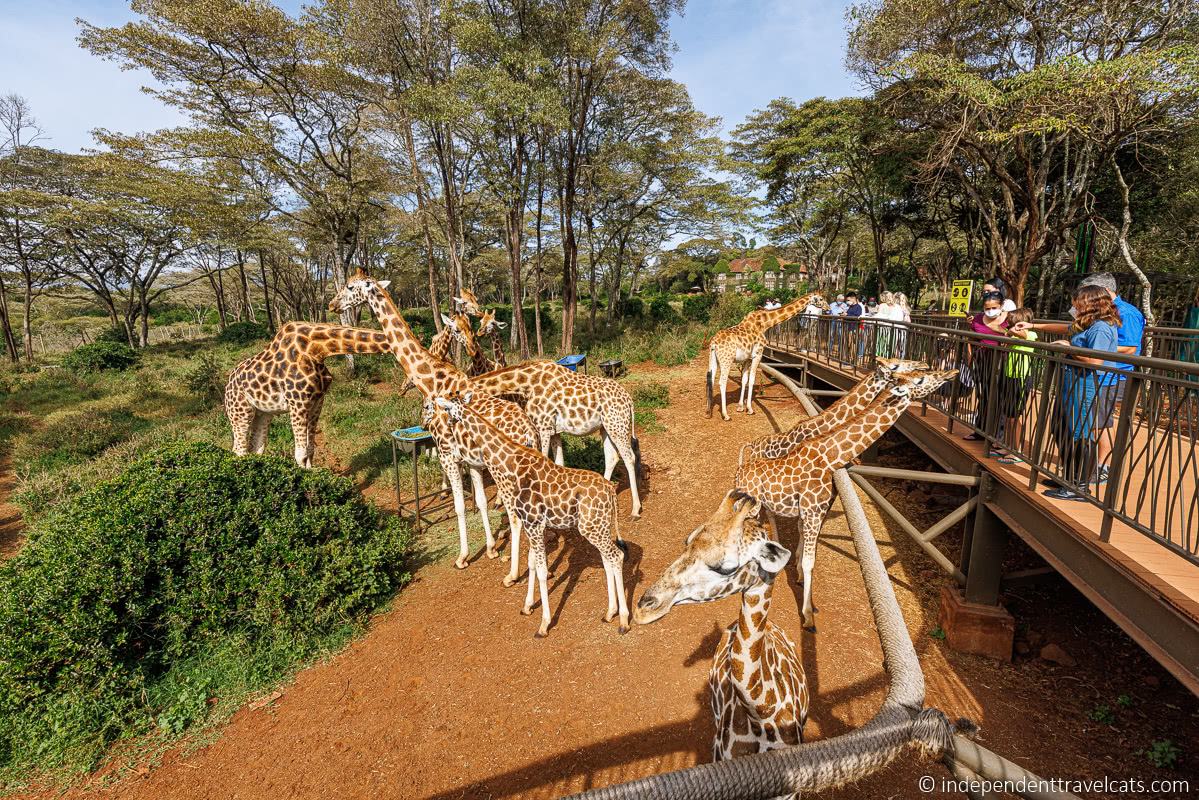
Sheldrick Wildlife Trust Elephant Orphanage
If you love baby elephants, then you definitely should plan a visit to the David Sheldrick Wildlife Trust Elephant Orphanage where you can see a number of baby elephants and learn about their care and the plight of elephants in Kenya.
Daphne and David Sheldrick were pioneer conservationists in Kenya and this wonderful elephant and rhino nursery and sanctuary was established in the 1970s. Located within a section of Nairobi National Park, the David Sheldrick Wildlife Trust provides care and a home to dozens of orphaned baby elephants and rhinos from all over the country with the goal of being able to release them back into the wild. Once the orphans reach a certain age and independence, they are moved to one of the three reintegration units to start the process of being released back into the wild.
Of course, the David Sheldrick Wildlife Trust does a lot more than run the Orphans’ Project. They are also involved in anti-poaching, aerial surveillance, providing veterinary care, community projects, education, and much more. While there is a focus on elephants and rhinos, the trust has projects that help wildlife of all kinds. Their goal is to “work to ensure a sustainable future for all wildlife, habitats, and communities.”
If you haven’t read Daphne Sheldrick’s memoir Love, Life and Elephants , I highly recommend reading it before your visit here. It is a great read and it will better help you understand the elephant orphanage, the Sheldricks, and the history of wildlife conservation in Kenya.
Visitors can visit the Elephant Orphanage daily at 11:00am to watch the public feedings of the young elephants and learn more about the mission of the trust. After parking, checking in, and paying, you follow a path to a large fenced dirt area. There are typically hundreds of visitors each day but the space is pretty large so you can still stake out a good view-point.
After a brief introduction, the first group of baby elephants are led in, these are the youngest of the elephants. You get to watch as they are fed bottles by the handlers, play in the water and dirt, and roam around the area. After the first group are led back to the stables, another group of older young elephants are led in and the feeding process is repeated.
During the feeding, a staff member with a microphone explains the goals of the trust and gives you some information about the individual resident baby elephants and rhinos. The baby black rhinos are not typically part of the visits.
We’d recommend wearing practical closed-toed shoes, sun protection (there is little shade here), and clothes that you would be OK with getting a little dirty. The elephants will sometimes come up and push against the ropes. You are allowed to touch them if they come close but you need to be careful as they weigh a ton. The elephants also love to splash around in the water and mud, especially the older ones. They also sometimes decide to spray mud all over visitors. One lady standing near us got covered in mud on our last visit. We experienced several small splashes.
The main reasons that elephants and rhinos become orphaned are poaching, habitat loss, natural causes, human conflicts, and drought. It is sad to hear about how elephant and rhino poaching is still a problem in Kenya (and many other African nations), mainly driven by Chinese demand for ivory and horn. Drought seems to be an ever-increasing reason as Kenya experiences prolonged periods of drought, which is causing both human and wildlife suffering across the country.
The cost of raising just one orphan elephant is ridiculously expensive. For those who want to contribute more to protecting the elephants, anyone can make a donation to adopt an orphan for a minimum annual donation of $50.00, which entitles donors to receive detailed information and monthly updates about their orphan. We adopted a little elephant named Roho on our last visit.
Our visit here was not only an amazing chance to get very close to a bunch of cute baby elephants, but also a good way to learn about and support a truly wonderful organization.
I’ve gone to the 11am morning visitor hour twice now, once in 2014 and once in 2022. I enjoyed both visits a lot. Both visits were similar in terms of the actual presentation and experience; however, there were a couple of clear differences. In 2014, no booking was required and there were hundreds of visitors. But in 2022, we needed to pre-book our visit, there were health protocols in place, and there were under 100 people in attendance because of number restrictions.
The morning public entry visits take place daily at 11:00am and last for 1 hour. You are asked to arrive by around 10:30am to pay the entry fee and be assured entry. You must also be sure to follow the protocols set for ensuring a safe visit.
Note that the 5pm visits for donors/adopters/foster parents were stopped due to the COVID-19 pandemic starting in March 2020. No date has been announced for when or if these visiting times will resume.
Visitors must make advanced bookings (at least 48 hours in advance is advised) and pay a donation on the day of the visit. The minimum donation for entry is currently 1,500 Ksh or $15 USD per person 12 years and above (this will change to $20 in June 2023), and Ksh 500 Ksh or $5 for children under 12 years of age. This is collected upon entry in either cash or via Mpesa (bring CASH, credit or debit cards will not be accepted!). You can see guidelines and make online bookings here .
During our last visit in 2022, several people were turned away for not booking in advance, not having cash to make payment, not having face masks (as required during our visit at that time), or showing up late. Please be sure to book in advance of your visit, read the guidelines, bring the correct cash, and arrive early.
Many people visit the Elephant Orphanage in Nairobi as part of a tour or with a driver. There are a lot of half day and full day tours that include a visit here, and you can check out tour options here . It is easy to combine a visit to the Elephant Orphanage with other places in western Nairobi including the Giraffe Centre, Bomas of Kenya, Nairobi National Park, or the Karen Blixen Museum.
Note that if you are booking a tour, the tour may or may not include pre-booked spaces and may or may not include the entry fee which is payable on the day of your visit. So be sure to check to ensure you are prepared.
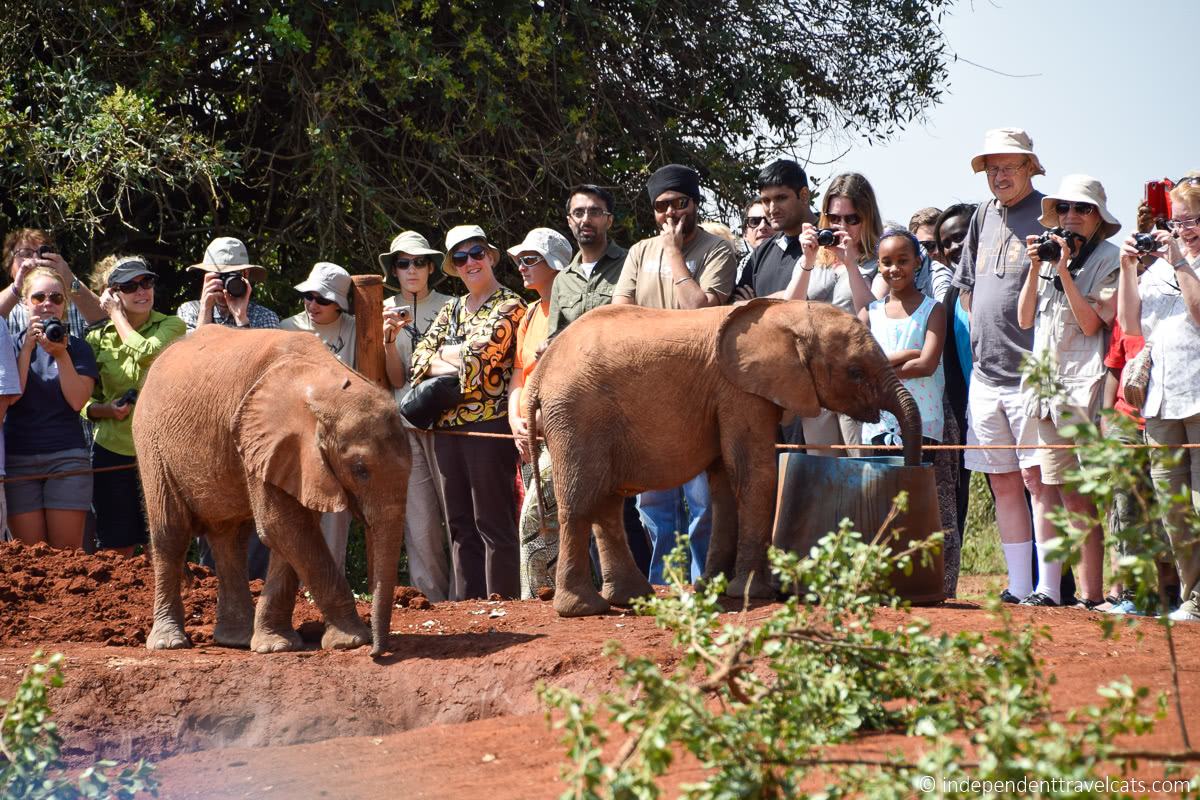
Utamaduni Shops
If you are only going to stop at one place to buy souvenirs and local goods, I’d probably recommend stopping at Utamaduni Shops , also known as Utamaduni Craft Centre. This place has a huge selection of crafts, jewelry, linens, soaps, masks, art, clothing, woodwork, accessories, children’s toys, games, beauty products, and much more.
The first time I visited this place it just had a few small craft and curio shops but it has grown a lot and now offers a bit of everything. There are a few shops located outside, but most of the items are inside now. I was pretty surprised at how big the indoor part of the shop has become.
They also offer a lot of items from other popular shops in Kenya, including a good selection of jewelry from Kazuri Beads. This makes Utamaduni a good one-stop place to get local goods and souvenirs if you have limited time. Prices are set and marked so you don’t need to bargain like at the markets and many of the souvenir shops.
There is also a nice cafe and restaurant here with an outdoor seating area where you can enjoy a meal or just a coffee. There is also a little play area for kids in the garden.
Utamaduni Shops is located in the Langata area of Nairobi and is a convenient place to stop if you are in this area visiting places like the Giraffe Centre, Sheldrick Wildlife Trust Elephant Orphanage, and the Karen Blixen Museum.
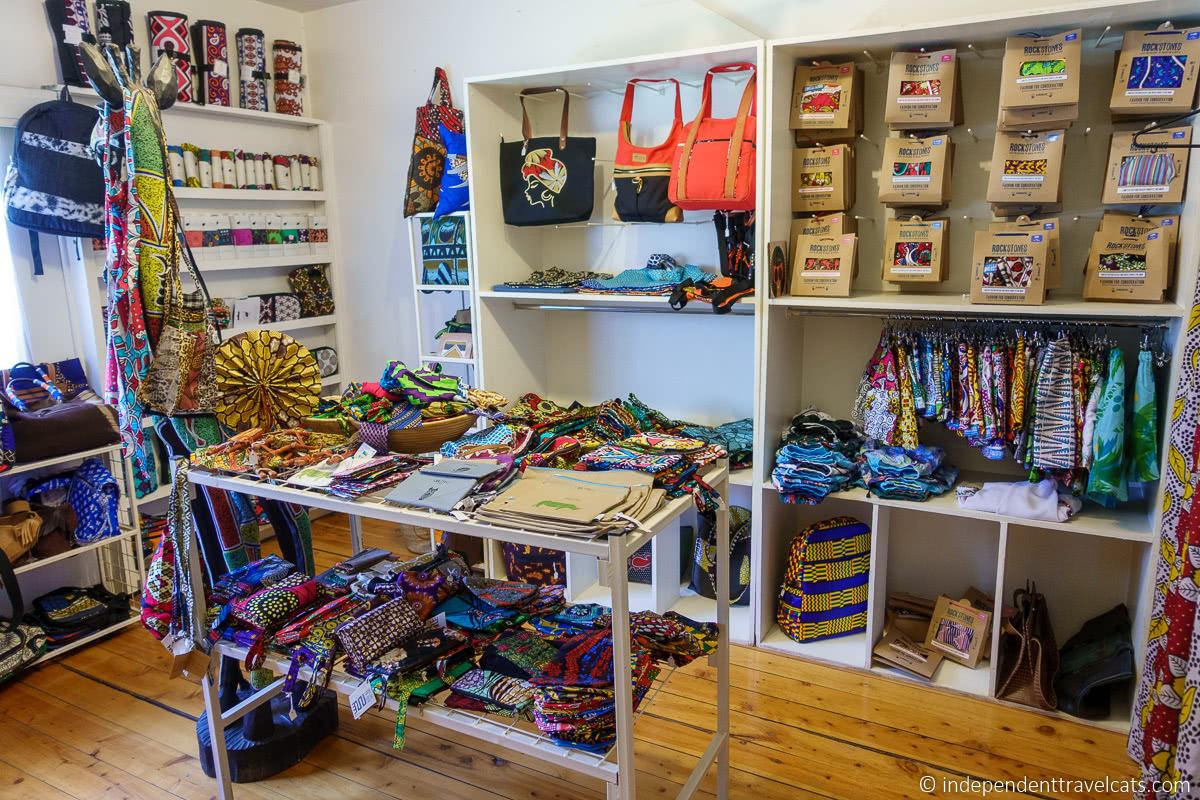
Carnivore Restaurant
Carnivore is by far the most well-known restaurant in Nairobi and has become a popular tourist destination. It was opened in Nairobi in 1980 and offers an all-you-can-eat menu that is focused on roasted meats.
The restaurant became famous for serving some pretty unusual and exotic wild game meats, but because wild game meat has since been outlawed in Kenya, all meat served here is now farmed. So you’ll be offered typical meats like steak, leg of lamb, pork, and chicken, but there are also more unusual meats on offer like ostrich, crocodile, and bull testicles.
Carnivore has an unusual open-air setting with a large charcoal fire pit at one end of the restaurant. After you are seated, you are first served soup and bread. Then comes a tiered platter with a number of different salads and sauces. They also bring you a baked potato each. Then carvers bring around different meats skewed on Maasai swords on a rotating basis to your table. You can continue to eat for as long as you want.
Once you are finished eating, you are asked to admit defeat by lowering a white paper flag at your table. If you are capable of still eating more, you are then served dessert. I believe we had a choice from three different dessert options.
Everything is included in your meal price except your drinks. They offer a variety of soft drinks and alcoholic drinks. The specialty drink at the restaurant is the Dawa, a vodka cocktail invented here and popular across Kenya.
We enjoyed having dinner here and all the food was good except the bull testicles, neither of us could eat those. The ostrich meatballs were a favorite. Just keep in mind that this is a very popular tourist restaurant, with local travelers, international travelers, and tour groups so it is a busy place. We were surprised to see a lot of Kenyans eating here as well. Don’t come here for an intimate meal.
This is a place I’d recommend to meat eaters but not vegetarians. Apparently, there is a vegetarian menu option; however, given the focus on meats here I doubt many vegetarians or vegans are likely to have this restaurant on their itinerary.
The restaurant is located in the Langata area on the same grounds as the Tamarind Tree Hotel . It is open for both lunch and dinner. You can make reservations and we did so. However, it is a big place and normally reservations are not required unless you are part of a large group.
Also located here is the Simba Saloon nightclub and bar which operates on certain nights of the week offering live music. There are often themed musical nights at the nightclub.
A meal at the Carnivore is included in a number of popular tours of Nairobi such as this one which includes lunch at Carnivore and visits the Giraffe Centre and David Sheldrick Wildlife Trust Elephant Orphanage. If you don’t have transportation, there are also a number of options you can book that include pick up at your hotel, your meal, and drop-off back at your hotel.
If you are looking for an alternative to Carnivore, this evening tour might be an option. It includes a dinner buffet at a local hotel focused on nyama choma and a 1 hour dance and acrobatics performance. This place attracts more Kenyans than Carnivore.
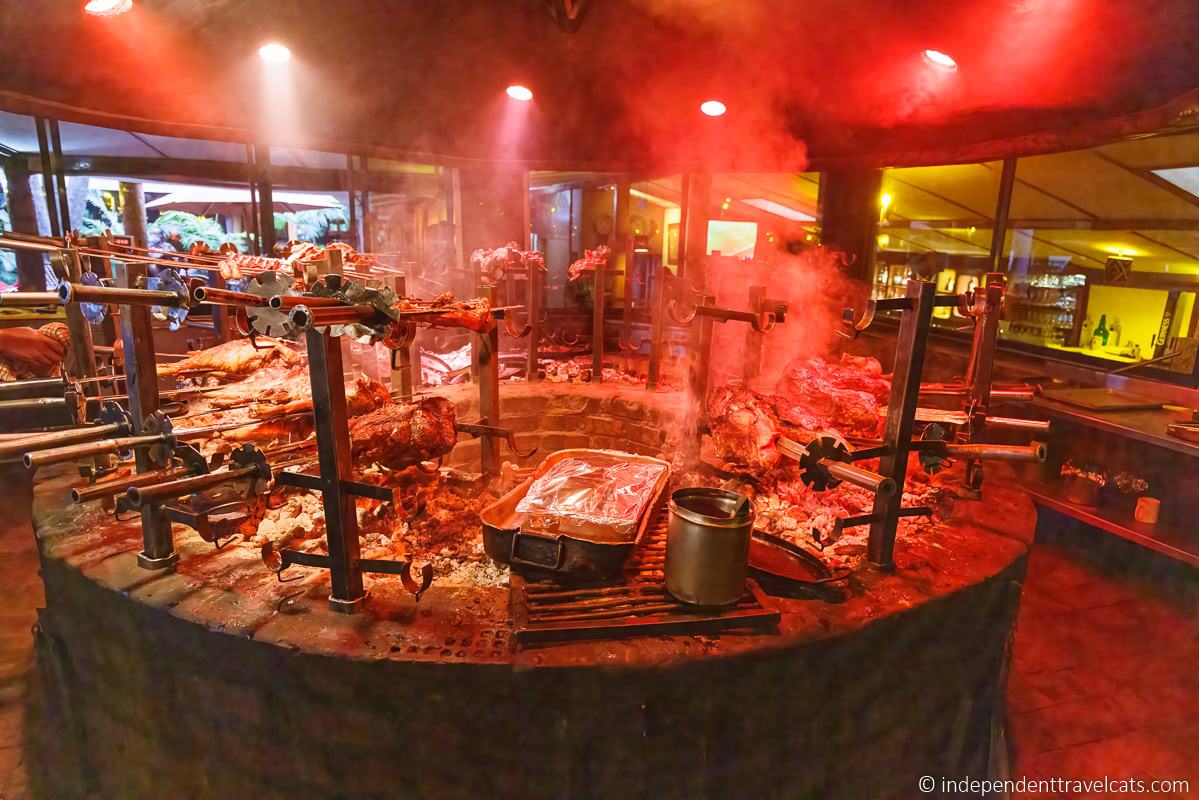
Go Shopping in Nairobi
If you want to shop in Kenya, there is no place better to go shopping than Kenya’s capital city. You have a wide range of shopping options in Nairobi from local craft markets to luxury boutiques. There are shopping malls, local markets, and souvenir and craft shops.
You can easily shop on your own, but if you need transport or feel intimidated by the markets you can also join a guided shopping tour of Nairobi that visits several shops and markets.
Nairobi Markets
There are lots of open-air and indoor markets in Nairobi. Some are formal markets and some are more informal roadside ones. Some markets have a bit of everything but others are focused on something such as fresh fruits and vegetables, secondhand clothing, or curios.
Some of the larger markets in Nairobi are Kariokor Market, City Market (mostly indoor), Gikomba Market (mostly secondhand clothing and accessories), Muthurwa Market, Toi Market, and Kenyatta Market. Some of the markets have Facebook pages or websites, but if not, you can ask a local about where and when to go.
You also have the popular Maasai Markets which are more geared to tourists and mostly carry things like art, crafts, and souvenirs. You can visit a Maasai Market on most days of the week but it moves to different locations. The biggest one in the city center happens each Saturday. See section on the Maasai Markets for more information.
At the markets, streetside vendors, and Maasai markets, haggling or bargaining is common and prices are often not set or marked. So be prepared to haggle on the prices for most goods.
Nairobi Shopping Centers
If you are looking for general shopping, there are a lot of shopping malls and shopping centers in Nairobi, including Yaya Centre, Westgate Shopping Centre, Sarit Centre, Village Market, Prestige Plaza, and The Junction Mall. Most are located in the wealthier suburban areas. Not only do these have a lot of stores and restaurants, but they also usually have supermarkets, banks, salons, pharmacies, movie theaters, and phone services as well.
If you spend any longer amount of time in Nairobi, you will almost inevitably end up at one of the city’s shopping malls whether you need clothes, a SIM card, a haircut, groceries, or money.
We’ve been to three or four shopping malls in Nairobi. These are easy places to shop and are very much like Western shopping malls with lots of stores under one roof, set prices, and security. So a great place for hassle-free shopping if you can’t handle the markets.
But I wouldn’t head to the Nairobi shopping centers expecting bargains. We were surprised by some of the prices in these stores, especially those selling imported clothing and goods. These malls mostly cater to wealthy locals and expats and prices were often similar or higher than what you’d pay in the USA or Europe.
Nairobi Craft & Souvenir Shops
If you are looking for local crafts and souvenir shopping, our top recommendation for a one-stop shopping destination is Utamaduni Shops located in western Nairobi. This place sells lots of crafts and souvenirs and has an onsite cafe. See our section on Utamaduni Shops for more info on visiting here.
Another great option is Spinner’s Web located in northern Nairobi. Spinner’s Web is a great place to go if looking for higher-end crafts and souvenirs from local vendors. They sell handicrafts, pottery, home decor, jewelry, art, fashion accessories, and more. They also have a cafe.
All prices are set at both Utamaduni and Spinner’s Web so no haggling is necessary. We have experienced good customer service at these shops. While you can of course find some of these items for sale at the city markets or other shops, these are convenient places to find them all together and not worry about haggling on prices.
Utamaduni is well-located for those visiting attractions around Lang’ata and Karen. Spinner’s Web is well-located for those staying in the Westlands or northern Nairobi suburbs.

Visit the KICC Rooftop
If you are looking for a view over Nairobi, then we recommend heading to the rooftop of the Kenyatta International Conference Centre (KICC). The KICC is a 28-storey conference center located in the CBD.
The center was officially opened in 1973 and was designed by Norwegian architect Karl Henrik Nøstvik and Kenyan David Mutiso. The building was significant for its design, size, and its use of eco-friendly and locally available materials. At the time, it was the tallest building in Nairobi and one of the largest venues in eastern Africa.
The KICC is no longer the tallest building in Nairobi. The UAP Old Mutual Tower is currently the tallest building in Nairobi and while it does have an observation deck, we don’t think that it is currently open to public visitation.
The KICC is still a leading conference and meeting venue in Kenya. But it also attracts a number of tourists looking for great views from its rooftop. The rooftop is normally open to the public during the opening hours of the KICC, but can sometimes be closed for security reasons and private functions. There is a fee to visit the rooftop which was 500 Ksh when we visited in 2022. You can find out more about current fees and rules here .
To visit the KICC building you need to go through an airport-like security check at the gate entrance. Be sure to bring your passport or photo identification. You can then walk into the building itself.
Once inside the KICC building, you will want to buy a ticket at the Reception Desk for visiting the rooftop. A staff member will then take you to the correct elevator and push in the appropriate floor (or in some cases accompany you to the top). The elevator will take you up most of the way, but you will then need to climb several more flights of stairs to reach the very top.
Be sure to buy your ticket before entering the elevator and to keep your ticket as you will likely be asked for proof of a ticket by security in the stairway or on the roof.
On the rooftop, you will have a great 360-degree view of the Nairobi skyline. There is also a helipad located here on the rooftop. On the clearest days, you may be able to see Mount Kenya and even Mt. Kilimanjaro in the distance!
I’d allow at least 1 hour to visit the KICC rooftop. Although the rooftop is fairly small and can be visited rather quickly, security and getting to and from the rooftop can take longer than expected.
A number of tours of Nairobi that include the CBD area of Nairobi visit the KICC rooftop. You can see a list of guided tour options here .

Nairobi Railway Museum
The Nairobi Railway Museum is a museum run by Kenya Railways that focuses on the history of the railway in Kenya and how the railway shaped the development of Kenya. This museum was opened in 1971 and is a great place to visit for anyone interested in trains or the early history of Nairobi.
The railway played a significant role in the founding and early history of Nairobi. The city was originally just a rail depot set up for the Uganda Railway by the British in 1899. The area around the city was mostly uninhabited swampland but the city quickly grew and it became a major administrative hub. By 1907, Nairobi would replace Mombasa as the capital of Kenya.
In the museum, there is a posted quote by a senior British administrator, Sir Charles Elliot, in 1903: “It is not uncommon for a country to create a railway, but is uncommon for a railway to create a country.”
The museum has both an indoor part and outdoor exhibit area you can visit. The main indoor area details the history of the railway in Kenya from the 19th century to the present and showcases a number of railway and train artifacts, from maps to early push trolleys to claws from the man-eating lions of Tsavo to furniture and objects used by Queen Elizabeth II.
There is also one room that focuses on ships and water transport with a number of ship models. There is a focus on the World War I German cruiser Konigsberg as the museum has several artifacts from the shipwreck.
Outside, you can walk around and see a number of outdoor exhibits that includes various historic train locomotives, coaches, and other rolling stock. This includes the train carriage where the Railway Police Superintendent Charles Ryall was attacked and killed by the man-eating lions of Tsavo during the building of the Uganda Railway (“Lunatic Line”) and a steam locomotive used in the film Out of Africa . Some of the train exhibits are open and you can climb inside for a closer look.
There is also a small art gallery that you could visit and buy local art and souvenirs. There is also a children’s playground area and a mini-train that is sometimes operated for children; however, this area was closed during our last visit.
The Nairobi Railway Museum was probably our favorite museum in Nairobi as it is a nice compact size and we both like trains. The interior galleries are well-labeled in English and the staff were helpful when we had questions; however, many of the outdoor exhibits had minimal signs and information.
The museum is located on Workshop Road off Haile Selassie Avenue near the Kenya Railways headquarters. It is in central Nairobi just south of the CBD area. We did have some issues finding and getting to the museum entrance as our taxi driver dropped us off in the wrong place. We also had to walk through a fenced security area when on foot to reach the museum and sign in and out with passes. But we were guided in the right direction by asking railway staff and guards.
The museum is normally open daily from 8:00am to 5:00pm. There is an entrance fee to visit. You can find out more information by visiting the museum’s Facebook page .
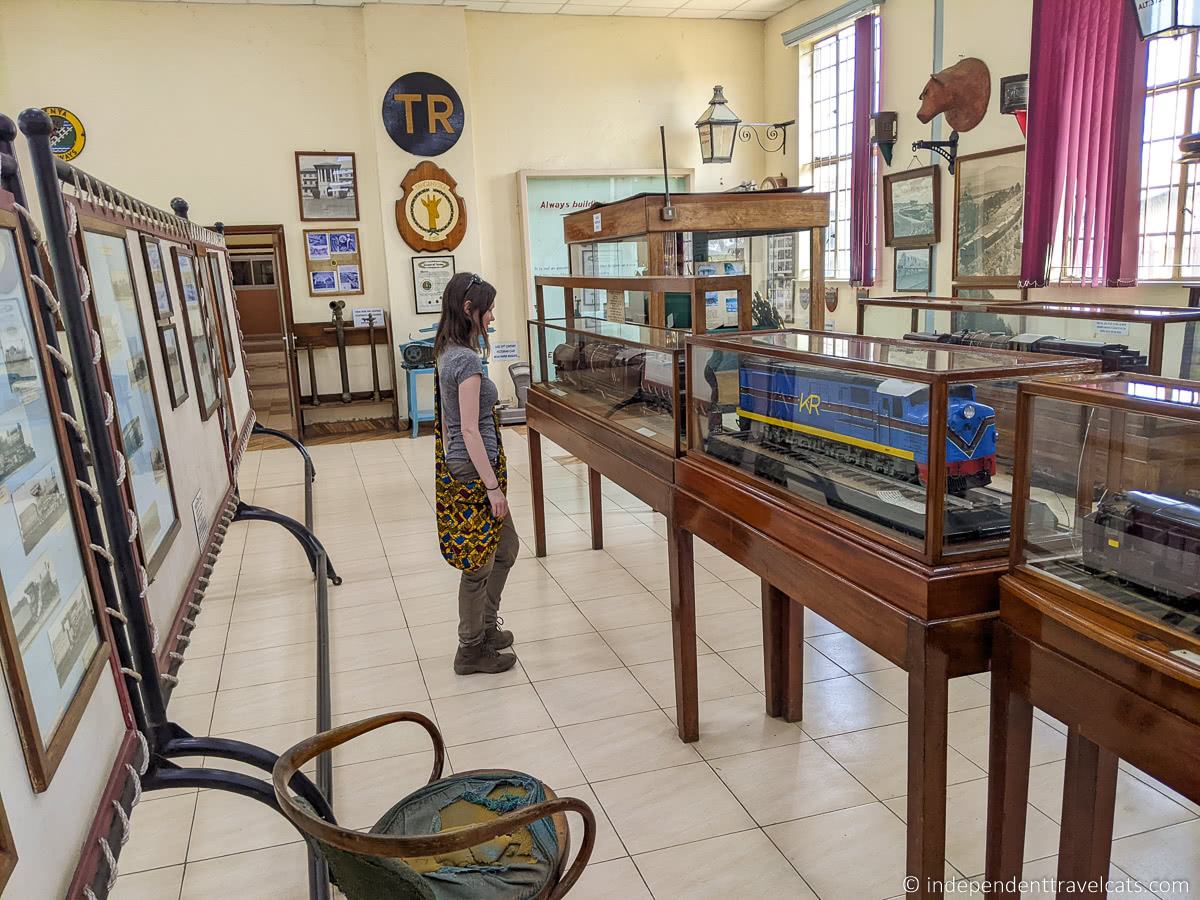
Nairobi Gallery
The Nairobi Gallery is the main art gallery in Nairobi and it focuses on showcasing African art. It is located in central Nairobi near both Uhuru Park and Central Park. In fact, the gallery is located in the exact center as the atrium of the building was used as Point Zero from which the colonial government measured all distances in Kenya.
The building itself is interesting. It was originally built as the Ministry of Native Affairs in 1913. After independence, it became the Provisional Commissioner’s Office. The building was declared a national monument in 1995 and then given to the National Museums of Kenya. After a long renovation period, it was opened to the public as the Nairobi Gallery.
The main collection on display is made up of objects collected by the late Joeseph Murumbi and his British wife Sheila. Joseph Murumbi was a Kenyan politician and the second Vice-President of Kenya, and Sheila was a librarian and passionate collector. The couple amassed a large collection of art, postage stamps, jewelry, African artifacts, books, and other objects. They were co-founders along with Alan Donovan of Africa Heritage Gallery, Africa’s first Pan African gallery which operated globally from 1973 to 2003.
There are 6 main rooms within the gallery. The museum displays an eclectic mix of art and artifacts which includes sculptures, paintings, masks, currency, stamps, weapons, books, textiles, jewelry, photos, furniture, household objects, and more. Also on display are personal items, furniture, and photos of Joseph and Sheila Murumbi.
Parts of the Nairobi Gallery are used to display rotating temporary exhibits of contemporary African art. Some local art and children’s art was also available for purchase. When we visited, there was also a temporary exhibition dedicated to tribal related issues and violence during past elections. The exhibit shared stories from people across Kenya with the goal of promoting peace and fostering cooperation to solve future problems.
We really enjoyed our visit here and would recommend it to anyone interested in both art and African history and culture. Although full of objects, the museum isn’t too big so it’s easy to explore if you just have one or two hours. There is also a tea room on site where you can get coffee, tea, and snacks.
The museum is generally open daily from 8:30am to 5:30pm. There is a fee to visit.
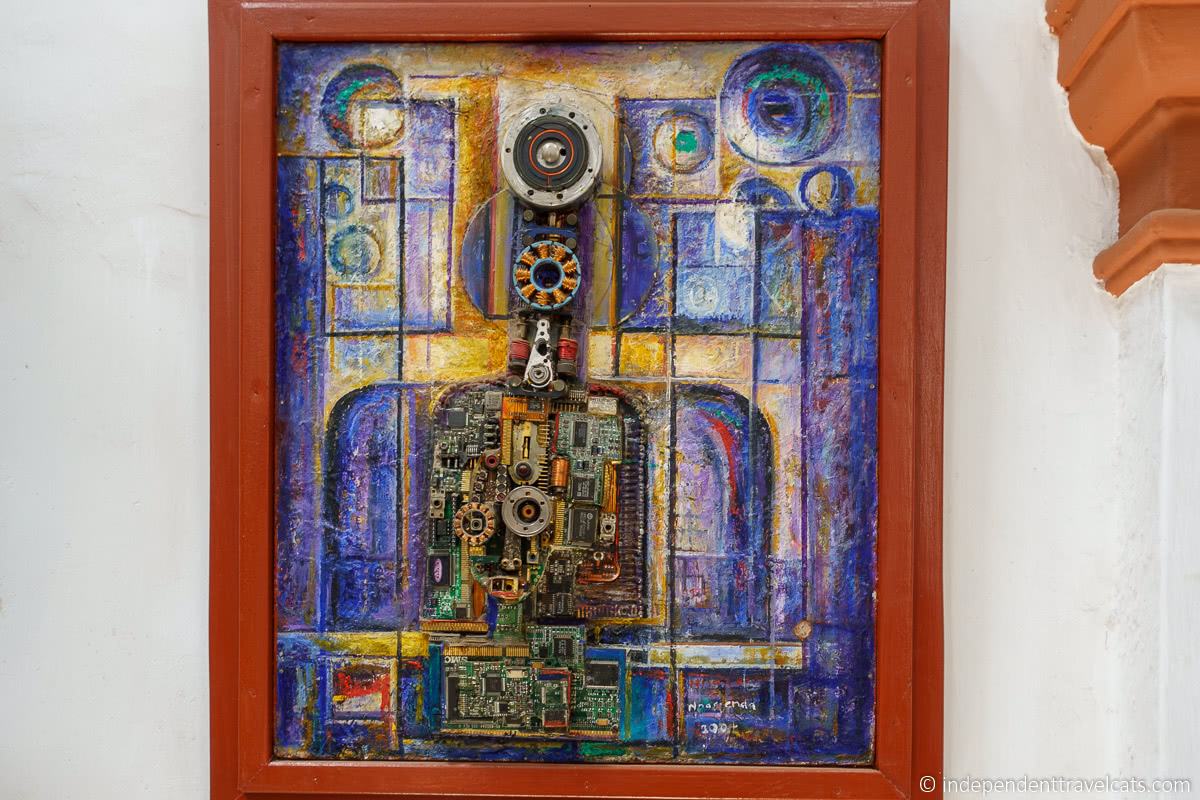
Nairobi City Parks & Gardens
One of Nairobi’s nicknames is “The Green City in the Sun”. Nairobi offers a national park, forests, and a number of city parks and gardens. In this section, we’ll focus on the city’s public parks and gardens.
Nairobi has a number of public green spaces that you can visit, including several within the city center. They are popular places for locals to meet, play, picnic, commune with nature, and enjoy some downtime. They can also be a great place for you to enjoy when you need a break.
Just be vigilant and careful when visiting any of the public parks as they can be an area where pickpockets and thieves are operating. You may want to read recent reviews. We haven’t personally had any issues during the day, but I would recommend avoiding them at night.
The majority of Nairobi’s parks are open to the public and free to visit. However, there may be charges for parking or using specific facilities (toilets, picnic facilities, sports areas) within the park. The parks are normally open to visitors daily during daylight hours.
Note: When we last visited Nairobi in early 2022, parts of Uhuru Park, Central Park, and Uhuru Gardens were all closed for major renovations. So be sure to check before setting out to visit.
Here are some of the major parks and gardens located within Nairobi that you may want to visit:
Uhuru Park is a 32-acre green space in Nairobi’s center and the most popular park in the city. The park has been the site of a number of celebrations and protests. It contains gardens, lawns, trees, a fountain, a Mau Mau memorial monument, and an artificial lake. There are places to get food here as well as take boat rides on the lake.
Central Park
Central Park is located adjacent to Uhuru Park (the two are just separated by a road) in the CBD and is another large green space composed of lawns, gardens, shade trees, and a children’s playground. One of the main landmarks in the park is the Nyayo Monument, a large monument to celebrate former President Moi that was built in 1988.
Jeevanjee Gardens
Jeevanjee Gardens is another smaller green space located in the city center. It was gifted to the citizens of Nairobi by Indian-born Kenyan merchant Alibhai Mulla Jeevanjee in 1903. There is a statue of Jeevanjee in the park.
August 7th Memorial Garden
The August 7th Memorial Garden, also known as the American Embassy Memorial Garden, is a memorial garden located on the former site of the United States Embassy that was destroyed by terrorist bombings on August 7, 1998. The blast killed 218 people (I believe 206 Kenyans and 12 Americans) and injured thousands of others. It is a lovely walled garden with a memorial wall and a small museum.
Unlike the others on this list, there is a small entrance fee to visit the gardens and Peace Memorial Museum. You can find out more about visiting the memorial park here .
City Park is a large 60-hectare public park located in the Parklands area of Nairobi, north of the CBD. The park was first established in 1921 and became a protected area in 2009. It offers nature trails, lawns, picnic areas, a plant nursery, a sculpture garden, and a memorial garden. There is also a restaurant located within the park.
The park has a diverse collection of trees, plants, and wildlife, including portions of intact indigenous forest and a large population of Sykes’ monkeys. There is also a cemetery here where notable people such as Joseph Murumbi (Kenya’s second vice president) and Pio Gama Pinto (Kenyan journalist and politician) are buried.
Museum Botanical Gardens
These lovely botanical gardens are located within the grounds of the National Museum of Kenya. They showcase a number of plants found throughout Kenya and there are different themed areas throughout the garden.
There is also a nature trail here that goes along the Nairobi River. These gardens are free to visit. This is a great garden to visit before or after visiting the National Museum of Kenya.
Uhuru Gardens
Uhuru Gardens is a large memorial park located in western Nairobi in the Langata area. The grounds have historical significance as it is where the first Kenyan flag was raised on December 12, 1963 (Kenya’s Independence Day) and is considered the birthplace of modern Kenya. The gardens were officially declared a National Monument in 1966.
Within the park are a number of memorials and monuments related to Kenyan independence and freedom fighters. A fig tree ( mugumo tree) was planted by President Jomo Kenyatta on the spot where the British flag was brought down and Kenya’s national flag was first hoisted. In recent years, it has become the site of national Jamhuri Day and Madaraka Day celebrations.
This park is currently undergoing major renovations and there are plans by the current government to set up a museum, shopping complex, convention center, hotel, and other attractions within Uhuru Gardens.
Although then President Kenyatta “officially opened” the Uhuru Gardens National Monument & Museum on July 25, 2022, as far as I am aware this museum is still not finished or open to the public yet. So do check before planning a visit (and do leave us a comment to let me know if it has finally opened!).
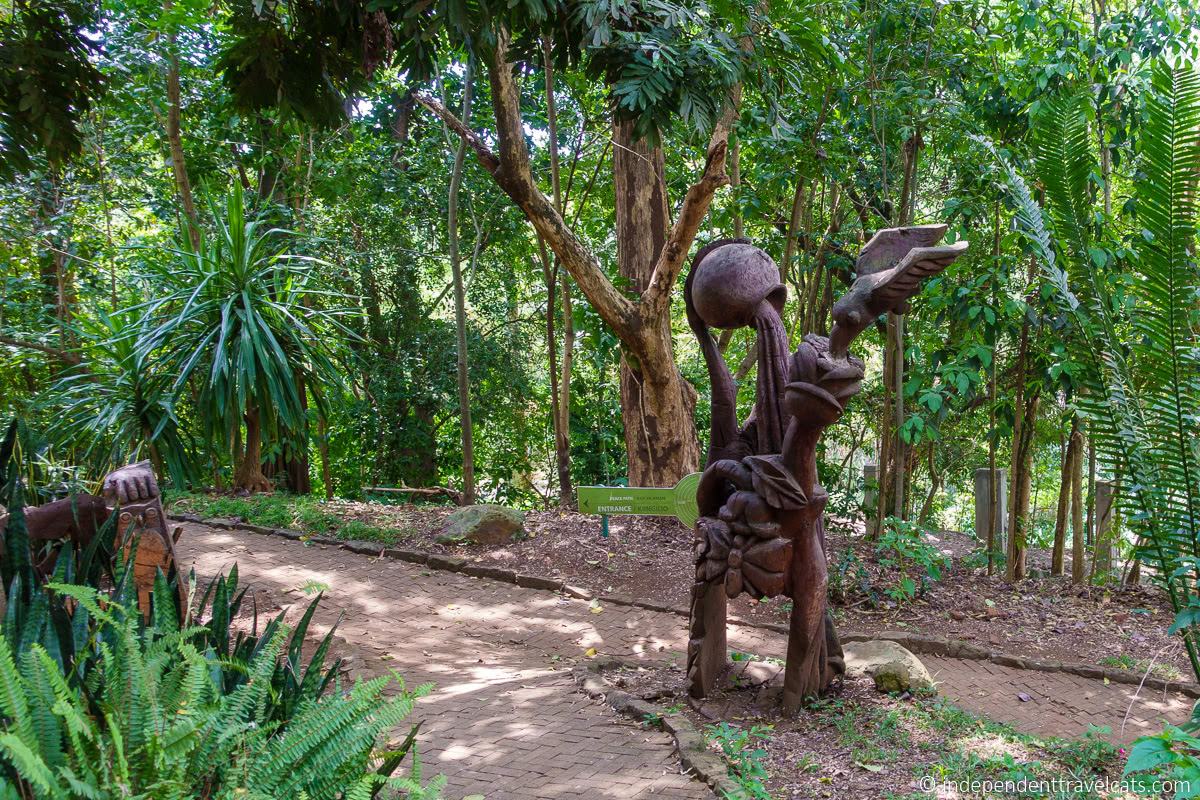
Maasai Markets
The Maasai Markets are probably the most popular markets for tourists to Nairobi to visit. The markets are made up of a number of individual vendors selling their wares. At the markets you will find crafts, art, carvings, clothing, jewelry, fashion accessories, woven baskets, souvenirs, and more.
The Maasai Markets are normally held every day of the week except on Mondays. But they are held in different locations, depending on the day. They are normally held from 9:00am to 6:00pm. You can check the Maasai Market Facebook page which has a lists of the market locations by day.
The last updated schedule of Maasai Market locations and days provided says:
- Monday – no regular markets
- Tuesday – Kijabe Street Park next to Nairobi River & Prestige Plaza along Ngong Road
- Wednesday – Capital Centre along Mombasa Road
- Thursday – The Junction Mall & along Ngong Road
- Friday – The Village Market in Gigiri & Lavington Mall
- Saturday -The High Court parking in the city center & Prestige Plaza
- Sunday -Yaya Centre
However, I would recommend confirming the market location and day before planning a special trip as they do sometimes change locations or are closed for one reason or another. For instance, the COVID-19 pandemic caused a lot of disruption in the markets.
Probably the most popular is the Saturday market in the Nairobi city center located at the High Court parking area opposite Re-Insurance Plaza. This is a great location for those staying in or near the CBD. There is also a second Maasai Market held on Saturdays at Prestige Plaza located in the Kilimani area.
For the Maasai Markets at the Prestige Plaza in the Kilimani area, you can find out more on their website . They are normally held on both Tuesdays and Saturdays.
At the Maasai Markets you are expected to bargain and haggle on the prices. So it is generally not a good idea to accept the first offer. How far to go down and what to offer really depends on the offer, what it is, and how much you are willing to pay. Sometimes the first price we’ve been given is really ridiculous and other times it may be just a little high.
If you have time and are looking for a fairly common item like a beaded bracelet, scarf, or carved wooden elephant, I would go around to various stalls and ask for best prices. You’ll likely get a range of prices and it will help you come up with what is probably a fair price for the item. Then you can have a price in mind of what you are willing to spend.
Laurence hates the process of haggling and leaves it all to me in these situations. If you hate haggling and are unsure of what to offer in these types of situations, consider shopping with a local guide who can help do it for you. Or you can just avoid the markets and head to the fixed price shops instead (see our section on Utamaduni Shops).
If you need transport or want a guide you can consider this guided shopping tour (includes a number of shops and markets), this city tour which includes a visit to the Maasai Markets, or hiring a private driver guide. Just be sure to book the tour on a day when a Maasai Market is scheduled to take place!

Kibera Tour
Kibera is believed to be the largest urban slum in Africa, with an estimated population ranging from 200,000 to 1 million people, depending on the source. Many of the residents of this informal settlement live in poverty and much of the community lacks access to basics like clean water, electricity, and medical care. Unemployment, crime, disease, substance abuse, lack of educational opportunities, and hazards such as floods and fires are major issues here.
Kibera was a forested section of land on the outskirts of the city that was initially allocated as an area for Nubian soldiers by the colonial British government at the start of the 20th century. Kibera means forest in Kinubi. Later it became an area of settlement for rural migrants from different parts of Kenya who wanted to live and work in Nairobi. After Kenya became independent, much of the housing and settlements here were considered illegal.
Everything about Kibera, including its demographics, topography, land ownership issues, and infrastructure are complicated and often dynamic. Kibera is made up of a variety of informal settlements and villages, many divided by tribal affiliations. The government started a long-term clearance project in 2009, but this has brought about limited changes thus far.
It should be noted that although Kibera is the largest slum area in Nairobi, it is not the only one. A large number of people in Nairobi live in informal settlements. A comparison of Kibera with one of the wealthy suburbs such as Gigiri clearly illustrates the huge wealth gap and inequality between Nairobi’s poorest and wealthiest citizens.
The decision to visit Kibera as a tourist can be complicated. There are a lot of issues with so-called slum tourism or visiting impoverished areas as a tourist. There are, of course, safety issues and Kibera is generally a place that tourists are warned against visiting. But there are also ethical issues.
There are both pros and cons to visiting areas such as Kibera, and there is no right answer. Negative factors of slum tourism are that it can be voyeuristic, exploitative of the local people, and may benefit tour operators instead of the local community. Positive factors can be that it can be educational, increase income for local people, drive traffic to local businesses, and increase government investment.
If you decide to visit, we recommend doing so in the most respectful and ethical way you can. This includes choosing a responsible tour operator, visiting with a local guide, visiting on foot, following advice given by the guide, dressing modestly, not taking photographs or making videos of people without their consent, being respectful of people’s private spaces, and considering ways to support the local community (e.g., tips, donations, local purchases).
We don’t recommend visiting Kibera on your own for a number of safety and ethical reasons. A local guide can not only help guide you through this large informal settlement and help you feel more safe and comfortable, but a guide can also make the visit more informative, impactful, and educational.
When choosing a tour of Kibera, we recommend choosing a tour run and led by local residents, where some of the profits are used to help the community, and one that has good reviews. Two tours you might consider are this tour and this one . Both tours are led by Kibera residents and we were told some of the profits go to investing in projects in Kibera. Obviously, you can only do so much research on Kibera tours, but reading the reviews can help.
We chose to visit Kibera on a tour in 2022 after not visiting on prior visits as I was conflicted about doing so. I am glad we chose to do so as it was overall a positive experience and we learned a lot about Kibera.
We were picked up by two guides at a local shopping center as arranged, and then we went to Kibera by taking a matatu . Once in Kibera, we spent most of the time walking around the different parts, stopping to learn about different aspects of the settlement, its history, and what is happening today. We saw homes, businesses, a sports field, a hospital, the train tracks, and schools as we walked along. We had a lot of time to ask questions and our guides were happy to answer them.
At the end, we stopped at a school that is run by the Seed Foundation (who ran the tour), toured the school and learned about it and its struggle for resources. We also saw a brief song and dance performance by the older children. At the end of the tour, we got into a matatu with the guides and returned to the shopping center where we started.
We felt safe and comfortable throughout our tour. There is a lot of rubbish and open sewers so some areas can be a bit smelly. Locals seemed to pay little attention to us but were friendly when we spoke to them. Our tour did not include going into people’s homes or businesses (except the school) or any food, but some tours do this.
Kibera tours normally take place in the mornings, are between 3 and 5 hours in total, and involve a lot of walking. We recommend being prepared for a few hours of walking and wearing comfortable clothes and shoes that you don’t mind getting a little dirty. Leave your valuables at home. Bring water, sun protection, and cash for tips and any purchases.
If you are looking to see a different side of Nairobi, a Kibera tour is definitely something to consider doing on your visit. If you are looking for something similar but don’t want to head out to Kibera, this tour of the downtown is led by former street children and gives good insight into another side of Nairobi.
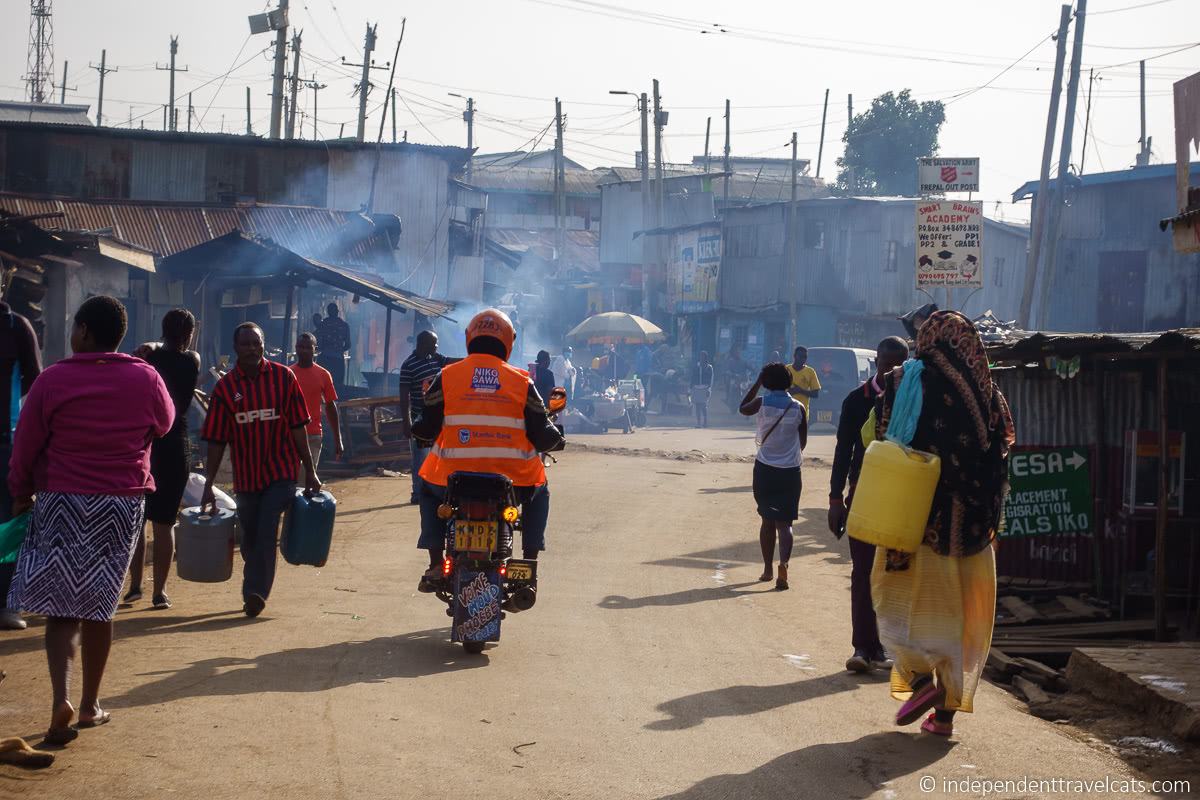
Government Buildings & Landmarks
If you do a city walking or driving tour of central Nairobi, you are likely to see a number of Nairobi’s government buildings as many of these serve as city landmarks. Many of these are important for architectural, historical, and/or cultural reasons. Many of these buildings can also be seen from the KICC rooftop (see section on the KICC), which is a good place to get a good view over the city.
Most of these landmarks are not open to tourist visits (without prior arrangement) with the exception of the gallery in the Kenya National Archives. The Archives is the only one that you’ll likely to actually visit, but you are likely to notice a number of these buildings.
Note that photography around many government buildings is prohibited. If in doubt, always check with an attendant or security guard. Some locations have signs posted but this is not always the case.
Here are a few of them, all located in the city center of Nairobi:
Parliament Buildings
The Parliament of Kenya is where the national legislative body of the government meets. Kenya has a bicameral legislature with two houses: the Senate (upper house) and The National Assembly (lower house). The buildings were constructed in 1954 and were designed in a similar style to the UK Parliament with a clock tower similar to the Elizabeth Tower (Big Ben) in London.
It is possible to get permission to visit the Parliament, but your visit must be arranged in advance. You can find out more here .
Mzee Jomo Kenyatta Mausoleum
The mausoleum, located next to the Parliament, is where the body of Kenya’s first president Mzee Jomo Kenyatta lies. He died on August 22, 1978 of a heart attack and his body was preserved and laid to rest here. There is a commemoration ceremony here at the mausoleum on August 22 each year.
The mausoleum is rarely open to the public without prior permission and is generally only open to local and foreign dignitaries. It is surrounded by fences and heavily guarded. We were walking outside and stopped outside the gate to look at it from afar and a guard came over to ask us to move on.
Kenya National Archives
The Kenya National Archives was established in 1965 and is located in the city center of Nairobi. In addition to holding the national archives (which require permission to visit), it also has a public gallery exhibiting African art and artifacts.
The gallery features an eclectic exhibition of art and objects from across Africa. Most of the objects were part of the large art and book collection owned by Joseph and Sheila Murumbi (part of their collection is also on display at the National Gallery).
The National Archives are definitely worth a quick visit to see the collection. I’d allow about 1 hour to visit. However, if you are trying to choose just one museum to visit while in Nairobi, I’d recommend the Nairobi National Museum over this one.
The Kenya National Archives gallery is open to the public and there is a small fee to visit the exhibition. It is normally open to the public from 8:00am to 5:00pm Monday to Saturday. The Archives are closed on Sundays.
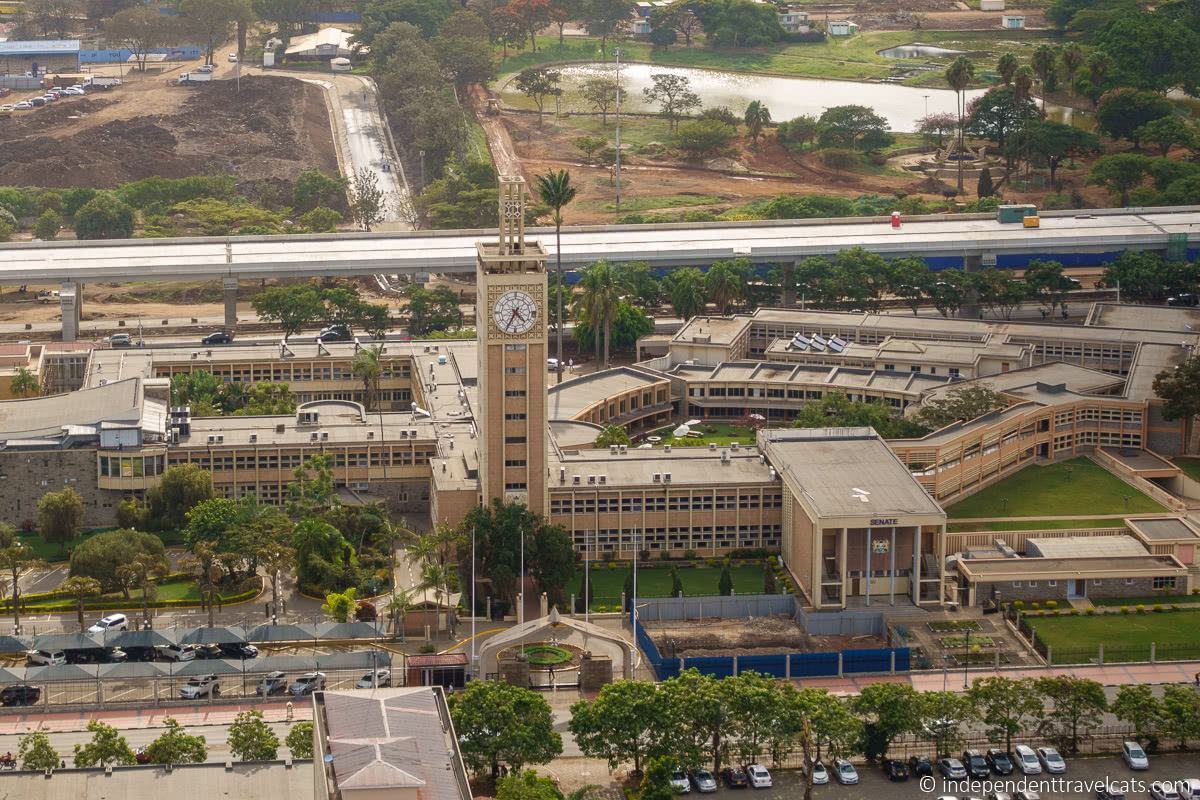
Religious Buildings
The majority of Kenyans identify as Christians with Islam being the second-largest religion in the country. In Nairobi, you’ll find many of the country’s important religious buildings for a number of faiths.
Note that some of the religious buildings in Nairobi are not open to public visits, but do welcome members of the faith who would like to pray or join religious services. So I would check ahead if you are interested in visiting or attending services at any of them.
Most religious buildings also have dress codes for visitors and worshippers. Many require modest clothing and some require head coverings.
Here are just a few of the more important religious buildings in Nairobi:
Holy Family Basilica
This Roman Catholic cathedral and basilica is dedicated to the Holy Family and is located in the CBD. The building dates back to 1904 and was the first stone building in Nairobi. It has expanded in size over the years. The interior was re-designed in the 1960s by architect Dorothy Hughes and features modernist styling and beautiful abstract stained glass windows.
The Holy Family Basilica is currently the seat of the Archdiocese of Nairobi and the largest church in Kenya.
All Saints’ Cathedral
The All Saints’ Cathedral is an Anglican cathedral located next to Uhuru Park in central Nairobi. Although the first Anglican service in Nairobi dates back to 1900, the current church building was only finished in the 1950s. It is the current home of the Archbishop of the Anglican Church of Kenya.
Jamia Mosque
The Jamia Mosque was completed in 1906 and was founded by Syed Maulana Abdullah Shah. It is the most known and important mosque in Kenya, and is often busy and full or worshippers. There is also an Islamic Centre and book shop located here.
Another important mosque is the Khoja Mosque which dates back to 1922. Both mosques are located in central Nairobi.
The Jamia Mosque normally welcomes visitors (subject to security screening) during regular hours. However, entry is sometimes restricted due to security or health (e.g., COVID-19 pandemic) issues.
East Africa Swaminarayan Satsang Temple
This Hindu temple was built in Nairobi in 1954 and is located in the Parklands area of Nairobi (north of the CBD). It was the first Swaminarayan temple to be built outside the Indian subcontinent.
Located nearby is another important Hindu temple in Nairobi, the BAPS Shri Swaminarayan Mandir. This impressive building was built in 1999 and was the first traditional stone and marble Hindu temple to be constructed in Africa.
Hindu temples are typically open to visitors during posted daily visitor hours. Be sure to check visitor hours and guidelines before visiting.
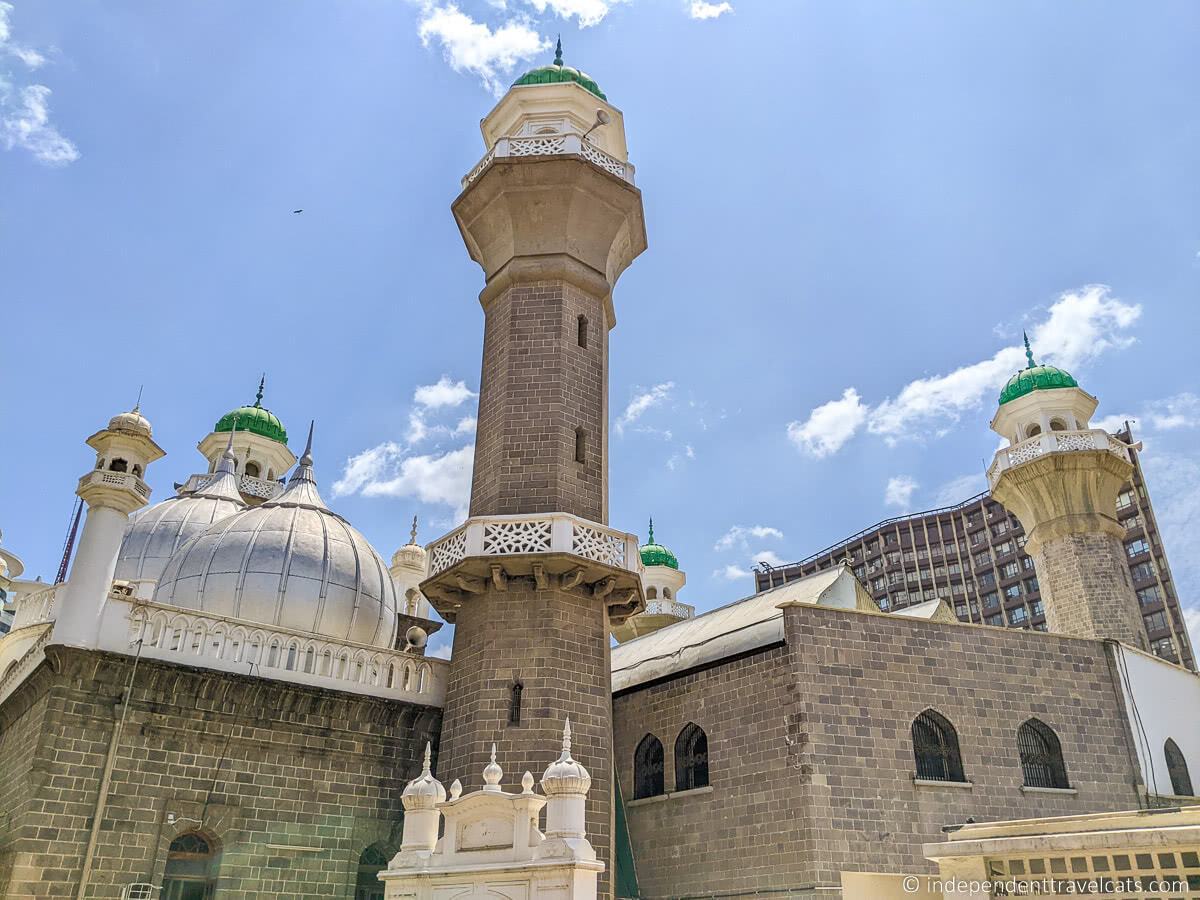
City Market
The City Market is an indoor market located in the center of Nairobi. So a great market to visit if looking for a market located within the CBD.
The City Market caters to both tourists and locals. On one side the City Market houses a number of vendors selling crafts, art, clothing, carvings, curios, souvenirs, etc. from individual stalls. You will want to bargain on prices here.
On the other side is an area where vendors are selling fresh meat, seafood, and other food and grocery offerings. The market is also a popular place to buy fresh flowers. There are also stalls selling cooked food, such as nyama choma (grilled meats).
The building itself is worth checking out for its architecture. It is one of the older buildings in Nairobi, built in the 1930’s in the Art Deco style, and has an interesting exterior and ceiling.
We enjoyed our visit here but you do need to be prepared for vendors coming up to you to try to lead you to their stalls and for haggling over prices. But you can find many of the same things offered at the Maasai Markets and craft markets here. Prices were low here when we visited as we were the only foreign visitors in the market at the time.
The market is located on Muindi Mbingu Street in downtown Nairobi. Since most of the stalls are covered and located inside the building, the City Market is a good market to visit no matter what the weather. The market’s main hours are usually 9:00am to 5pm Monday to Friday with an early noon closure on Saturdays. Most of the market is closed on Sundays.
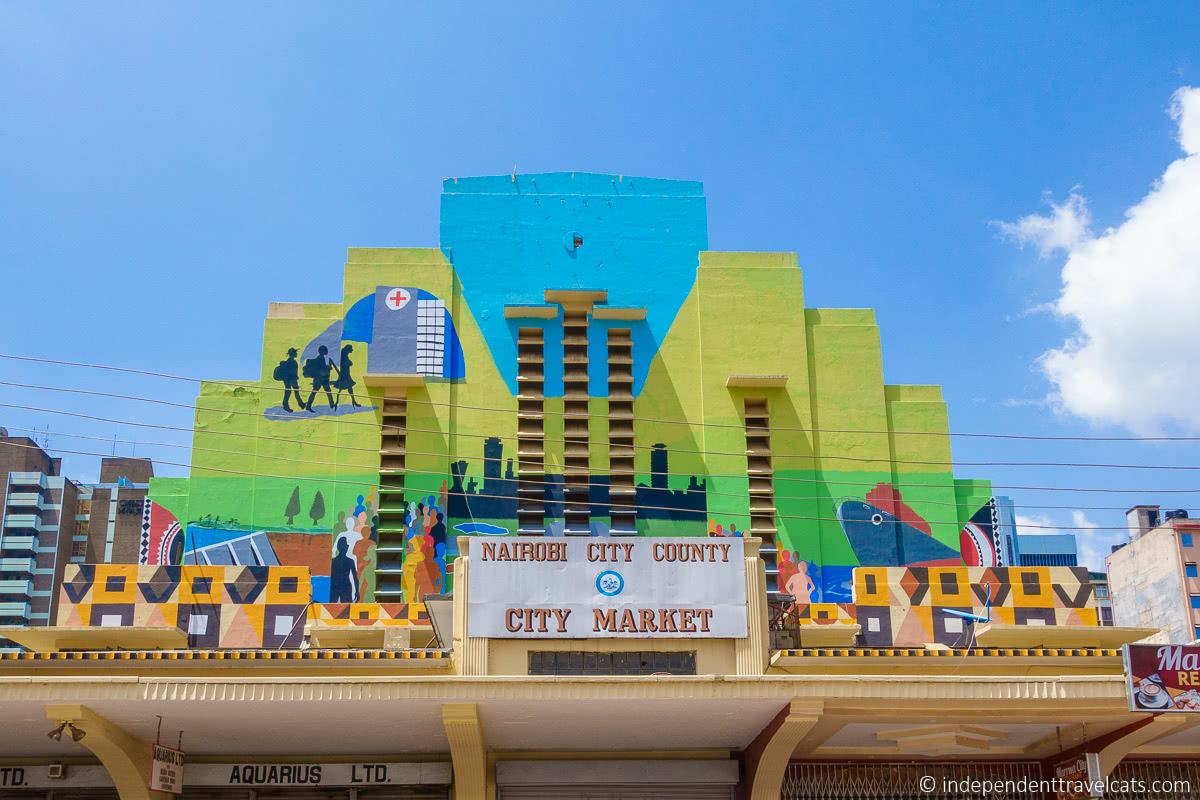
Thorn Tree Cafe
Located at the historic Stanley Hotel in central downtown Nairobi, this bistro-style café was the first “pavement café” in Nairobi. It is most famous for the large Naivasha thorn tree ( Acacia xanthophloea ) that once stood here that was used as a post office and message board. Travelers used to leave messages to others on the tree’s thorns.
You can still leave “tree mail” here but you need to pin it to a message board rather than the tree itself. The current tree, planted in 1997, is the third one that has been placed here. Not that there is not always paper, pins, and pens here, so you may want to come prepared with your note and a push pin if you really keen to leave a message.
The famous message tree served as the namesake for Lonely Planet’s online forum which was a popular place for travelers to ask questions, get information, and find travel companions since it was started in 1996. It was the longest-running and most popular online travel forum. Sadly, the Thorn Tree forums and travel community shut down in 2021.
Although the Thorn Tree Cafe is not a must-see place to visit in Nairobi, I wanted to include it in this article because of its historical significance among travelers. The cafe serves breakfast, lunch, and dinner. We particularly recommend it for lunch or as an afternoon coffee stop for those in the Central Business District. We last visited in 2022 and although service was a bit slow, our pizza and drinks were very good.
If you are looking for a nice hotel in the city center, we’d also recommend considering staying at The Stanley Hotel (currently the Sarova Stanley). It is the oldest hotel in Nairobi, dating back to 1902, and has a significant place in the history of Nairobi. Notable guests have included Ernest Hemingway, Winston Churchill, Clark Gable, Gregory Peck, Grace Kelly, and Sean Connery.
The hotel bar, The Exchange Bar, is also worth a visit if you are looking for a drink or cigar. This bar (originally known as the Long Bar) has had many famous patrons and was the first place that Tusker beer was served. Interestingly, it also served as the location for the first Nairobi Stock Exchange and stocks were traded here for many years.

Karen Blixen Museum
The Karen Blixen Museum is housed in the farmhouse where Danish author and coffee farmer Karen Blixen (pen name Isak Dinesen) lived from 1917 to 1931. The 19th-century bungalow-style house was built in 1912 by Swedish civil engineer Åke Sjögren. It was purchased in 1917 by Karen and her husband Baron Bror von Blixen Fincke. They bought a total of 4,500 acres of land for their farm and coffee plantation.
Neither Karen Blixen’s marriage nor her coffee plantation were successful. She was forced to declare bankruptcy and leave Kenya in 1931. She returned to Denmark and wrote several books, including Out of Africa in 1937 where she writes about her time spent in Kenya. The suburb around her former estate, Karen, is still named after her.
Her house eventually became the property of the Kenyan government after independence and was opened as a state museum in 1986, following the success of the film Out of Africa (1985), starring Robert Redford and Meryl Streep. The popularity of this film not only increased interest in Karen Blixen, but increased tourism to Kenya as a whole. Guided house tours are offered daily that detail the history of Blixen’s time here.
The tour includes a tour of the interior of the house, the detached kitchen, and a small portion of the grounds including some 20th century coffee farming equipment. The house includes some of the original furniture and other objects that belonged to Blixen, including her famous cuckoo clock. Although the house was not used in the filming of Out of Africa , some of the costumes and movie props are on display here.
The house has a lovely location and Blixen referred to the house as Bogani or Mbogani, meaning a house in the woods. If you are familiar with the first lines of Blixen’s novel “I had a farm in Africa, at the foot of the Ngong Hills”, you’ll be pleased to note that there are still some good views of the Ngong Hills from here.
The tour lasts about 40 to 45 minutes and then visitors are allowed to explore the grounds and the small gift shop on their own. Photography is not allowed inside the house.
I’ve visited the Karen Blixen house museum twice and both times the guides were very good at presenting information and answering questions. The house is interesting to see, especially if you have read the book as so many of the experiences Blixen wrote about happened inside this house or just outside of it. However, if you haven’t read the book or you are not a fan of Blixen, this is probably a place to skip.
The Karen Blixen Museum is generally open daily from 9:30am to 6:00pm. You want to allow at least an hour for the visit as the tours take about 45 minutes. But I’d say 1.5 hours is a good amount of time to allow for the guided tour and unhurried exploration of the grounds and gift shop.
A nearby spot to eat is the Karen Blixen Coffee Garden , which offers both indoor and outdoor dining. Also located here are two historic buildings, one is the Swedo House (the original farmhouse built on the coffee estate) and the Grogan MacMillan Manor House, which was owned by Karen’s friend Lady MacMillian. The outdoor seating area is great place for lunch.
A number of tours include a stop at the Karen Blixen Museum, such as this full day tour that also visits the Giraffe Centre, Elephant Orphanage, Kazuri Beads, and Karen Blixen Coffee Gardens. You can see some options here and here .
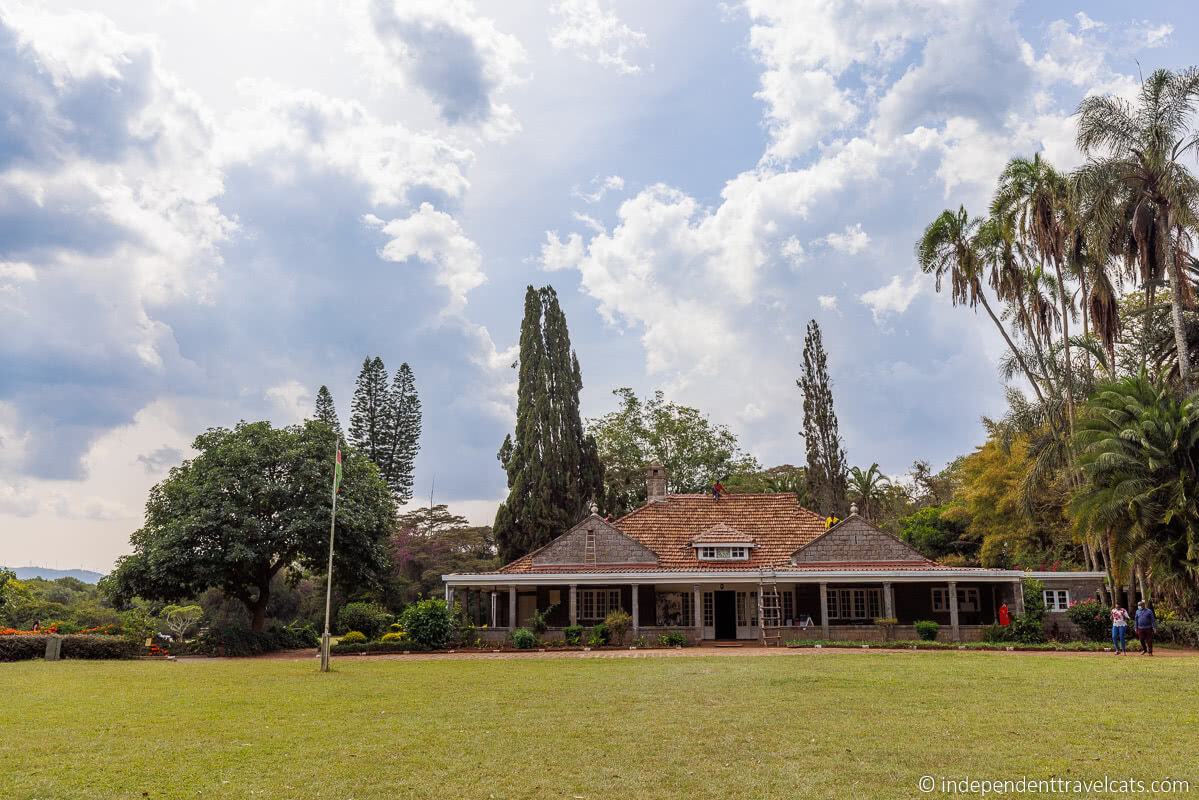
Kazuri Beads Factory & Shop
Kazuri Beads is a business that makes colorful handmade ceramic beads used for jewelry. It started in 1975 when Lady Susan Wood employed two local single mothers and taught them how to make ceramic beads. The word kazuri means “small and beautiful” in Swahili.
The ceramic bead business was successful and expanded, allowing for the employment of a larger number of single mothers and other disadvantaged workers. Today, over 300 women, many of them single mothers, work at Kazuri. The company sells wholesale handmade beads, bead jewelry, and handpainted pottery. The factory has been Fair Trade certified.
At Kazuri Beads you can do a free guided factory tour and visit their factory store. The factory tour takes you through the whole process of how the ceramic beads and pottery are made, from sourcing the clay to molding, drying, firing, hand painting, glazing, etc. You get to see the various workshops, meet some of the workers, and see the process of making some of the beads and pottery pieces. The tour takes about 30 minutes or so. Definitely worth doing if you have the time.
After the tour, you are then invited to visit the shop where you are left to browse and shop on your own. The shop offers a range of handmade ceramic items, mainly necklaces, bracelets, tableware, drinkware, and ornaments.
I have purchased Kazuri Beads jewelry for both myself and as gifts at the factory store. They had a huge selection of jewelry with beads in just about every size, shape, and color so it was easy to find something that appealed. On my last visit, I was specifically looking for a necklace with flat red beads to replace one that broke and was able to find a very good match. It is now one of my favorite necklaces.
Kazuri Beads was hit hard by COVID-19 as it closed down and many of the workers were laid off during the closure and then was slow to rebound due to a huge dip in tourism. But luckily Kazuri has survived and has rebuilt and reopened in a new location. So if you visit, be sure to show your support.
Note that your guide or driver may give you a choice of which factory or shop you want to visit in the area (a few are now in the area), but if you want to go to Kazuri be sure to specifically note you want to go here. It is now in a new location and is not the same as KobeTough (a new business). The previous location used for its factory and shop was sold to Sandstorm Kenya (luxury leather company) and another similar company KobeTough (beads and leather) opened in the area in 2020 and makes similar products with former employees. But luckily Kazuri has survived and has rebuilt and reopened in a new location.
Kazuri Beads factory and shop is located on Laganta Road. There is also a small restaurant/cafe here where you can get coffee, tea, drinks, and lunch.
Kazuri Beads factory is located in the Karen area of Nairobi and is about a 10 minute drive from the Karen Blixen Museum and estate. You can also buy Kazuri Beads jewelry at other retail locations (mostly at Nairobi shopping malls) and other gift and souvenir shops in Nairobi (including at Utamaduni Shops).
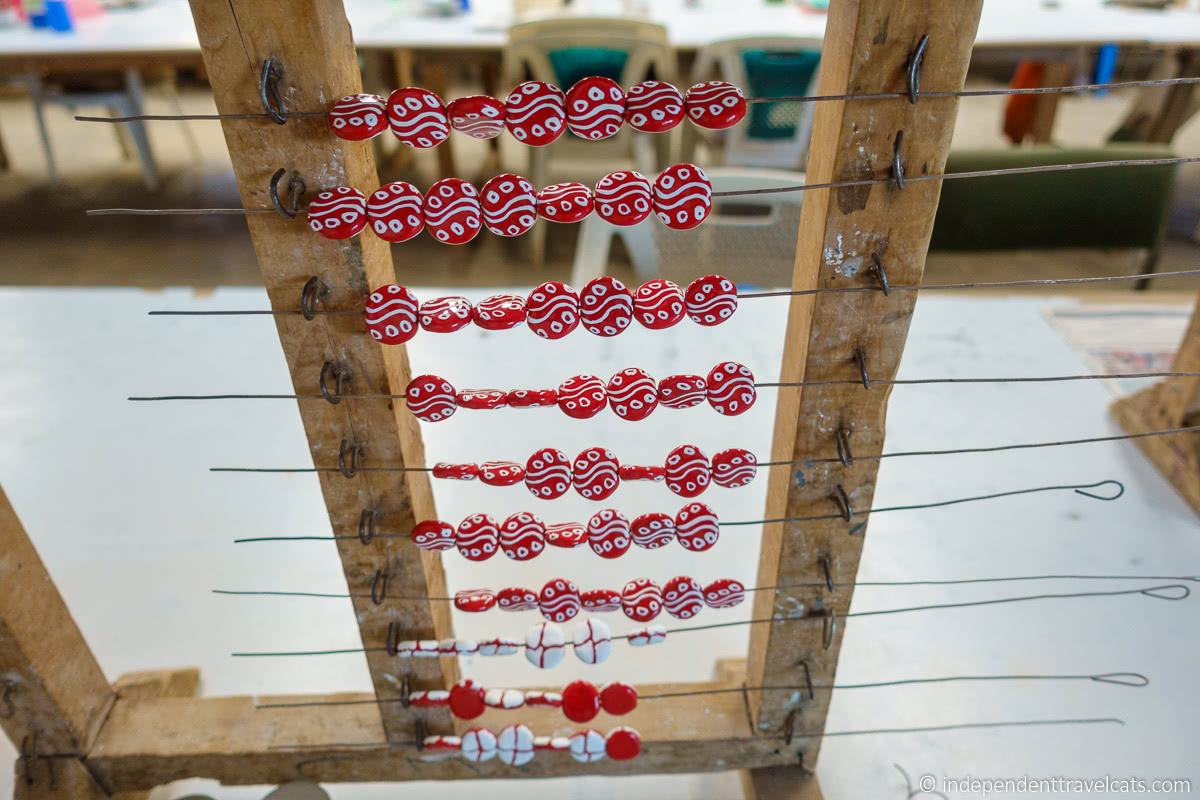
Bomas of Kenya
The Bomas of Kenya is a great place to visit if you are interested in cultural performances and seeing traditional homes from around Kenya. The Bomas of Kenya was established in 1971 by the Kenyan government to both preserve traditional cultural practices and increase tourism. Here you’ll find examples of traditional bomas from around 40 different cultural groups, daily cultural performances, a conference center, a restaurant, and a gift shop.
The first main attraction here is the bomas themselves. Boma in Kiswahili means “homestead” and there are bomas representing around 40 different ethnic/cultural groups from around Kenya.
Different tribes and groups from all over the country were invited to build replicas of traditional “mini villages” here so visitors could learn more about their traditional homes, building methods, and culture.
The bomas are in an open-air setting and you can walk around and explore them with a guide or on your own. Some of the many tribes and cultural groups represented here are the Kisii, Kikuyu, Meru, Somali, Turkana, Maasai, and Luo.
The Luo village may be of particular interest to some Americans as it was the tribe of former President Obama’s Kenyan father. A guide can be helpful in pointing out the differences as it can be difficult to spot some of the differences as some of the bomas are pretty similar.
The second main attraction for visitors are the cultural performances that take place at the large indoor circular theater here. Since 1973, the Bomas has been the home of Kenya’s national professional dance company, the Bomas Harambee Dancers.
The performances vary, as they have a repertoire of about 50 different acts, but the show includes several different acts representing different cultural groups. Each group is introduced and a little history is given about the dance, music, or instruments. Many of the dances are done as part of a tribal ceremony such as celebrating a circumcision, harvest, or birthday.
When we visited there were a variety of dance, music, percussion, and acrobatic acts. There were 9 acts in all and these represented the Borana, Agikuyu, Embu, Nubi, Luo, Maasai, and Bukusu groups and there was also a percussion performance and an acrobatic show. We enjoyed the variety and one of the groups also involved audience participants.
The performances are normally daily in the afternoons from 2:30pm to 4:00pm on weekdays and 3:30pm to 5:15pm on weekends and holidays; however, we recommend checking the performance dates and times online before you head here. The attraction is normally open each day from 10:00am to 6:00pm. You can buy tickets on-site in person.
Note that the Bomas are often the site used for the national elections tallying and announcements so are often closed to the public for a few months during presidential election years for security reasons as they did in 2022. So do be sure to check if visiting on an election year.
Of all the main tourist attractions in Kenya, this is one that seems to draw more Kenyans than foreign tourists. If you visit on a weekend, like we did, you’ll likely find the auditorium pretty full of local school groups, university students, conferencegoers, and other groups from around Kenya. There was also a smattering of fellow tourists and some local families.
The Utamaduni Restaurant located here is a great place to try traditional Kenyan food. It offers dishes from around Kenya’s different regions at reasonable prices. You can find foods here that are difficult to find at hotels and tourist restaurants.
We’d recommend allowing about 3 hours for your visit here. The performances take about 1.5 hours and you’ll want at least an hour for exploring the bomas. If you want to eat at the restaurant as well, I’d add a little extra time. You can easily spend the full afternoon here.
If you need transport, you can arrange for a private tour like this one that includes transport and a guide.
The Bomas of Kenya is located in the Langata suburb of Nairobi, making it easy to combine a visit with other nearby attractions. There are a number of tours that include a visit to the Bomas of Kenya, such as this tour which includes visits to the Giraffe Centre, Elephant Orphanage, and Bomas. You can see more tour options here and here which include a visit to the Bomas.
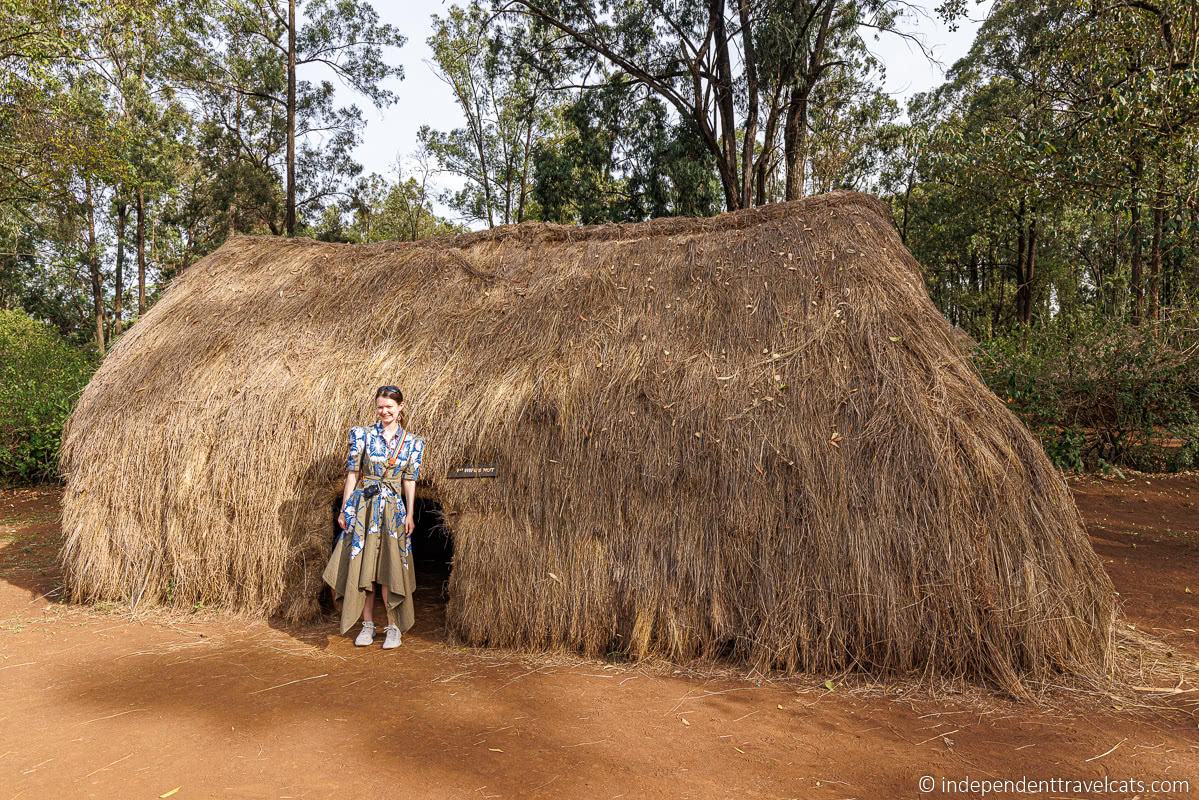
Try Local Foods
We highly recommend trying some of the local dishes while in Kenya. As the capital city, Nairobi is a great place to try different dishes from around Kenya and the wider East African region.
Here are just a handful of the foods you might want to try while in Kenya: ugali (maize flour porridge, a staple food across East Africa), chapati (flat bread), nyama choma (grilled meats), githeri (beans and corn), mahragwe (beans and rice), kachumbari (fresh tomato & onion salad), nduma (stewed arrowroot), matoke (green plantain stew), pilau (spiced rice), kuku choma (BBQ chicken), supu (soup), mtuzi wa samaki (tilapia fish in coconut curry sauce), mandazi (fried bread, doughnuts), tsiswa (roasted termites), viazi karai (potato nuggets), vibibi (coconut and rice pancakes), and mukimo (mashed potatoes, corn, and pumpkin leaves).
Note that the names and spelling vary in different regions as do the recipes. Some of these foods are typical across East Africa whereas others are more regional. What is on offer on local menus will also change by season and the region of the country. For example, along the coast such as in Mombasa, you’ll get a lot more fish and seafood as well as more Indian influenced dishes.
If you are looking to try popular drinks in Kenya, we’d recommend trying Kenyan tea (chai) and Tusker beer. Another popular Kenyan beer, and the favorite of one of our guides, is White Cap and it is produced by the same company that makes Tusker.
It can be difficult to try a lot of local dishes as many hotels and safari lodges in Kenya tend to primarily serve Western dishes. Many restaurants serve a number of European, American, or Indian dishes, but traditional Kenyan food can sometimes be tricky to find for tourists.
One thing we found is that a lot of common Kenyan meals don’t include any meat or fish but have a lot of vegetables, legumes, and grains. For example, a common everday meal is githeri, which is a stew of beans and corn. Most Kenyans cannot afford to eat meat everyday.
If your hotel doesn’t offer local dishes, I’d ask hotel staff, guides, or drivers for suggestions for places that serve good Kenyan food that they would recommend. They should be able to point you to places with safe cooking practices. It is fun to be adventurous, but you want to keep water and food safety in mind when choosing where to eat and what to eat so you don’t regret it the next day.
If you are not sure where to go and aren’t getting any good suggestions, a few restaurants that you may want to consider which focus on Kenyan food are Amaica in the Westlands, Utamaduni Restaraunt in L’angata, and the budget-friendly Hot Dishes which has a few locations in the Central Business District of Nairobi.
Utamaduni Restaurant is located at the Bomas of Kenya and serves Kenyan dishes from the many different regions of the country. If you are already planning to visit the Bomas, this is a very convenient option for lunch or dinner before or after your visit.
A second suggestion is to ask at your hotel if they are able to make local dishes on request. Normally, this requires asking a day or so in advance. For instance, we stayed at Nyati Hill Cottages and here they allow you to choose if you would like evening meals cooked for you or not. We chose to have our evening meals there and the local cook made us a typical Kenyan meal on our first night based on our request.
Finally, another fun option is to join a local food tour, such as this one . This not only allows you to try a number of Kenyan dishes with the help of a local, but it is also an interactive experience where you will learn a bit about Kenya’s food history. Just be sure to go hungry as you will eat a ton on the tour!
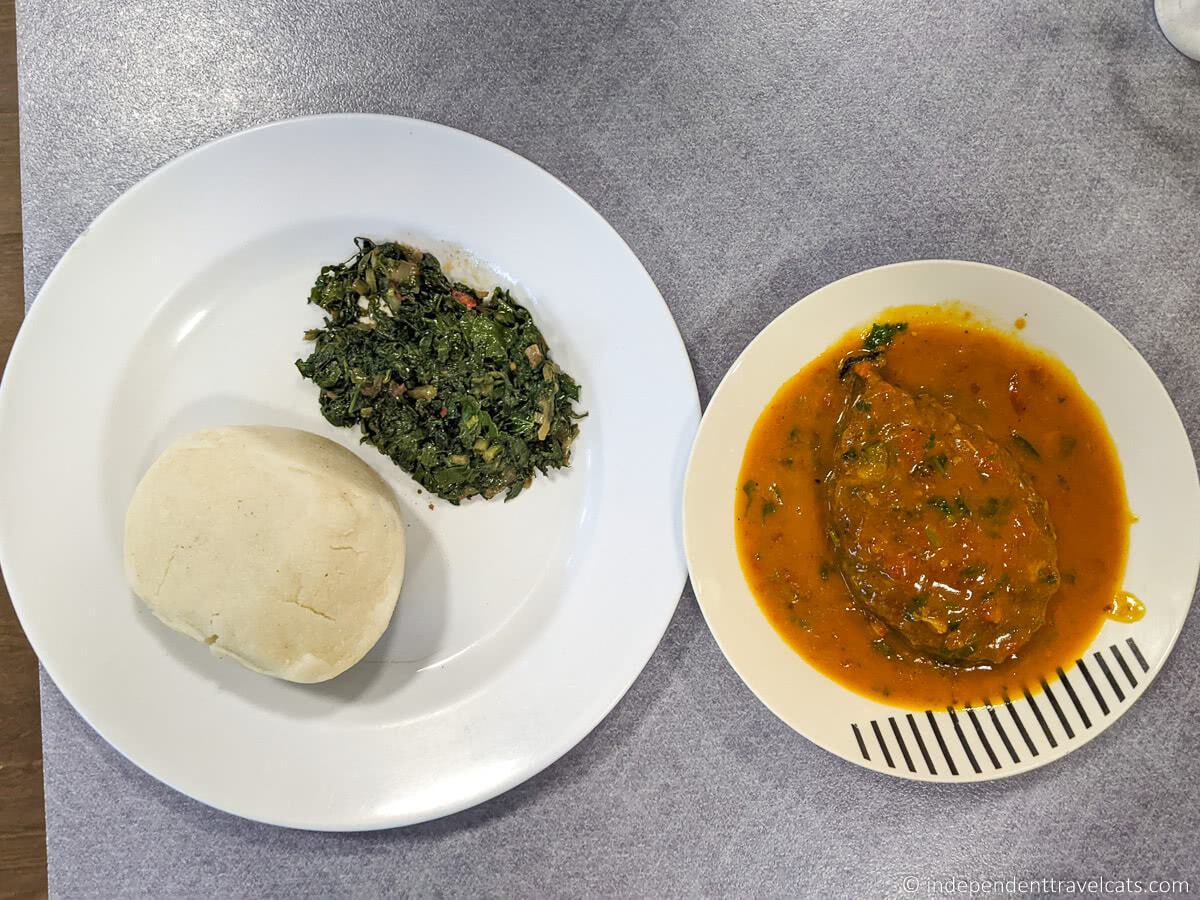
Karura Forest
Karura Forest is a wonderful green space located in northern Nairobi. It is a popular place for hikers, joggers, and cyclists with a number of walking trails and a 12 km long biking trail. It is also a popular place for family picnics, sports, school group visits, birdwatching, and dog walking. There is even a horse path for those on horseback.
We loved hiking here in the morning while staying in Nairobi. There are several different trails you can take, depending on how far you want to walk. The trails were fairly well-marked and you can buy a map at the gate if you wish. It really feels like you have escaped the city once you get out on the trails.
Some of the landmarks in the forest include Karura waterfalls, Mau Mau caves (where Mau Mau fighters hid out), Amani Gardens (which includes a memorial to those who died at the 2013 Westgate shopping mall attack ), and Lily Pond Lake.
Karura Forest is also a good place to spot local wildlife, especially birds. One of our safari guides told us that he comes here in the mornings sometimes for birdwatching. We spotted antelopes, monkeys, and several birds during our visit.
We visited on a weekend and while quiet in the morning it was very busy by the afternoon. Most were enjoying picnics in the picnic areas or playing sports. There is a football pitch, basketball court, and tennis courts. You can also rent bikes and head off on the bike trail.
You can enjoy a picnic in one of several designated picnic areas within the forest. There is a small fee for picnics and picnic spots are first-come first-serve (booking recommended on weekends). Note that alcohol and single-use plastics are not allowed in the forest.
There is also a restaurant, The River Cafe , located within the forest which is normally open whenever the forest is open. There are several free toilet facilities within the forest.
Karura Forest is normally open daily from 6:00am to 6:00pm. There is a fee to visit the forest and also a parking fee is you are driving yourself. There are also additional fees for certain services such as bike rentals, nature tours, using the sports grounds, or using the event space facilities. Some activities need to be booked in advance. You can check opening hours and fees here .
Some locals recommended that we don’t visit the forest on our own as there have been robberies on the trails. We felt safe but if you are traveling solo or would like a guide, there are tours you can join at the forest led by Karura Forest Eco-Tours, you can read more here .
If you are looking for transport and a local guide, you can also join a tour such as this guided tour and this guided tour . These tours normally include transport from your accommodation, a guide, forest entrance fees, and bike rentals (optional).
Although Karura Forest is the largest, it isn’t the only forest you can visit in Nairobi. The others are Ngong Forest and Oloolua Forest (the 5km Oloolua Nature Trail is here). Another option is the Nairobi Arboretum (described in another section) which is smaller but the most accessible for those in central Nairobi.
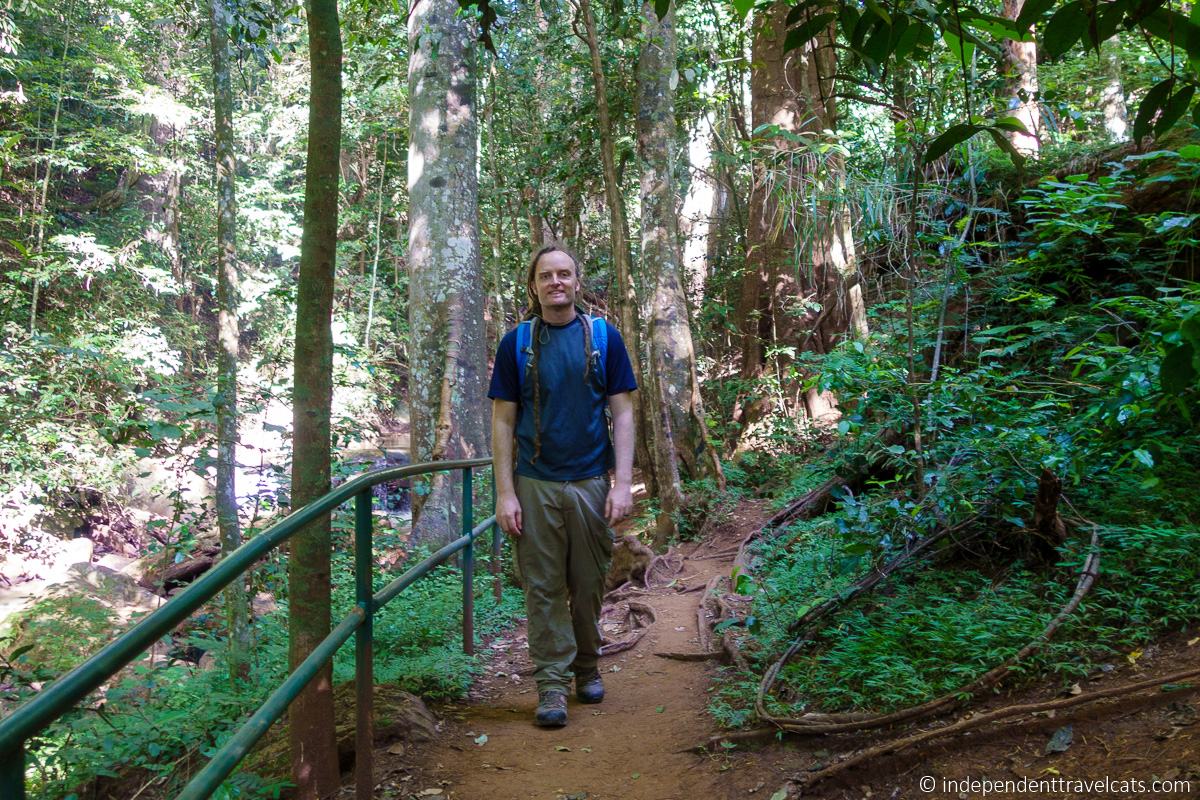
Nairobi Arboretum
The Nairobi Arboretum is a 30-hectare forest in the Kilimani area of Nairobi. It offers forest trails, lawns, picnic areas, and jogging trails. It is a great place to see lots of local and exotic tree species and is also home to a number of bird species as well as Sykes and Vervet monkeys. It is a popular place for locals to jog, meet, hang out, hold events, and have picnics.
The Nairobi Arboretum was established in 1907 as a place to plant new species of exotic fast-growing trees to use as firewood for fueling the newly constructed railway. It was designated as a national reserve in 1932 and in 1996 it became a public owned reserve.
We visited on our last trip to Nairobi as it was a short walk from where we were staying in the Kilimani area of Nairobi. It has a lot of shady paths you can follow as well as lots of places to sit and relax. The only negative was that a large family group were littering and feeding the monkeys without staff intervention when we visited.
There is a small fee to enter the arboretum and a parking fee. The Nairobi Arboretum is open daily from 6:00am to 6:00pm each day. There are toilet facilities on site. You can check fees and events here.
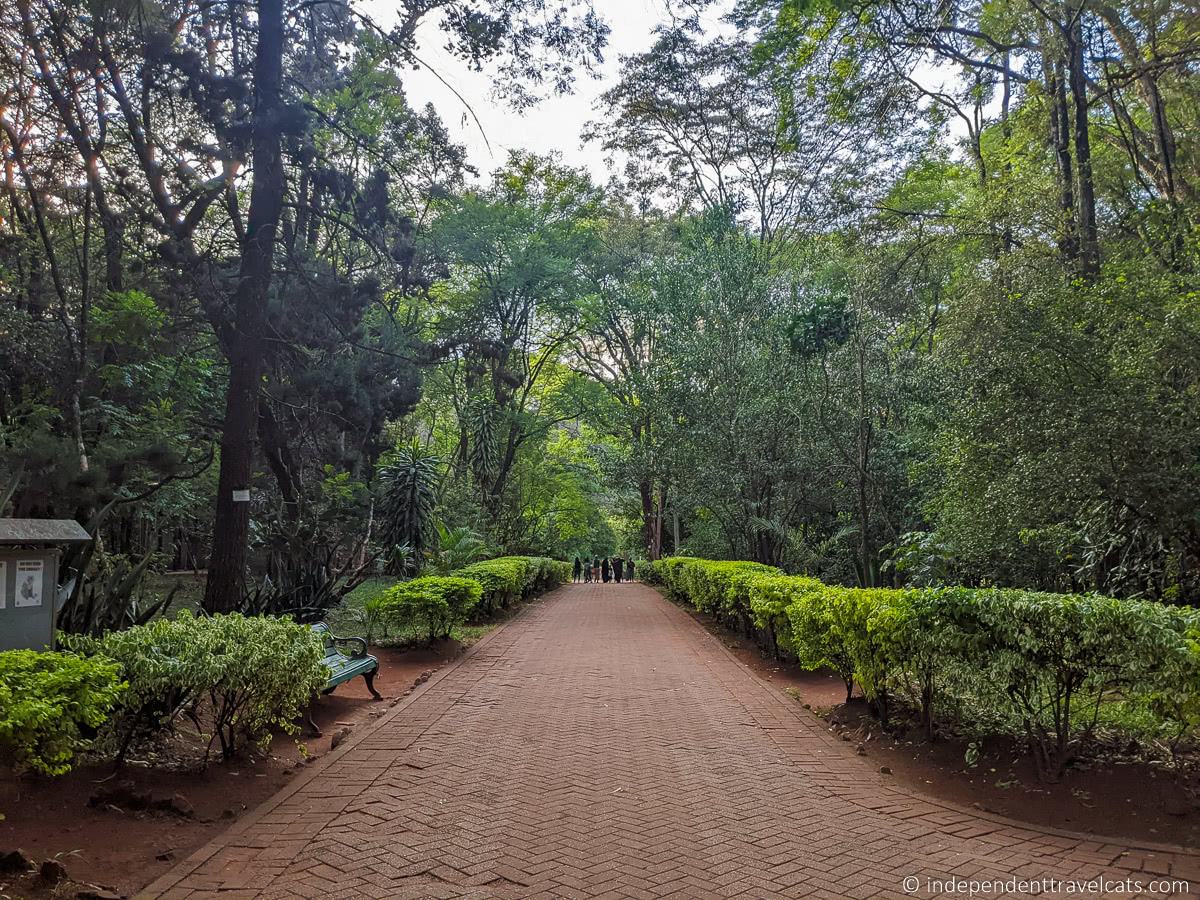
And that is our guide to visiting Nairobi and a list of the top things to do in Nairobi! We hope that if you are planning a trip to Nairobi that this guide has been helpful to you. If you have any questions about your trip to Kenya, just ask us and we are happy to try to help.
Want to remember this article, PIN it on Pinterest to read it again later:
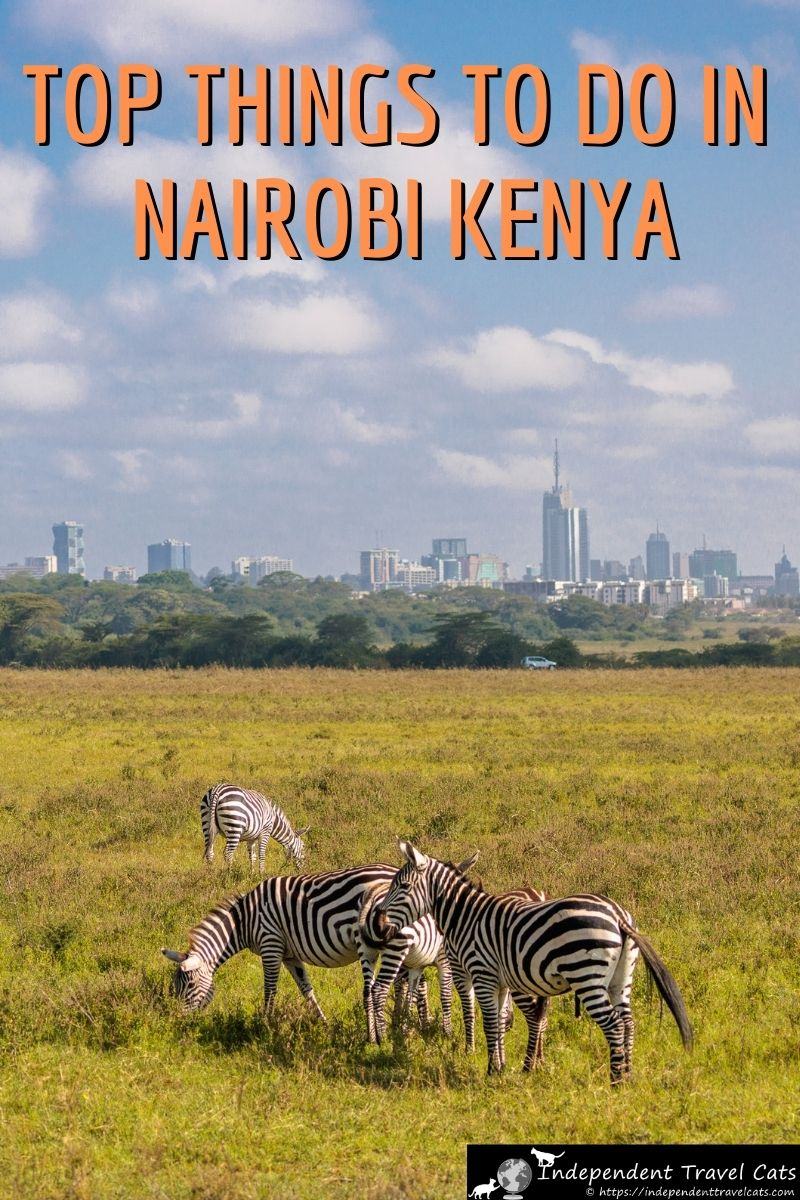
Are you planning a visit to Nairobi? Which of these sites are on your travel wish list? If you have visited any of these places, we’d love to hear your personal experiences and tips.
If you are planning a trip to Nairobi (or elsewhere in Kenya) feel free to ask us any questions about any aspect of your trip below and as always we’ll do our best to answer your questions!
Share this Post!
There are 34 comments on this post.
Please scroll to the end to leave a comment
Rob Post author
November 16, 2023 at 2:23 am
Your article is really thorough and I enjoyed it. The only thing I can add is that in Nairobi you can also get genuine Somali, Ethiopian, and Indiana cuisine. There are also a couple of events you can plan your trip around like their annual jazz festival, and monthly concert called blankets and wine where you can listen to Afro-jazz, soul, and RnB. Also safari rally for motorheads.
Jessica & Laurence Norah Post author
November 16, 2023 at 3:01 pm
So glad you enjoyed our Nairobi guide, and thanks for adding some more things to do in Nairobi!
The Blankets and Wine event sounds really nice! I just looked it up and looks like it is a quarterly event in both Nairobi (currently in the Kasarani neighborhood) and in Kampala, Uganda. Definitely something we’ll see if we can catch if timing works out next time we are in Kenya!
Best, Jessica
Peter Cheps Post author
September 20, 2023 at 4:39 am
This is one of the the most detailed piece about Nairobi. As i am commenting today, Nairobi is preparing for EL-Nino Rains. that might disrupt traveling in and out of Nairobi City soon. Travelers should be cautious particularly in the Western Sector of the country when the rainy season start anytime from now
September 20, 2023 at 3:39 pm
Thanks for taking the time to comment and let us know that you found our Nairobi post helpful and detailed, we alawys love to hear when our articles have been helpful to readers.
Thanks for sharing that info about the current rains and weather warnings, and I hope you stay safe if you are currently traveling in Nairobi or elsewhere in western Kenya.
Henna Post author
August 26, 2023 at 6:17 am
Hi! I stumbled upon your blog while looking if Nairobi is worth including in to our itinerary. It was highly informative, yet still with personal touches so I really enjoyed reading this! As you said, many use Nairobi as a gateway to safaris, and it was my original plan too but I founded tons of things I wanted to see/visit if I manage to squeeze in more than one night in there! David Sheldrick Wildlife Trust, City Markets and Thorn Tree Cafe at the top of my lists! Thank you for sharing your trip/trips and Happy Travels! Henna
August 26, 2023 at 9:43 am
So glad that our article convinced you to stay and see some of the sights in Nairobi!
Sounds like based on some of the places you want to see, if you have just one full day, I’d split your time between the Central Business District (downtown) to see places like the City Market and Thorn Tree Cafe (best for lunch, coffee, or drinks in our opinion) and then Karen/Langata for places like David Sheldrick Wildlife Trust elephant orphanage and you could maybe add a place or two in that area such as the Giraffe Center, Bomas (check performance schedule if interested), Kazuri Beads, Karen Blixen Museum, and/or Utamaduni Shops. Just be sure to check operating dates and times or if joining a tour, then they’ll time it for you. For the elephants, you’ll want to be there by around 10:30am to check-in so that is the one place that has a very definite time constraint and I’d plan your day around that stop.
If you have one full day and part of a second day, you could easily spend a full day in Karen/Langata and then the next partial day visit the City Markets and then have lunch at Thorn Tree Cafe before heading off to safari.
Hope that helps and just let us know if you have any more questions as you plan your visit to Kenya!
August 26, 2023 at 10:00 am
Hi Jessica!
Of course best would be to have atleast one full day, but the flights I am currently looking are landing during the night so I don’t know. Will have to think about it! Currently I am looking in of safaris so if you have any good safari operators in mind it would be greatly appreciated! And any uptodate COVID restrictions, I am seeing some very mixed informations on the internet…
August 26, 2023 at 5:40 pm
Yes, never enough time. If you arrive at night and want to see some of the city, then I’d recommend trying to stay two nights in Nairobi. The first one just to sleep, and then you can take a tour the second day around Nairobi to at least see a few attractions. This will also give you some time to relax and get ready if you start your safari the next morning.
Happy to give you some thoughts on safari but it depends on a lot of things! When are you thinking of going on safari, for how long, what is your budget, do you want a private driver or join a small group safari (or either), are there any specific things you want to see, etc. Are you just planning to just stay in Kenya for your safari?
I think Kenya has recently lifted all its main COVID restrictions for travel to and within the country (although it says if any traveler has any signs of illness they will be asked for proof of vaccination and tested). But some Kenyan authority websites do say that proof of COVID vaccination is required (I suspect they just haven’t been updated…) so I would just be safe and make sure to always carry your proof of vaccination on you (also a good idea just in case the requirements change while in the country as they can sometimes do). But you should definitely doublecheck the latest requirements for your home country, airline, Kenya, and any other destinations before your actual departure.
I am sure you are already aware, but there are a number of vaccinations recommended for travel to Kenya, and you can see the latest CDC guidelines here . I’d make an appt with your doctor or a travel nurse a few weeks in advance and see what is recommended for you and where you plan to go. Depending if you plan to travel to or through any other countries in East Africa, a yellow fever vaccination may be required. If you need or decide to get the yellow fever vaccine, I’d recommend taking it at least 2 weeks before you depart.
August 26, 2023 at 5:53 pm
I have already started to get my vaccinations, still few appointments left and planning to eat Malaria pills during our trip. Our trip will be early November, and I am travelling with my spouse.
2 nights in Nairobi sounds about perfect, just hope I am not overly positive about the time we have… 🙂
For safari the idea is to see the flamingos in Nakuru. Maybe include Maasai Mara to the itinerary. Maybe 4 days, 5 tops. And from Nakuru continue our journey to Uganda where we are going to stay rest of our trip and flying home from. I think private tour would suit best for us, since we like to have our own timetable. Budget is midrange, not overly expensive but I am not fan of sleeping in the tent either. 🙂
August 27, 2023 at 9:48 am
So the company we used is Tanzania based (Amani Afrika) and normally only does Kenya as part of a longer itinerary that includes Tanzania, but for such a short trip you will have a lot of options to get a private safari from Nairobi as Nakuru and the Mara are two typical places to visit together. Lake Nakuru is only about a 3.5 hour drive north of Nairobi so sometimes people even do it as a one night trip. I imagine most companies will have a 3-5 day itinerary for those two parks. I’d recommend checking out TourRadar as you can compare tours by length, price, rating, etc. You can see November private tours to Lake Nakuru and the Maasai Mara here . I’d say for a private tour for 4 days with mid-range accommodation, private guide, transport, meals, park fees, etc. – you are looking at around $1000-$1500 per person. If you want a cheaper one, you can get much lower rates by camping or joining a group. Just make sure the itinerary you choose has what you want in it and know what all is covered in tour price (and what you would need to pay for extra).
Also a note on the flamingoes, there are not as many of them in Lake Nakuru as there once was and for several years, there were almost none due to rising water there but they have been returning in the past couple of years and it looks like they are there now. But when I was in Kenya last year, there was almost none there, but we did get to see some in Amboseli. So just something to keep in mind. But regardless, Nakuru and the Maasai Mara are very much taking the time to see.
So for getting to Uganda, I would recommend flying from Nairobi to Entebbe/Kampala. There are daily flights with Kenya Airways and others to Entebbe and they are only about 1.5 hours. If you go overland from Kenya it will be 10+ hours of driving and you’ll need to pay for your driver/car/fuel/accommodation for an extra night. Also best to get a new Uganda guide for your time in Uganda rather than have a Kenyan guide in most cases due to local knowledge and language. Of course if you want to save money, you can get a bus from Nairobi to Kampala for about $25. But I’d recommend flying if you want to avoid the discomfort of a long bus or car ride.
Where are you planning to go in Uganda? We have been a couple times, and spent about a month in Uganda earlier this year. I haven’t had a chance to write too much about our time in Uganda but Laurence has written guides on visiting Entebbe , chimp trekking , and gorilla trekking . But we have also been to all the national parks and most of the cities there as well as several museums and cultural attractions. So happy to try to help if you have any questions about planning your time there as well.
August 27, 2023 at 1:16 pm
Hi Jessica,
You are really going above and beyond answering my questions, thank you!!
(There wasn’t Reply link on your response below so I used this one..)
Yes, I read about decreased flamingo population in Nakuru, but I think it would still be worth visiting, and it is on our way so why not stop there for a day or two, right? 🙂 And with animals nothing is ever 100% sure anyway!
The prices you mentioned 1000-1500 per person is what I expected. I have became a bit comfort-seeking on my old age of 30, (hah!), so I am sure it won’t be worth of saving couple hundreds if it means sleeping in a tent. I wouldn’t mind being a part of bigger group, it is nice to meet new people, but since we are not coming back to Nairobi it would just be a hassle for the rest of the group if we were to be dropped off somewhere else.
Ah, flying. It is such a long flight even to get in Africa in the first place so even if it means sitting in the car for several hours I would much prefer it. It enables to see the scenery on the way! Bus is option I am thinking on. The border crossing just intimidates me a little. But, it would be a experience in it self.
In Uganda we are going to stay in Kampala. I will have to check Laurence’s guides for Uganda, thanks! I would love to see the gorillas but it think our budget is too slim for that. Well, something for next time..But if you have any tips for Kampala, I would appreciate them! 🙂
August 28, 2023 at 4:10 pm
You’re very welcome!
I think that you’ll probably find it easier and less expensive to return to Nairobi after your safari regardless and then head to Uganda from there. You’ll have the most bus options there as well, if you do the bus I would just book the nicest seat you can. The bus can be interesting as you can get to see how most Kenyans travel back and forth in East Africa. Either way, just be prepared for a very long day of sitting!
In Kampala itself, its a busy and chaotic (traffic wise) place but there is definitely 2-3 days worth of things you can do, depending on what you like to do and see. The main cultural attractions we’d recommend would be Kabaka’s Palace, Uganda Museum, and Kasubi Royal Tombs. There are also a number of important religious sites, again depending if those are of interest – the Uganda National Mosque (also nice view from minaret, we could only see outside of actual mosque as non-Muslim when we visited), Catholic churches (Saint Mary’s Cathedral Rubaga, Basilica of the Uganda Martyrs, etc.), Anglican (Saint Paul’s Cathedral Namirembe), and the Baha’i Temple.
For a general sense of Kampala and learn more, we’d highly recommend doing some kind of walking tour with a local guide. We’ve personally done this walking tour of the downtown with mosque visit (with guide Arthur), a great way to see and learn more about Kampala and go to some places that you may not feel comfortable walking without a guide. We’d also recommend doing one of the nighttime cultural events or shows at the Ndere Cultural Centre , the shows are fun, the people were super friendly, and meals are optional to add at many of the shows. If you are more adventurous, you might also enjoy a food tour to try a lot of local food items, Laurence did this tour and loved it. If you’re into social change, the slum awareness walk with AFFCAD is amazing (usually led by Jaffar), but you’d need to contact them in advance if they are still leading them.
From Kampala, both Entebbe and Jinja are within easy day tripping distance. Entebbe is where the airport is located and has a lovely botanical garden (see Laurence’s posts with all the info about Entebbe). You could also do a day trip over to Jinja, the source of the Nile and also some nice forest and waterfalls over in that area. If you want to see more wildlife/nature and have a few days to do a short tour, then the nearest parks are either Murchinson Falls or Lake Mburo. Or you could go do chimp trekking as well.
Yes, unfortunately the permit costs for the gorilla treks are a set price and are expensive so you can save that for another time! It is much less expensive to do the chimp trekking (or golden monkey trekking) so you could look into those if you are interested. I think the Kibale forest permits are now $200/person but less at other sites ($50-$120/person I think) although Kibale in our experience is the easiest place to see them.
Oh, yes for the comment replies, I think we may have exceeded the maximum number of comments allowed on a single thread. So if you want to reply or ask another question related to Kenya you can just start with making a new comment. Or if you have any follow up comments about Uganda, you can leave them over on one of Laurence’s relevant posts on those topics.
Hope that helps! Jessica
Adam Post author
August 19, 2023 at 2:36 pm
your nairobi guide is so very helpful to us – we are an older couple from u.s. planning a trip. we were here 30+ years ago but never got to really see much of the city as we went off to do some volunteer work and a bit of safari elsewhere. the city seems to have changed a lot since our last visit and this time we want to spend a day or two seeing it. then going on to visit some old friends on the coast and do some safari time
so if you don’t mind a couple of questions for you: 1) do we need to worry about tetse files while in nairobi? or what colors we were? (I see laurence in bright blue in one photo so thinking not) and 2) we love the idea at staying at a historic hotel but not sure if stanley would suit in downtown (feel a bit worried about that area at night), do you have other ideas. we like something that has old-world feel, comfortable and a place where we could get transport & join tour to see city. don’t mind being outside very center, but don’t want to be outside the city either
August 20, 2023 at 8:20 pm
So first, so glad to hear that you are find our Naribi travle guide and tips helpful in planning your own Nairobi itinerary. How wonderful that you and your partner have the chance to return to Kenya again after 30 years! And I definitely agree that Nairobi is worth a full day or two to explore. I understand that you may feel a bit uncomfortable visiting here, especially independently, but with a tour guide or driver on a booked tour you should be fine.
1. No, you don’t need to worry about the tsetse fly in Nairobi. Now, I won’t 100% guarantee you that there aren’t any as they are attracted by wildlife and livestock, but I don’t think you need to worry about them in any places you are likely to go. We never experienced any in Nairobi National Park for instance. We did get bitten by mosquitoes one night (we left our window open and didn’t use our mosquito netting one night) in Nairobi last year so they do exist at least in some areas of the city and good to take precautions against them, especially in the evening. So you can wear whatever colors you want but if doing safari later, there are tsetse flies in many of the game parks in Kenya, including the Maasai Mara and Tsavo. So best to stick to the “safari colors” for your time on safari. Although efforts to minimize tsetse flies in Kenya have been effective it seems in recent years, our guide said last year that he was shocked by how few tsetse flies he saw in Tsavo West compared to prior years.
2) So really any hotel in the central part of Nairobi is fine for most tour companies and with private guides in particular they are generally pretty flextible in terms of pickup and dropoff locations. Same with taxis. You just need to give them the address at the time of booking normally so they can then set a pickup time. So I would focus on the hotel first and then you can book your tour.
Here are a few options in Nairobi, not sure of your budget, but these are all nicer ones:
So The Stanley is definitely one of the oldest hotels and a classic, but you are right in that it is located in the center of the CBD and is right next to busy streets. So you can read reviews from other travelers on that.
Another good option is The Norfolk , so this is a 5-star historical hotel (the original part dating to 1904) and is also located in the CBD, but in the northern part up in the university area. It is surrounded more by gardens and feels less in the middle of the city so this might be a good alternative. Still central but doesn’t necessary feel like it is so and has good security.
If you prefer to be outside of the central business district of Nairobi, you might consider a place over in either Karen or Langata (depending on what you plan to do with your day in Nairobi) such as Giraffe Manor (former home of the Leslie-Melvilles and built in 1932) or Karen Gables (Cape Dutch style former home) which is a nice B&B.
Another place would be Villa Rosa Kempinski , this is not a historical hotel (built in 2009 or so I think) but it has an Old World sort of decor. It is located in the Westlands area.
Anyway, hope that helps you get started. And do let me know if you have any further questions as you plan your trip!
August 21, 2023 at 6:18 pm
Hi Jessica! Wow, thanks for taking the time to answer so quickly and provide such a thoughtful response. good to know no flies to worry about, at least for this part of our trip but we did know they would possibly appear in the mara etc. And I think the norfolk hotel you recommended looks perfect, so I think we will likely book that as it looks like a nice place to stay after such a long journey, central in the city, and a bit of an indulgence before we head onward. thanks again for your time and knowledge very grateful!
August 21, 2023 at 6:41 pm
You’re very welcome. Wishing you a safe & wonderful trip to Kenya!
tanay sharma Post author
June 22, 2023 at 2:37 am
I love exploring different places and Nairobi is one of the places I would love to explore. Thanks for sharing insights about different factors like water safety, travel options within Nairobi and health concerns. I have been at the ethiopian airlines flights to Nairobi from different parts of the world. Looking forward to more such informative posts!
June 22, 2023 at 10:34 am
Thanks, glad you are considering a visit to Nairobi. So in Kenya, Nairobi’s Teknik Post author June 6, 2023 at 3:29 am Are zebras native to the habitat there? June 14, 2023 at 7:15 am I believe that zebra are native to Nairobi, or at least that general area before the city built up there. Writings by early settlers and the books by Isak Dinesen (aka Karen Blixen) talk about there being lots of local wildlife outside of the city such as gazelle, zebra, and lions. Now almost all the larger wildlife is contained within Nairobi National Park which was created in 1946. I think all (or at least most) of the animals and birds found there are native to Kenya. I don’t know for certain but I think that the range for zebra would have been very widespread across Kenya in the past with plains zebra liking habitats such as treeless grasslands and savanna woodlands. In terms of zebra species, there are both Grévy’s zebra and common plains zebra in Kenya, but in Nairobi National Park you’ll only find the plains zebra. But you can find the endangered Grevy’s zebra in some of the parks/reservers in northern Kenya. Hope that helps! If you have any other questions about visiting Nairobi National Park, just let us know – it is a great park to visit if you are staying in the city. Alison Post author May 20, 2023 at 11:39 am Lovely article! I’m currently in Nairobi myself and just wanted to say that your tips have made this trip much easier, and have also made me more confident being here (I’m by myself, as a woman and infrequent traveller), so thank you for that! Also, to any tourists who might be reading this, I just want to say that 1 day most definitely is not enough. This city is amazing and has so much to offer. Added benefit of having more time is you get to take a break in one of the really beautiful parks and just watch all of the exotic birds that hang out in the centre of the town. And if you’re concerned about safety, which I know a lot of people are – I’ve walked everywhere, totally submerged in the crowds of Kenyans from walks of life who get around on foot, and have not for a second felt uncomfortable or unsafe. Hope that helps! May 21, 2023 at 9:34 am I am so happy to hear that you had such a lovely visit to Nairobi and that our tips and information was helpful and make you more comfortable visiting the city. Yes, as a single woman, it can definitely be intimidating. And yes, we can certainly agree that the city has enough attractions to fill a few days as we have certainly done on prior visits – we are hoping to get back here next year again! One thing I would note for other readers reading this is that although we also feel comfortable walking in many parts of Nairobi, especially during the day, there are certainly some areas of Nairobi I would not recommend tourists wander around alone on foot, especially after dark. So I think it is just about being cautious, sensible, and also following local advice. Many residents would also not recommend walking in certain areas alone after dark as there are just certain places where crimes like robbery are unfortunately still common. Thanks for taking the time to comment, and I am very happy you had such a great time in Nairobi!! Erin Post author August 30, 2022 at 2:05 am I’ve been to Nairobi! It’s just as cool as the pictures show, any one reading this should consider going! August 30, 2022 at 3:06 am Thanks for taking the time to comment, and so happy that you enjoyed your trip to Nairobi! Seana Turner Post author August 29, 2022 at 3:26 am Our neighbors across the street just returned from safari. Too bad they didn’t read this post before going! We also have a mission partner who lives in Kenya. She came to the US for seminary, and then went back to her home in Nambale to start a school. It’s been amazing to watch what she (with God’s help) has accomplished. Because she comes back every year, I get to hear lots about Kenya, and her time passing back and forth through Nairobi. Once again, you provide all the little details everyone needs to know. On another note, my husband and I are hoping to take a trip to Scotland next summer, so I’ll be combing this site for ideas on what we should do while we are there. Keep the great info coming. 🙂 August 29, 2022 at 6:50 am That sounds wonderful about your friend and her work. I hope you get a chance to perhaps visit her in Nambale some day and do some sightseeing in Kenya 😉 And of course, happy to help you with your trip to Scotland once you start planning it. We have a lot of articles across our two travel blogs, and you can also of course leave us Comments or email me with any questions. Emily Post author August 2, 2022 at 12:01 am Great post and photos, gave us lots of info about Nairobi and also travelling to Kenya in general. We just have an afternoon in Nairobi and most of the tours start well before we could be able to do so. Thoughts on what to do if we just have 5-6 hours in afternoon and evening. We fly out the next morning pretty early. Staying in a hotel in the Lavington area I think. August 3, 2022 at 12:58 pm So some options not too far from you if in the Lavington area of Nairobi would be the Giraffe Center, Kazuri Beads, Karen Blixen Museum, Bomas of Kenya (if reopened by your travel date), Uhuru Gardens Memorial Park (if reopened), and the Carnivore restaurant (it is normally open late for dinner). If you wanted to just do one thing, you could also book an afternoon game drive at Nairobi National Park. However, I would note that we’d generally recommend visiting there in the mornings. But I think it is open until early evening. You could also instead spend your time in the Central area of Nairobi and there you could visit one of the city’s museums such as the Nairobi Museum, go up the KICC (need a passport on you), do a walking tour, visit the City Market, etc. But you’d definitely want to check opening hours and days to make sure any places would be open when you are there. So I think there are a number of options, I would just see what will fit with your specific date and time you’ll be in the city, and what is of most interest to you. It also depends on what kind of transport you have, and with such a short amount of time I’d recommend hiring a private driver, joining a tour, or taking taxis/Uber. Hope that helps, and wishing you a wonderful time in Kenya! Lawrence K Post author June 7, 2022 at 3:09 pm A lovely and detailed account of my city. You are most welcome to visit again and again. June 7, 2022 at 3:52 pm Hi Lawrence, Thanks so much for taking the time to leave a comment. It is really wonderful to hear that you enjoyed our article about your home city of Nairobi – if you have any other tips or advice we might have missed, feel free to add! We’d love to hear them. And yes, we hope to visit Nairobi again soon. We know we are going to be back in Uganda in 2023 and will hope to also be able to get over to Kenya as well 😉 May 31, 2022 at 1:49 pm I have to say that the very idea of traveling to Kenya feels a little overwhelming to me. I am not the most intrepid traveler, and it feels a world away. I do have a friend who lives in Kenya and has established and runs a school there (she’s amazing!). I also am friends with a couple who travels to Kenya each year to support missions and children. So I know it is possible! I would say it would not have occurred to me to that there was so much to do in Nairobi. I have learned from my friends that the pace in Kenya is slower, so I guess if you have made that very long trip, might as well see as much as possible. As always, so full of helpful information. You guys are the best! June 1, 2022 at 4:11 am Yes, Kenya is not the easiest place to travel but you can definitely do so with some planning. And having a friend in Kenya would definitely make it easier as I am sure she would love to have you visit her 😉 Safety is obviously a concern for most travelers so visitors do need to take precautions. Right now the USA (and other countries) has increased its security warnings for Kenya as the elections are coming up in August 2022 and can bring increased unrest to the country. But hopefully this will calm down again following the election period. Yes, there is plenty to do in and around Nairobi. I’ve been to Nairobi three times and there are still things I would love to go back and do and see if we have the chance to return. Even if you aren’t really interested in the downtown city attractions, you can stay on the southside of the Nairobi National Park and it feels like you are out on safari. Seeing wild animals like giraffes, zebras, and lions with a city skyline in the background is really unique. If you decide to visit, just let me know 😉 eleanor graves Post author May 30, 2022 at 6:07 pm wow, what an in-depth article! really enjoyed reading all this about nairobi as we are *hoping* to visit Kenya for the first time next year!! so will be bookmarking this. A few quick questions: -how easy is it to get a taxi from NBO airport? -if we just have a day, what tour would you recommend taking? -not really related to nairobi, but what do you advise wearing for kenya, like for the game drive parts? thanks in advance, i am sure I will have more questions in the future! May 31, 2022 at 6:37 am Hi Eleanor, So glad you enjoyed reading our post about things to do in Nairobi and excited to hear you are planning to visit Kenya next year. I hope you are able to do so. 1. Yes, it is pretty easy to get a taxi from the airport. There are taxi desks in the airport and ones waiting outside in the taxi/cab designated areas there you can take (just be sure to take one from the designated areas and set a price with the driver before you get in). You can also call an Uber, arrange a transfer in advance to be waiting for you, or your hotel and/or tour company may be able to do it for you. The airport recommends having an airport taxi or private transfer arranged in advance to avoid needing to negotiate. The taxis at the airport are regulated and licensed but there are no set fees so they will sometimes overcharge foreign visitors. 2. I think you have since found our detailed 1 day Nairobi itinerary post. That should give you lots of ideas. But in terms of specific tours, this is a full day tour that covers all the places I went on my first visit to Nairobi. But it, of course, just depends on what you are most interested in seeing/doing. 3. You want clothing that is comfortable, breathable, will protect you from the sun and insects, and is easy to wash (good if can be both handwashed and machine washed). Avoid dark colors, particularly black and blue (which attract tetse flies), and bright clothes. Good colors are khaki, tan, light green, gray, light brown, olive green, and other such “earthy” colors. For shirts and pants/trousers, most of our safari clothing (for both Laurence and myself) is by Craghoppers . We like their Insect Pro line (called NosiLife Pro in some countries) in particular. You’ll also want a brimmed hat, sunglasses, and comfortable shoes that you don’t mind getting a bit dirty (we wore hiking boots, but you could also probably do with sneakers/trainers if not hiking on your trip). But in Nairobi as we noted, we recommend just wearing normal comfortable clothing and shoes. Colors don’t really matter as much. You want to still be careful with prepared for the sun as many of the sites like the elephants orphanage are uncovered. Also important to always have water with you (if part of a tour they will normally provide filtered or bottled water to guests). Hope that helps, and yes feel free to ask more questions as you plan your trip to Nairobi. Your email address will not be published. Required fields are marked * Notify me of replies to my comment (just replies to your comment, no other e-mails, we promise!) Subscribe to our monthly Newsletter where we share our latest travel news and tips We only ask for your e-mail so we can verify you are human and if requested notify you of a reply. To do this, we store the data as outlined in our privacy policy . Your e-mail will not be published or used for any other reason other than those outlined above. 0800 088 6002, [email protected], client log in, reset password, agent log in.Leave a Reply Cancel reply
Our head office

Best things to do in Nairobi, Kenya: A Nairobi Travel Guide - Spend a day for the ultimate Nairobi day tours experience
When planning your Kenya tours , one destination that should undoubtedly be on your list is Nairobi, the vibrant capital city. In this comprehensive Nairobi travel guide, we delve into the best things to do in Nairobi, Kenya, ensuring that you make the most of your time in this dynamic city.
Whether you're eager to explore Nairobi National Park, spend a day discovering key attractions, or simply soak in the rich culture, our guide is designed to enhance your one-day experience in the city. Embark on a journey through Nairobi's highlights, uncovering the diverse activities and landmarks that contribute to an unforgettable trip to Kenya.
What is the history of Nairobi?
Nairobi, the capital and largest city of Kenya, has a rich and diverse history. Here is a brief overview:
Founding and Early Years: Nairobi's history begins in the late 19th century when it was established as a British railway camp during the construction of the Uganda Railway. The city was founded in 1899 and quickly grew as a supply depot and a center for British colonial administration in East Africa.
Colonial Era: Nairobi became the capital of British East Africa in 1905. During the colonial period, the city experienced significant growth and development, attracting European settlers, Indian traders, and a diverse African population. The city became a hub for commerce, agriculture, and government.
World War I and II: Nairobi played a role in both World War I and World War II. The city served as a military and logistical center for the British during these conflicts. After World War II, there was increased demand for independence across Africa, including Kenya.
Independence and Post-Colonial Era: Kenya gained independence from British colonial rule on December 12, 1963, and Nairobi continued as the capital of the newly formed Republic of Kenya. Jomo Kenyatta, a key figure in the struggle for independence, became Kenya's first president.
Post-Independence Development: In the post-independence period, Nairobi underwent significant urbanization and development. The city continued to grow as a political, economic, and cultural center. However, like many African cities, it faced challenges such as rapid urbanization, infrastructure development, and social inequality.
Political Turmoil: In the late 20th century, Kenya experienced periods of political turmoil, including the pro-democracy movement in the early 1990s and the post-election violence in 2007-2008. Nairobi was at the center of these events, and they had a significant impact on the country's political landscape.
Modern Nairobi: In recent years, Nairobi has become a major hub for technology and innovation in Africa. It hosts a growing tech industry, with a number of startups and tech companies establishing a presence in the city. The city continues to be a key player in East African politics, business, and culture.
Nairobi's history reflects the broader historical narrative of colonialism, independence struggles, and post-colonial development that has shaped many African nations. Today, it stands as a dynamic and cosmopolitan city with a mix of cultural influences from its diverse population.
Where is Nairobi located?
Nairobi, the capital city of Kenya, is located in the southern part of the country, approximately in the central region of East Africa. It is situated at a high elevation on the eastern edge of the Great Rift Valley. The geographic coordinates of Nairobi are approximately 1.2864° S latitude and 36.8172° E longitude. The city's strategic location has contributed to its historical significance as a transportation and trade hub in the region.
How to get to Nairobi?
The specific details of how to get to Nairobi can depend on your starting location, but here are some general guidelines:
Jomo Kenyatta International Airport (NBO): This is the main international airport serving Nairobi. Many international flights land here. Airlines from various parts of the world operate flights to and from Jomo Kenyatta International Airport.
Wilson Airport (WIL): This airport, located in Nairobi, handles domestic flights and some regional flights. It's particularly convenient if you're flying within Kenya or nearby countries.
Bus: Nairobi is well-connected by road to various parts of Kenya and neighboring countries. There are long-distance bus services that operate from major cities in East Africa.
Matatus: These are shared minivans or minibusses that operate on set routes. They are a common and affordable mode of transportation within Nairobi and to nearby towns.
The Standard Gauge Railway connects Nairobi to Mombasa, the second-largest city in Kenya. This railway provides a relatively fast and comfortable means of transportation between the two cities.
Travel Tips:
Visa Requirements: Check the visa requirements for Kenya. Depending on your nationality, you may need a visa to enter the country.
Health Precautions: Consult with a healthcare professional about vaccinations and health precautions before traveling to Nairobi or any other international destination.
Transport within Nairobi: Once you arrive in Nairobi, you can use taxis, rideshare services, or public transportation like matatus to move around the city.
Accommodations: Nairobi offers a range of accommodations, from luxury hotels to budget-friendly options. It's advisable to book your accommodation in advance, especially during peak travel times.
Local Currency: The official currency in Kenya is the Kenyan Shilling (KES). It's recommended to have some local currency for small purchases, but credit cards are widely accepted in many establishments.
Always check for any travel advisories or updates before your journey, and make sure to have the necessary travel documents and accommodations arranged in advance for a smoother trip.
When is the best time to visit Nairobi?
The best time to visit Nairobi depends on your preferences and the type of experience you are seeking. Nairobi has a relatively mild climate throughout the year due to its elevation, but there are distinct wet and dry seasons. Here are the main considerations:
Dry Season (January to February and June to September):
Weather: Nairobi experiences drier and more comfortable weather during these months. Daytime temperatures are generally mild, ranging from around 20 to 25 degrees Celsius (68 to 77 degrees Fahrenheit).
Wildlife Viewing: The dry season is a good time for wildlife viewing as the vegetation is less dense, making it easier to spot animals. Nairobi National Park, located just outside the city, is a popular destination.
Outdoor Activities: This is a favorable time for outdoor activities, such as hiking, city tours, and exploring the nearby attractions.
Wet Season (March to May and October to December):
Rainfall: Nairobi experiences two rainy seasons, with the long rains occurring from March to May and the short rains from October to December. During these periods, there can be heavy rainfall.
Lush Greenery: The landscape becomes lush and green during the rainy seasons, providing a different, more vibrant scenery.
Migration and Bird Watching: The wet season is also a good time for bird watching, and you may witness the migration of birds.
General Tips:
Avoiding Crowds: If you prefer fewer crowds, consider visiting during the shoulder seasons (between the dry and wet seasons).
Festivals and Events: Check for local festivals and events that may align with your interests. Nairobi hosts various cultural events and festivals throughout the year.
Consideration for Safari: If you plan to go on a safari, the dry season is often recommended for better wildlife visibility. However, wildlife can still be seen during the wet season, and the landscape is more picturesque.
Ultimately, the best time to visit Nairobi depends on your priorities, whether it's wildlife viewing, outdoor activities, or experiencing the city's cultural events. Be sure to check current weather patterns and travel advisories before planning your trip.
Guided tours in Nairobi
Explore the vibrant city of Nairobi through a variety of guided tours that offer immersive experiences, from wildlife adventures to cultural discoveries. Whether you're interested in the bustling city life, the natural beauty of nearby reserves, or the rich cultural heritage, Nairobi has something to offer every traveler. Discover the best of Nairobi with these curated guided tours.
- If you're looking for a 15-day Kenya Tour , have a look at our tours above - we might have the right one for you.
- If you're looking for a 22-day Kenya Tour , have a look at our tours above - we might have the right one for you.
- If you're looking for a 10-day Kenya Tour , have a look at our tours above - we might have the right one for you.
- If you're looking for an 8-day Kenya Tour , have a look at our tours above - we might have the right one for you.
Who should visit Nairobi?
Nairobi is a diverse and dynamic city that offers a range of experiences, making it suitable for various types of travelers. Here are some groups of people who might find Nairobi particularly appealing:
Wildlife Enthusiasts:
- Nairobi is a gateway to various wildlife experiences, with Nairobi National Park located just outside the city. If you have a passion for wildlife, including lions, giraffes, and rhinos, Nairobi offers opportunities for safari adventures and animal encounters.
Cultural Explorers:
- Nairobi boasts a rich cultural heritage, and visitors interested in exploring local traditions, art, and history will find a variety of museums, cultural centers, and vibrant markets to immerse themselves in.
Adventure Seekers:
- For those who enjoy outdoor activities and adventure, Nairobi provides opportunities for hiking, city exploration, and visits to nearby reserves. The diverse landscapes surrounding the city cater to a range of adventure interests.
History and Literature Buffs:
- Nairobi has historical significance, especially in the context of colonial and post-colonial East Africa. Visitors interested in history and literature, particularly the works of authors like Karen Blixen, can explore museums and landmarks that provide insights into the region's past.
Conservation Advocates:
- Nairobi is home to various conservation initiatives and organizations dedicated to protecting wildlife. If you have an interest in conservation and want to contribute or learn more about efforts to preserve endangered species, Nairobi offers opportunities for meaningful engagement.
Photographers:
- The diverse landscapes, wildlife, and vibrant city life make Nairobi an excellent destination for photographers. Whether capturing the skyline, wildlife in their natural habitats, or the colorful markets, there are plenty of photo-worthy moments.
Tech and Innovation Enthusiasts:
- Nairobi has emerged as a hub for technology and innovation in Africa. If you're interested in the tech scene, innovation hubs, and the entrepreneurial spirit of the city, Nairobi offers a glimpse into Africa's growing tech industry.
Humanitarian and Social Activists:
- Nairobi is a city that grapples with social challenges, and for those interested in social issues and community development, engaging with local organizations, visiting community projects, or understanding the dynamics of urban life in places like Kibera can be eye-opening.
Family Travelers:
- Nairobi has family-friendly attractions, including wildlife parks, educational experiences, and cultural activities suitable for travelers with children.
Food Enthusiasts:
- Nairobi's diverse culinary scene offers a mix of international and local flavors. If you're a foodie interested in trying new dishes and exploring different cuisines, Nairobi's restaurants, markets, and street food vendors have much to offer.
Nairobi's versatility makes it a destination that can cater to a broad range of interests and preferences, making it an appealing city for many types of travelers.
Why should you visit Nairobi?
Nairobi, the capital city of Kenya, offers a compelling array of attractions and experiences that make it a noteworthy destination. Here are several reasons why you should consider visiting Nairobi:
Wildlife and Nature:
- Nairobi National Park: Witness a unique blend of urban and natural environments by visiting Nairobi National Park, where you can see a variety of wildlife, including lions, giraffes, and rhinos, with the city skyline as a backdrop.
Cultural Diversity:
- Cultural Centers: Explore the rich cultural heritage of Kenya at places like the Bomas of Kenya, where traditional music, dance, and crafts showcase the diversity of Kenyan cultures.
Historical Significance:
- Karen Blixen Museum: Step into the world of the famous author of "Out of Africa" by visiting the Karen Blixen Museum, housed in the former home of Karen Blixen.
Innovation and Technology:
- Tech Hubs: Nairobi has become a hub for technology and innovation in Africa. Explore the thriving tech scene and innovation hubs that contribute to the city's dynamic atmosphere.
Conservation Efforts:
- David Sheldrick Wildlife Trust and Giraffe Centre: Support and learn about wildlife conservation efforts at places like the David Sheldrick Wildlife Trust (for elephants) and the Giraffe Centre.
Outdoor Adventures:
- Hiking and Nature Reserves: Enjoy outdoor activities such as hiking in the Ngong Hills or exploring the Karura Forest. Nairobi's surroundings offer diverse landscapes for outdoor enthusiasts.
Market Experiences:
- Maasai Market: Immerse yourself in the vibrant colors and crafts of the Maasai Market, where you can purchase traditional jewelry, clothing, and artworks.
- Nairobi City Center: Experience the bustling city life with its modern amenities, shopping malls, and a lively atmosphere.
Culinary Exploration:
- Diverse Cuisine: Nairobi's culinary scene is diverse, offering a mix of international and local flavors. Explore local markets and try traditional Kenyan dishes.
Community Engagement:
- Kibera Tours: Engage with local communities by taking guided tours of places like Kibera, gaining insights into the challenges and resilience of urban life.
Photographic Opportunities:
- Scenic Views: Capture breathtaking photographs of Nairobi's skyline, wildlife, and cultural scenes, providing ample opportunities for photography enthusiasts.
Friendly Locals:
- Hospitality: Experience the warmth and friendliness of the Kenyan people, known for their hospitality and welcoming nature.
Whether you're interested in wildlife, culture, history, innovation, or outdoor adventures, Nairobi offers a multifaceted experience that caters to a diverse range of interests.
How much does it cost to visit Nairobi?
The cost of visiting Nairobi can vary widely depending on several factors, including your travel style, accommodation preferences, dining choices, activities, and the duration of your stay. Here is a general overview of potential expenses:
- The cost of flights to Nairobi depends on your departure location, the time of booking, and the airline. Prices can vary significantly, so it's advisable to search for deals and book in advance.
Accommodation:
- Nairobi offers a range of accommodation options, from budget hostels to luxury hotels. Prices can vary based on the location, amenities, and the time of year. On average, budget accommodations might start from $20-$50 per night, mid-range hotels from $50-$150, and luxury hotels can go beyond $200 per night.
Transportation:
- Local transportation costs will depend on your chosen mode of travel. Taxis, rideshare services, and public transportation are available. Expect to budget for transportation within the city and possibly for day trips or safaris.
- Dining costs can vary depending on where you eat. Street food and local markets can be budget-friendly, while restaurants in upscale areas may be more expensive. On average, you might spend $10-$30 per meal at a mid-range restaurant.
Activities and Tours:
- Entrance fees to attractions, guided tours, and safari experiences will contribute to your overall expenses. Prices can vary, so it's recommended to check with specific tour operators or attractions for current rates.
- Check the visa requirements for Kenya, as there might be visa fees depending on your nationality. Visa costs can vary.
Travel Insurance:
- Consider budgeting for travel insurance, which is advisable for international travel. Prices will depend on the coverage and provider.
Miscellaneous Expenses:
- This category includes expenses for SIM cards, internet access, tips, and other miscellaneous costs. It's wise to have a small budget for unexpected expenses.
It's important to note that prices mentioned here are approximate and can fluctuate based on various factors. Additionally, travel costs can be influenced by the season of travel, currency exchange rates, and individual spending habits. Researching and planning can help you estimate more accurate costs for your specific trip to Nairobi.
Is there a dress code for Nairobi attractions?
Nairobi is a diverse and cosmopolitan city, and its attractions generally do not have strict dress codes. However, it's advisable to dress appropriately and respectfully, especially when visiting cultural or religious sites. Here are some general guidelines:
Wildlife Reserves and Parks:
- If you plan to visit Nairobi National Park, dress comfortably and wear suitable footwear for potential walking or hiking. Neutral-colored clothing is often recommended for wildlife viewing to avoid disturbing the animals.
Religious Sites and Cultural Centers:
- When visiting religious sites or cultural centers, it's respectful to dress modestly. For women, this may mean covering shoulders and knees. In some places, it may be necessary to remove shoes before entering.
Attractions in Nairobi:
- In the city center and at urban attractions, there is generally no strict dress code. Casual, comfortable clothing is suitable. If you plan to visit upscale restaurants or events, smart-casual attire might be more appropriate.
Markets and Local Areas:
- When exploring markets or local neighborhoods, casual and comfortable clothing is recommended. It's a good idea to wear comfortable shoes, especially if you plan to walk extensively.
Safari and Outdoor Activities:
- If you're going on a safari or engaging in outdoor activities, lightweight and breathable clothing, a hat, and comfortable shoes are advisable. Additionally, consider packing a light jacket for cooler evenings.
Respect Local Customs:
- While there is no specific dress code for tourists in Nairobi, it's always a good idea to be aware of and respect local customs. If you're unsure, observe how locals are dressed and follow suit.
Weather Considerations:
- Nairobi's weather can vary, so it's essential to check the weather forecast for the time of your visit. Bring appropriate clothing for the season, such as a rain jacket during the rainy season or layers for cooler evenings.
Remember that Kenya is a conservative country in terms of dress, and it's generally appreciated when visitors dress modestly, especially in more traditional or rural areas. Ultimately, the key is to be comfortable while respecting the local culture and customs.
What are the opening hours of Nairobi attractions?
The opening hours of Nairobi attractions can vary depending on the specific site or activity. It's advisable to check the official websites of the attractions you plan to visit or contact them directly for the most accurate and up-to-date information. However, here are some general guidelines:
Nairobi National Park:
- For game drives at Nairobi National Park gates often open around 6:00 AM. Closing times can vary based on the season, but it's generally in the early evening.
David Sheldrick Wildlife Trust (Elephant Orphanage):
- The David Sheldrick Wildlife Trust is open to the public for specific visiting hours, usually in the morning. It's best to check their official website for the most current opening hours.
Giraffe Centre:
- The Giraffe Centre is usually open to visitors in the morning and afternoon. Check their official website for the specific opening hours, which can vary.
Karen Blixen Museum:
- The Karen Blixen Museum has set visiting hours. It's recommended to check their official website or contact them for the current schedule.
Bomas of Kenya:
- The Bomas of Kenya cultural center typically has scheduled performances with specific showtimes. Check their official website or contact them for details on showtimes and opening hours.
Kazuri Beads Women's Cooperative:
- The Kazuri Beads Women's Cooperative has regular operating hours for visitors. Check their official website or contact them for the most accurate information.
City Markets:
- Markets in Nairobi, such as the Maasai Market, often operate during specific hours, usually during the day. It's advisable to visit in the morning or early afternoon for the best selection of goods.
Always confirm the opening hours before planning your visit, as they can be subject to change due to various factors such as holidays, special events, or maintenance. Additionally, be aware that some attractions may be closed on certain days of the week.
What are the best things to do in Nairobi?
Nairobi offers a diverse range of activities and attractions for visitors. Whether you're interested in wildlife, culture, history, or outdoor adventures, Nairobi has something for everyone. Here are some of the best things to do in Nairobi:
- Experience a unique safari within the city limits at Nairobi National Park. Witness a variety of wildlife, including lions, giraffes, zebras, and rhinos, against the backdrop of the Nairobi skyline.
- Visit the David Sheldrick Wildlife Trust to see orphaned elephants and learn about conservation efforts. The elephants are usually brought out for public viewing during specific hours.
- Interact with endangered Rothschild's giraffes at the Giraffe Centre. You can feed and photograph these majestic creatures while learning about giraffe conservation.
- Explore the former home of Danish author Karen Blixen, best known for "Out of Africa." The museum provides insights into Blixen's life and the colonial history of the region.
- Experience traditional Kenyan music, dance, and crafts at the Bomas of Kenya cultural center. The center showcases the diverse cultures of Kenya through performances.
- Visit the Kazuri Beads Women's Cooperative to witness the art of bead-making and support local women artisans in their craft.
Maasai Market:
- Immerse yourself in the vibrant Maasai Market, where you can shop for traditional Maasai jewelry, clothing, and crafts. It's an excellent place to experience Kenyan arts and crafts.
Karura Forest:
- Escape the urban hustle and explore Karura Forest. Enjoy walking or biking trails, waterfalls, and caves in this green oasis within the city.
Ngong Hills:
- Embark on a hike in the scenic Ngong Hills, located just outside Nairobi. The hills offer panoramic views of the Rift Valley and are a popular destination for outdoor enthusiasts.
Nairobi Railway Museum:
- Explore the history of railways in East Africa at the Nairobi Railway Museum. It houses a collection of vintage locomotives and carriages.
KICC Helipad:
- Enjoy panoramic views of Nairobi from the KICC (Kenyatta International Convention Centre) Helipad. It offers a unique perspective of the city.
Museum of Kenya:
- Visit the National Museums of Kenya, which includes the National Museum in Nairobi. Explore exhibits on archaeology, paleontology, ethnography, and art.
City Market:
- Experience the hustle and bustle of Nairobi's City Market, where you can shop for local produce, crafts, and souvenirs.
These activities provide a glimpse into the diverse offerings of Nairobi, allowing visitors to appreciate the city's natural beauty, cultural richness, and historical significance.
Immerse yourself in Kenyan culture at Bomas of Kenya, a cultural center known for its traditional music, dance, and crafts.
- Description: Experience lively performances showcasing diverse ethnic groups, offering a rich glimpse into Kenya's cultural heritage.
- Location: Langata Road, Nairobi.
- Best Time to Visit: Evenings for cultural performances.
- Why You Should Visit: To witness the vibrant traditions and customs of Kenya's various communities.
- Opening Hours: Daily, with evening performances.
- Cost: Entrance fees apply.
Nairobi National Museum:
Explore Kenya's rich history and diverse ecosystems at the Nairobi National Museum.
- Description: Houses archaeological, ethnographic, and natural history exhibits, including the famous Homo erectus skull.
- Location: Museum Hill, Nairobi.
- Best Time to Visit: Weekdays to avoid crowds.
- Why You Should Visit: Gain insights into Kenya's cultural and natural heritage.
- Opening Hours: Daily, except Mondays.
- Cost: Admission fees vary.
Experience wildlife within the city at Nairobi National Park, home to a variety of animals against the city skyline.
- Description: Offers a unique blend of urban and wildlife experiences, including the Big Five.
- Best Time to Visit: Early mornings for game viewing.
- Why You Should Visit: Witness the rare juxtaposition of wildlife and city life.
- Opening Hours: Daily, with varying entry times.
Nairobi Arboretum:
Escape the city buzz at Nairobi Arboretum, a peaceful haven for nature lovers and botany enthusiasts.
- Description: Home to diverse plant species, walking trails, and a tranquil atmosphere.
- Location: Along State House Road, Nairobi.
- Best Time to Visit: Throughout the year for a serene experience.
- Why You Should Visit: Enjoy a relaxing day surrounded by nature's beauty.
- Opening Hours: Open daily during daylight hours.
- Cost: Nominal entrance fee.
Discover a green oasis in the heart of Nairobi at City Park, a serene park with lush landscapes and recreational spaces.
- Description: Features walking paths, playgrounds, and open spaces for picnics.
- Location: Parklands, Nairobi.
- Best Time to Visit: Weekends for a family-friendly atmosphere.
- Why You Should Visit: Ideal for a leisurely day outdoors and relaxation.
- Opening Hours: Open during daylight hours.
- Cost: Free admission.
Memorial Park:
Pay respects at Nairobi's Memorial Park, a serene site commemorating those who lost their lives during various events in Kenya's history.
- Description: Features monuments, gardens, and memorial structures honoring the fallen.
- Location: Forest Road, Nairobi.
- Best Time to Visit: Anytime for reflection and remembrance.
- Why You Should Visit: Gain insights into Kenya's history and pay tribute to those who sacrificed.
Nairobi Snake Park:
Unleash your fascination for reptiles at Nairobi Snake Park, an educational and conservation facility.
- Description: Houses a variety of snake species and offers informative exhibits on reptiles.
- Location: Nairobi Museum Hill, Nairobi.
- Best Time to Visit: Afternoons for scheduled feedings and educational programs.
- Why You Should Visit: Learn about snake conservation and witness captivating live demonstrations.
- Opening Hours: Daily, with scheduled shows.
- Cost: Admission fees apply.
Step back in time at the Nairobi Railway Museum, home to a captivating collection of vintage trains and railway artifacts.
- Description: Showcases the history of Kenya's railways, featuring locomotives and carriages from different eras.
- Location: Uhuru Highway, Nairobi.
- Best Time to Visit: Weekdays for a quieter experience.
- Why You Should Visit: Delve into the fascinating history of rail transport in Kenya.
- Opening Hours: Open on weekdays, limited hours on weekends.
Nairobi City Tour:
Opt for a dedicated Nairobi City Tour to systematically explore the city's highlights with a knowledgeable guide.
- Description: A guided tour covering key landmarks, cultural sites, and historical points of interest within Nairobi.
- Location: Nairobi city and its prominent attractions.
- Best Time to Visit: Depending on the scheduled tour times.
- Why You Should Visit: Maximize your time with a curated experience and insights into Nairobi's history and culture.
- Opening Hours: Variable, depending on the tour operator.
- Cost: Separate fees for guided city tours.
Explore the former home of Danish author Karen Blixen, best known for "Out of Africa," at the Karen Blixen Museum.
- Description: Step into the world of Karen Blixen, with exhibits showcasing her life and the colonial history of the region.
- Location: Karen, Nairobi.
- Why You Should Visit: Gain insights into the life of the famous author and the historical context of her time.
- Opening Hours: Daily, with specific tour times.
Nairobi City Market:
Immerse yourself in the bustling atmosphere of Nairobi's City Market, a vibrant marketplace offering local produce, crafts, and souvenirs.
- Description: Explore stalls selling a variety of goods, from fresh produce to traditional Kenyan artifacts.
- Location: Muindi Mbingu Street, Nairobi.
- Best Time to Visit: Mornings for a lively market experience.
- Why You Should Visit: Discover local products and experience the daily life of Nairobi residents.
- Opening Hours: Open daily, with peak activity in the mornings.
Explore the Kazuri Beads Women's Cooperative to witness the art of bead-making and support local women artisans in their craft.
- Description: Experience the process of creating handmade beads and pottery, and purchase unique, locally crafted souvenirs.
- Best Time to Visit: During the cooperative's operating hours.
- Why You Should Visit: Support local women in their craft and take home one-of-a-kind handmade items.
- Opening Hours: Open during specific hours, check in advance.
- Cost: Free admission; costs for purchased items.
Immerse yourself in the vibrant Maasai Market, where you can shop for traditional Maasai jewelry, clothing, and crafts.
- Description: Browse through stalls filled with colorful Maasai artifacts, beadwork, and textiles.
- Location: Various locations in Nairobi, with a rotating schedule.
- Best Time to Visit: Typically held on weekends.
- Why You Should Visit: Experience the rich culture of the Maasai people and purchase authentic handmade souvenirs.
- Opening Hours: Weekends and select weekdays, check the schedule.
Embark on a scenic hike in the Ngong Hills, located just outside Nairobi, offering panoramic views of the Rift Valley.
- Description: Explore the picturesque landscapes, and rolling hills, and enjoy outdoor activities like hiking and picnicking.
- Location: Rift Valley, near Nairobi.
- Best Time to Visit: Early mornings for a cool and pleasant hiking experience.
- Why You Should Visit: Experience breathtaking views and outdoor adventure close to the city.
- Cost: Free admission; guided hikes may have fees.
Soar above Nairobi and enjoy panoramic views of the cityscape from the KICC Helipad.
- Description: Experience a thrilling helicopter ride for a unique perspective of Nairobi's landmarks and scenery.
- Location: KICC, Harambee Avenue, Nairobi.
- Best Time to Visit: Depending on the scheduled helicopter tours.
- Why You Should Visit: Witness Nairobi's skyline from a breathtaking aerial viewpoint.
- Opening Hours: Variable, depending on the helicopter tour operator.
- Cost: Fees apply for helicopter tours.
Escape the urban hustle to the tranquility of Karura Forest, a vast urban forest reserve.
- Description: Offers hiking and biking trails, waterfalls, caves, and a peaceful environment for nature lovers.
- Location: Off Limuru Road, Nairobi.
- Best Time to Visit: Throughout the year, early mornings for birdwatching.
- Why You Should Visit: Explore nature trails and enjoy a serene escape within the city.
- Cost: Entrance fees may apply for specific attractions within the forest.
Witness the conservation efforts for orphaned elephants at the David Sheldrick Wildlife Trust.
- Description: Provides a home and rehabilitation for orphaned elephants, with public viewing hours for visitors.
- Location: Nairobi National Park, Langata Road, Nairobi.
- Best Time to Visit: During the public viewing hours.
- Why You Should Visit: Support elephant conservation and observe playful baby elephants.
- Opening Hours: Daily during specific viewing hours.
- Cost: Entrance fees apply, supporting conservation efforts.
Get up close and personal with giraffes at the Giraffe Centre, a conservation and education center.
- Description: Offers the opportunity to feed and interact with endangered Rothschild's giraffes.
- Location: Duma Road, Langata, Nairobi.
- Best Time to Visit: Mornings or late afternoons for feeding sessions.
- Why You Should Visit: Contribute to giraffe conservation and enjoy a unique giraffe encounter.
- Opening Hours: Daily during specific hours.
- Cost: Entrance fees apply, supporting giraffe conservation.
What can you discover outside the city on a day trip? Best places to visit in Nairobi.
Nairobi and its surrounding areas offer a variety of day trip options for those looking to explore beyond the city. Here are some popular day trip destinations:
- Distance from Nairobi: Approximately 25 kilometers.
- Highlights: Scenic landscapes, hiking trails, and panoramic views of the Great Rift Valley.
- Activities: Hiking, picnicking, and enjoying the breathtaking views.
Lake Naivasha:
- Distance from Nairobi: Around 90 kilometers.
- Highlights: Picturesque freshwater lake, boat safaris, and an abundance of birdlife.
- Activities: Boat rides, birdwatching, and visits to Crescent Island Game Sanctuary.
Hell's Gate National Park:
- Distance from Nairobi: Approximately 90 kilometers.
- Highlights: Unique rock formations, geothermal activity, and opportunities for outdoor adventures.
- Activities: Hiking, cycling, rock climbing, and exploring the Olkaria Geothermal Spa.
Maasai Mara National Reserve:
- Distance from Nairobi: About 260 kilometers (best for an overnight trip).
- Highlights: Famous for the annual wildebeest migration, abundant wildlife, and wide-open savannah.
- Activities: Game drives, hot air balloon safaris, and experiencing Maasai culture.
Amboseli National Park:
- Distance from Nairobi: Approximately 230 kilometers.
- Highlights: Iconic views of Mount Kilimanjaro, large elephant herds, and diverse wildlife.
- Activities: Game drives, birdwatching, and enjoying the stunning views of Kilimanjaro.
- Distance from Nairobi: Located within the city limits.
- Highlights: Waterfalls, caves, and diverse flora and fauna in a tranquil forest setting.
- Activities: Hiking, birdwatching, and exploring the network of trails.
Lake Nakuru National Park:
- Distance from Nairobi: Approximately 160 kilometers.
- Highlights: Famed for its pink flamingos, rhinos, and a variety of bird species.
- Activities: Game drives, birdwatching, and exploring the alkaline lake.
Giraffe Centre and Karen Blixen Museum:
- Distance from Nairobi: Located in the suburb of Karen.
- Highlights: Interaction with giraffes at the Giraffe Centre and exploring the former home of Karen Blixen, author of "Out of Africa."
- Activities: Feeding giraffes, guided tours, and learning about Kenyan history.
- Distance from Nairobi: Adjacent to the city.
- Highlights: Wildlife in a unique urban setting, including the Big Five.
- Activities: Game drives, picnics, and visits to the Ivory Burning Site Monument.
Kijabe and Brackenhurst:
- Distance from Nairobi: Approximately 80 kilometers.
- Highlights: Scenic views of the Great Rift Valley, Brackenhurst Botanic Garden, and the historic Kijabe Mission.
- Activities: Nature walks, birdwatching, and exploring the mission station.
These day trip options cater to a range of interests, from nature and wildlife enthusiasts to those interested in cultural and historical sites. Always check the current conditions, opening hours, and any travel advisories before embarking on a day trip.
Where are the best places to stay in Nairobi?
Nairobi offers a variety of accommodation options catering to different preferences and budgets. Here are some of the best places to stay in Nairobi:
Giraffe Manor:
- Location: Duma Road, Langata.
- Highlights: A unique boutique hotel known for its resident giraffes that often interact with guests. Giraffe Manor provides an intimate and luxurious experience.
Hemingways Nairobi:
- Location: Mbagathi Ridge, Karen.
- Highlights: A luxury boutique hotel with spacious suites, personalized service, and beautiful views of the Ngong Hills. It's known for its elegance and tranquility.
Fairmont The Norfolk:
- Location: Harry Thuku Road, Nairobi.
- Highlights: A historic hotel with colonial charm, offering a blend of classic and modern luxury. It has been a Nairobi landmark since 1904.
Villa Rosa Kempinski:
- Location: Chiromo Road, Nairobi.
- Highlights: A five-star hotel known for its opulence, excellent dining options, and a rooftop pool. It caters to both business and leisure travelers.
Sankara Nairobi:
- Location: Woodvale Grove, Westlands.
- Highlights: A contemporary luxury hotel with modern amenities, including a rooftop pool and bar. It's located in the vibrant Westlands neighborhood.
Tribe Hotel:
- Location: Limuru Road, Gigiri.
- Highlights: An upscale boutique hotel with stylish design, spacious rooms, and excellent dining options. It's in close proximity to the United Nations headquarters.
Nairobi Serena Hotel:
- Location: Kenyatta Avenue, Nairobi.
- Highlights: A centrally located five-star hotel with elegant rooms, multiple dining options, and a rooftop pool. It's known for its hospitality and convenience.
Radisson Blu Hotel Nairobi Upper Hill:
- Location: Elgon Road, Upper Hill.
- Highlights: A modern hotel with sleek design, spacious rooms, and a rooftop pool. It's situated in the business district of Upper Hill.
Eka Hotel Nairobi:
- Location: Mombasa Road, Nairobi.
- Highlights: A contemporary hotel offering comfortable accommodations, a spa, and various dining options. It's conveniently located near the airport and major highways.
House of Waine:
- Location: Masai Lane, Karen.
- Highlights: A boutique hotel with a blend of modern and traditional African decor. It provides a serene and intimate atmosphere in the Karen suburb.
Four Points by Sheraton Nairobi Hurlingham:
- Location: Argwings Kodhek Road, Hurlingham.
- Highlights: A modern hotel with comfortable rooms, a rooftop bar, and fitness facilities. It's centrally located with easy access to various parts of Nairobi.
Nairobi Tented Camp:
- Location: Inside Nairobi National Park.
- Highlights: For a unique experience, this eco-friendly tented camp offers accommodation within the Nairobi National Park, providing a true safari feel within the city.
When choosing a place to stay, consider your preferences, budget, and the purpose of your visit. Nairobi's diverse accommodations cater to different needs, whether you're looking for luxury, boutique charm, or convenient business stays. Always check recent reviews and amenities offered by each establishment before making a reservation.
How much time should you spend in Nairobi?
The amount of time you should spend in Nairobi depends on your interests, the purpose of your visit, and the activities you plan to engage in. Here are some general guidelines:
Short Stay (1-2 Days):
- If you're on a layover or have limited time, you can still experience some of Nairobi's highlights. Visit key attractions like Nairobi National Park, the Giraffe Centre, Karen Blixen Museum, and the David Sheldrick Wildlife Trust.
Average Stay (3-5 Days):
- With a few more days, you can explore additional attractions such as the Nairobi National Museum, Bomas of Kenya, and the Maasai Market. This duration allows for a more relaxed pace and the opportunity to take guided city tours, including visits to cultural and historical sites.
Extended Stay (1 Week or More):
- If you have a week or more, you can delve deeper into Nairobi's cultural, historical, and natural offerings. This allows for day trips to nearby destinations like Lake Naivasha, Hell's Gate National Park, or Amboseli National Park. You can also take the time to explore Nairobi's diverse neighborhoods, engage in community activities, and enjoy the city's vibrant nightlife.
Specialized Interests:
- For those with specialized interests such as wildlife photography, birdwatching, or cultural immersion, a more extended stay may be beneficial. Nairobi's proximity to national parks and reserves makes it a convenient base for exploring Kenya's diverse ecosystems.
Keep in mind the following factors when planning your time in Nairobi:
Traffic and Transportation: Nairobi's traffic can be challenging, so plan your activities accordingly. Consider rush hours and travel times between destinations.
Seasonal Considerations: The weather and seasonal events may influence your choice of activities. For example, the Great Migration in the Maasai Mara occurs during specific months.
Personal Preferences: Tailor your itinerary to match your interests. Whether you enjoy cultural experiences, wildlife safaris, or outdoor adventures, Nairobi offers a variety of options.
Ultimately, the ideal duration of your stay in Nairobi depends on your individual preferences and the experiences you want to have. It's a dynamic city with a mix of urban and natural attractions, making it possible to design an itinerary that suits your interests and time constraints.
Tips for planning your trip to Nairobi
Planning a trip to Nairobi requires careful consideration of various factors to ensure a smooth and enjoyable experience. Here are some tips to help you plan your trip to Nairobi:
Research and Itinerary Planning:
- Research Nairobi's attractions, cultural events, and festivals to plan your itinerary.
- Consider the time of year and any special events or wildlife migrations that may influence your visit.
Visa Requirements:
- Check visa requirements for your nationality well in advance and ensure your passport is valid for at least six months beyond your planned departure date.
Vaccinations and Health Precautions:
- Consult with a travel health professional to determine necessary vaccinations for Kenya.
- Consider taking malaria prophylaxis and carry a basic medical kit with essentials.
Currency and Banking:
- The currency in Kenya is the Kenyan Shilling (KES). Familiarize yourself with the current exchange rates.
- Use local ATMs for currency withdrawal and notify your bank of your travel dates to avoid any issues with card transactions.
Safety Precautions:
- Stay informed about the current safety situation and any travel advisories for Nairobi.
- Exercise caution with valuables, especially in crowded areas, and be aware of your surroundings.
- Research transportation options within the city and for day trips. Nairobi has a range of transport services, including taxis, ride-sharing apps, and matatus (shared minivans).
- Consider hiring a reputable tour guide for certain activities, especially if you plan to visit wildlife reserves.
Accommodations:
- Book accommodations in advance, especially during peak tourist seasons.
- Choose accommodations based on your preferences and budget, whether it's a luxury hotel, boutique guesthouse, or budget-friendly hostel.
- Nairobi has a mild climate, but weather conditions can vary. Pack accordingly, with layers for cooler evenings and rain gear for potential showers.
Cultural Sensitivity:
- Respect local customs and dress modestly, especially when visiting religious or rural areas.
- Ask for permission before taking photographs of people, particularly in rural or cultural settings.
Local Cuisine:
- Explore Nairobi's diverse culinary scene and try local dishes. Be cautious with street food and ensure it's prepared in hygienic conditions.
Communication:
- English and Swahili are widely spoken, but learning a few basic Swahili phrases can enhance your interactions with locals.
- Obtain a local SIM card for your phone to stay connected and use local mobile services.
Electricity and Adapters:
- Kenya uses the British-style Type G electrical outlets. Bring the appropriate adapters for your electronic devices.
Guided Tours and Activities:
- Consider booking guided tours, especially for activities like wildlife safaris, to enhance your experience and gain local insights.
Pack Smart:
- Pack comfortable clothing, including a hat and sunscreen for protection from the sun.
- If you plan to visit wildlife reserves, pack binoculars and a camera with a good zoom lens.
Environmental Responsibility:
- Practice responsible tourism by respecting wildlife, following park rules, and minimizing your environmental impact.
By carefully planning and considering these tips, you can make the most of your trip to Nairobi and ensure a memorable and enjoyable experience.
Search our Blog
Related tours.
CAMPING OR ACCOMMODATED. This 3-week East African wildlife odyssey takes you from Livingstone to Nairobi taking n all the major sites en route, including South Luangwa National Park, Lake Malawi, Zanzibar and the Serengeti
CAMPING OR ACCOMMODATED. This two week adventure takes you through the magnificent Lakes and Wildlife parks of Kenya, across Uganda and the Equator, and up into the jungle trekking to see chimpanzees & visit the mountain gorillas
CAMPING OR ACCOMMODATED. A perfect mix of wildlife and relaxation, this tour combines the amazing wildlife of the Serengeti National Park and Ngorongoro Crater with the relaxing culture and beaches of Zanzibar Island.
RECENT POSTS FROM OUR BLOG
Need some travel inspiration or looking for some handy travel tips? Our blog provides excellent insight into our travel destinations - from tour updates to country guides, packing lists to little known things to do, you'll find it all in our travel blog.
Lake Nakuru Safari: Exploring the wildlife wonders of Lake Nakuru National Park in Kenya
Embark on a Kenya Safari to Lake Nakuru National Park, home to a stunning soda lake. Witness the iconic pink flamingos and diverse wildlife in this central Rift Valley gem.
Things to do in Jinja, Uganda: A guide to hangout places, activities, and tourist attractions in Jinja
Explore the adventure capital of East Africa, Jinja City! Discover thrilling things to do in Jinja like bungee jumping and activities at the source of the Nile in Uganda.
Best things to do in Kampala: Uganda travel tips
Discover the best things to do in Kampala, the capital city of Uganda. Explore the Uganda National Mosque, take a city tour, and find unique attractions with these travel tips
Murchison Falls National Park in Uganda: A Kabalega National Park wildlife safari adventure
Embark on a thrilling Uganda safari adventure at Murchison Falls National Park. Discover wildlife wonders, accommodations, and the beauty of falls in Uganda.
Masai Mara National Reserve in Kenya: A travel guide
Explore Masai Mara National Reserve for an authentic safari, witness the Maasai tribe, and marvel at the East Africa plain's wildlife wonders in Kenya.
Visit Matobo National Park in Zimbabwe: Embark on a safari adventure
Embark on a Zimbabwe safari in Matobo National Park, a UNESCO World Heritage Site known for stunning granite scenery – a must-visit world heritage site!
Hwange National Park in Zimbabwe: A travel guide for a remarkable Hwange safari experience
Discover Zimbabwe's finest safari destination, Hwange National Park. Experience elephants, game viewing, and the stunning Victoria Falls. Book your Hwange adventure now!
Makgadikgadi Pans in Botswana travel guide: A safari adventure for the avid traveller in the Kalahari Nxai Pan and Makgadikgadi Pans National Park
Explore Botswana's Makgadikgadi Pans for a safari adventure in Nxai Pan National Park. Discover wildlife, ancient remains, and quad bike excursions. Your ultimate travel guide awaits!
The Rough Guide to Kenya
This Kenya guidebook is perfect for independent travellers planning a longer trip. It features all of the must-see sights and a wide range of off-the-beaten-track places. It also provides detailed practical information on preparing for a trip and what to do on the ground. And this Kenya travel guidebook is printed on paper from responsible sources, and verified to meet the FSC’s strict environmental and social standards.
This Kenya guidebook covers: Nairobi and around, The Central Highlands, Rift Valley, Western Kenya, The national parks and Mombasa Highway, The coast, The north.
Inside this Kenya travel book, you’ll find:
A wide range of sights – Rough Guides experts have hand-picked places for travellers with different needs and desires: off-the-beaten-track adventures, family activities or chilled-out breaks
Itinerary examples – created for different time frames or types of trip
Practical information – how to get to Kenya, all about public transport, food and drink, shopping, travelling with children, sports and outdoor activities, tips for travellers with disabilities and more
Author picks and things not to miss in Kenya – Mount Kenya, Mara Naboisho Conservancy, Thimlich Ohinga, Lake Baringo, starry nights, Lake Turkana Cultural festival, fresh coconuts, chameleons, Lake Naivasha, Nairobi National Park, coral reef, Warrior training
Insider recommendations – tips on how to beat the crowds, save time and money, and find the best local spots
When to go to Kenya – high season, low season, climate information and festivals
Where to go – a clear introduction to Kenya with key places and a handy overview
Extensive coverage of regions, places and experiences – regional highlights, sights and places for different types of travellers, with experiences matching different needs
Places to eat, drink and stay – hand-picked restaurants, cafes, bars and hotels
Practical info at each site – hours of operation, websites, transit tips, charges
Colour-coded mapping – with keys and legends listing sites categorised as highlights, eating, accommodation, shopping, drinking and nightlife
Background information for connoisseurs – history, culture, art, architecture, film, books, religion, diversity
Fully updated post-COVID-19
The guide provides a comprehensive and rich selection of places to see and things to do in Kenya, as well as great planning tools. It’s the perfect companion, both ahead of your trip and on the ground.
Description
Book details.
This title is a part of Rough Guides Main Series
Practical travel guides series covering countries, cities and regions, with detailed factual travel tips, perfect for independent, long-stay, backpacking and budget-conscious travellers seeking comprehensive travel information and off-the-beaten track experiences
Extensive practical travel information including getting there, getting around, climate information, safety tips, accommodation explanations, food & drink advice and shopping essentials
Curated author picks with destination highlights at the beginning of each guide
Ready-made itineraries covering every corner of the destination
Colour-coded places chapters with detailed coverage of places and sights, presented in a points-of-interest structure
Extensive recommendations for accommodation, restaurants, shops and leisure activities for all budgets
Colour-coded detailed maps with marked-up key sights
Insights on history and nature highlights
Easy to use, newspaper-style layout
All guides published from January 2021 are printed on paper from responsible sources verified to meet FSC’s strict environmental and social standards
Free eBook with each printed guide published from May 2019
Format: 129 x 198mm
Price: £14.99-£26.99 | $13.99-$34.99
Extent: 616–1208 page
BOOK DETAILS
Which payment options can I use in the Rough Guides Shop?
You can pay with credit card : Visa, MasterCard, American Express, and via PayPal .
How can I download my ebook after purchase?
After you purchased an ebook, you will receive an order confirmation email and a separate email with a download link for your ebook. This link is valid for 3 days.
After this period, you can log in to your account and download the ebook (not a complementary free-ebook) from your order list in the section "My Shop Orders" .
Please note : The ebooks available to purchase from Rough Guides online bookshop are typically anywhere between 30MB and 120MB. We recommend that you download your ebook over WiFi or check your data allowance with your mobile network provider to ensure it is sufficient.
How can I contact Rough Guides about a shop order?
You can contact our shop team at " [email protected] ".
To help our team reply faster, please copy and use one of the following email subject lines:
- "Book shop: orders, shipping, returns"
- "Website: general usage and technical problems"
- "Guide books: corrections and other questions"
- "Tailor-made travel"
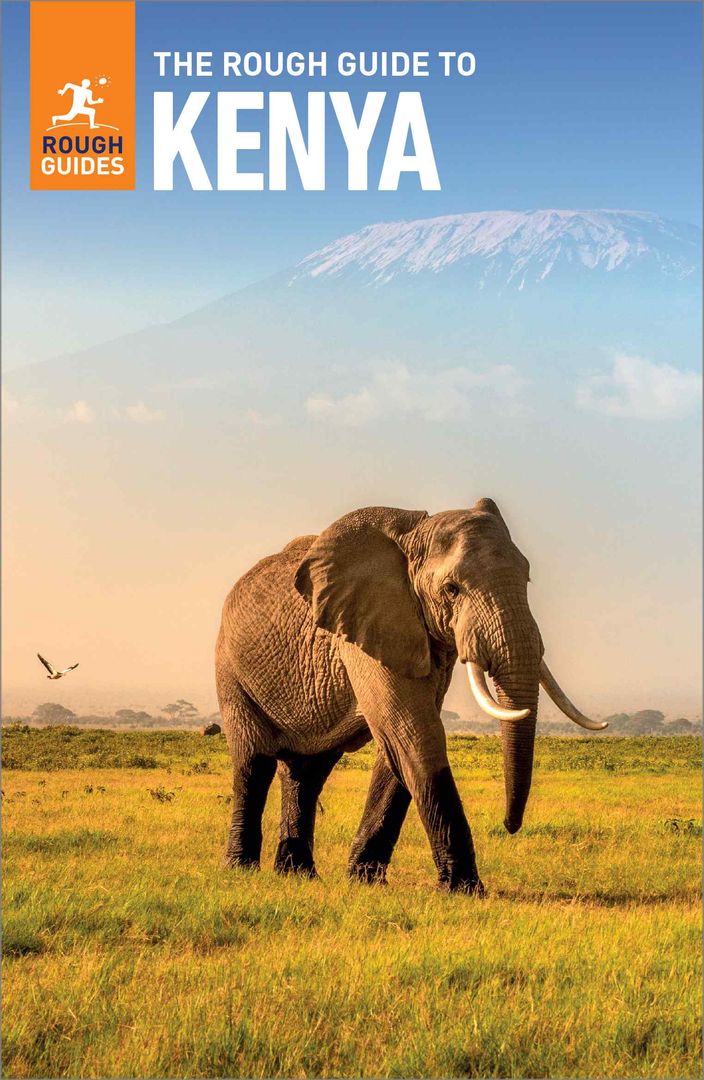
You might also love
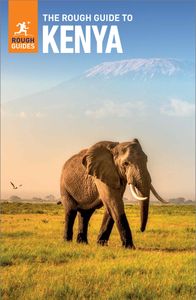
Insight Guides Kenya
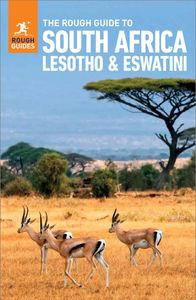
The Rough Guide to South Africa
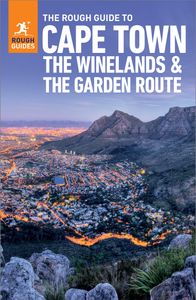
The Rough Guide to Cape Town, Winelands & the Garden Route
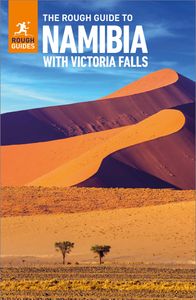
The Rough Guide to Namibia with Victoria Falls
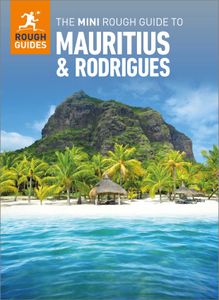
The Mini Rough Guide to Mauritius
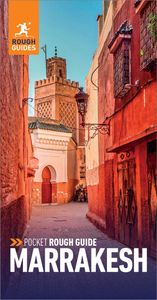
Pocket Rough Guide Marrakesh

Insight Guides Cruising & Cruise Ships 2024
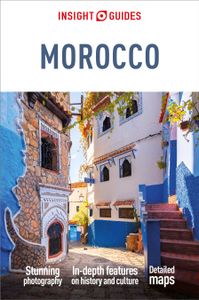
Insight Guides Morocco
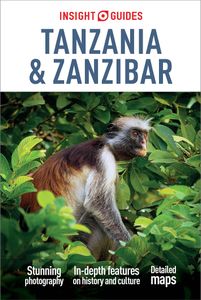
Insight Guides Tanzania & Zanzibar
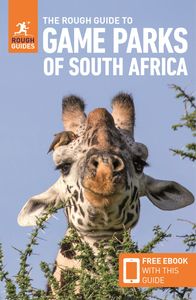
The Rough Guide to the Game Parks of South Africa
Nairobi and around Travel Guide
Book your individual trip , stress-free with local travel experts
Select Month
- roughguides.com
- nairobi-around
- Travel guide
- Itineraries
- Local Experts
- Travel Advice
Accommodation
Plan your tailor-made trip with a local expert
Book securely with money-back guarantee
Travel stress-free with local assistance and 24/7 support
We really got to be "on vacation" and just take it all in, knowing that you had everything planned and organised.
Easily the largest city in East Africa, Nairobi is also the youngest, the most modern, the fastest growing and, at nearly 1700m altitude, the highest. The superlatives could go on forever. “Green City in the Sun”, runs one tour-brochure sobriquet, “City of Flowers” another. Less enchanted visitors growl “Nairobbery”. The city catches your attention, at least: this is no tropical backwater. Most roads in Kenya, particularly paved ones, lead to Nairobi and, like it or not, you’re almost bound to spend some time here. Strolling around the malls in Westlands or negotiating Kenyatta Avenue at rush hour, it’s also perhaps easy to forget how quickly you can leave the city and be in the bush.
Arts and entertainment
Bars, clubs and music venues, birdwatching in nairobi, central nairobi.
Nairobi National Park
The National Museum
Ngong hills, the southern rift valley.
Apart from being the safari capital of the world, Nairobi is an excellent base for Kenyan travel in general. To the coast, it’s as little as six hours by road, an overnight train journey, or an hour if you fly. It takes about the same time to get to the far west and barely two hours to get to the great trough of the Rift Valley or the slopes of Mount Kenya .
Nairobi County, an area of some 690 square kilometres, ranging from agricultural and ranching land to savanna and mountain forest, used to stretch way beyond the city suburbs, but the city is increasingly filling the whole county. For visitors, most of the interest around Nairobi lies to the south and southwest, in the predominantly Maasai land that begins with Nairobi National Park , literally on the city’s doorstep – a wild attraction where you’d expect to find suburbs, it makes an excellent day-trip – and includes the watershed ridge of the Ngong Hills just outside the city in neighbouring Kajiado County. It’s a striking landscape, vividly described in Karen Blixen’s Out of Africa . Southeast, beyond the shanty suburb of Dandora, are the wide Athi plains , which are traditionally mostly ranching country but nowadays increasingly invaded by the spread of Nairobi’s industrial and residential satellites. In the southwest, meanwhile, a much overlooked trip to Lake Magadi takes you into a ravishingly beautiful and austere part of the Rift Valley.
Brief history
Nairobi came into being in May 1899, an artificial settlement created by Europeans at Mile 327 of the Uganda Railway, then being systematically forged from Mombasa on the coast to Port Florence – now Kisumu – on Lake Victoria. Although called the “Uganda Railway” there was no connection to Kampala until 1931; before that, Lake Victoria ships provided the link.
Nairobi was initially a supply depot, switching yard and camp ground for the thousands of Indian labourers employed by the British. The bleak, partly swampy site was simply the spot where operations came to a halt while the engineers figured out their next move – getting the line up the steep slopes that lay ahead. The name came from the local Maasai word for the area, enkare nyarobi , “the place of cold water”, though the spot itself was originally called Nakusontelon , “Beginning of all Beauty”.
Surprisingly, the unplanned settlement took root. A few years later it was totally rebuilt after the burning of the original town compound following an outbreak of plague. By 1907, it was so firmly established that the colonists took it as the capital of the newly formed “British East Africa” (BEA). Europeans, encouraged by the authorities, started settling in some numbers, while Africans were forced into employment by tax demands (without representation) or onto specially created reserves – the Maasai to the Southern Reserve and the Kikuyu to their own reserve in the highlands.
Nairobi’s districts and suburbs
The capital, lacking development from any established community, was somewhat characterless in its early years – and remains so. The original centre retains an Asian influence in its older buildings, but today it’s shot through with glassy, high-rise blocks. Surrounding the core of the old Central Business District is a vast area of suburbs: wealthiest in the west and north, increasingly poor to the south and east.
The names of these suburbs – Karen, Parklands, Eastleigh, Spring Valley, Kibera, among many others – reflect the jumble of African, Asian and European elements in Nairobi’s original inhabitants, none of whom were local. The term “Nairobian” is a relatively new one that still applies mostly to the younger generation. Although it has a predominance of Kikuyu, the city is not the preserve of a single ethnic group, standing as it does at the meeting point of Maasai, Kikuyu and Kamba territories. Its choice as capital, accidental though it may have been (the Kikuyu town of Limuru and the Kamba capital, Machakos, were also considered), was a fortunate one for the future of the country.
Since the 1990s, the Central Business District has seen the steady flight of businesses into the suburbs, particularly to Upper Hill and the surrounding districts to the west of the CBD; to the booming satellite city of Westlands , just a couple of kilometres to the northwest; and for kilometre after kilometre out along the Mombasa road to the south. Just in the last few years, however, regeneration efforts in the CBD have begun to pay off. It’s not quite like the rebirth of central Johannesburg, but businesses and nightlife are returning to a district that feels safer and more habitable than at any time in the last two decades.
Travel ideas for Kenya, created by local experts

11 days / from 3089 USD
Bush To Beach Safari
Explore Kenya's vast national parks such as Lake Nakuru, the famous Maasai Mara and the well-known 'red' elephants in the Tsavo National Park. After a few days of waking up early to spot wildlife, relax on the fine sandy beaches of Diani in the Mombasa area.

10 days / from 4059 USD
Best of Kenya & Tanzania
A fascinating trip across the Maasai Mara and the Serengeti and Ngorongoro Conservation Areas in Kenya and Tanzania. Learn more about the traditions and cultures of the Maasai and stare in awe at the wild roaming wildlife on your several game drives in different national parks.

7 days / from 2791 USD
Family Safari in Kenya
Take your (grand)children and embark on the adventure of a (family) lifetime: 7 days in Kenya, with up-close animal encounters, game drives to see the Big 5 and plenty of fun day activities.
It isn’t difficult to find accommodation in Nairobi, but it can be very expensive. The main question is which area fits your needs. The Central Business District is useful for accessing shops and some offices on foot (though many businesses, embassies and other offices are not located here), while if you base yourself further afield, you’re likely to need transport or have to rely on the nearest mall. Travellers congregate at a number of different spots around the city and many visitors never set foot in the downtown CBD. If you’re arriving in town in the small hours or early in the day, it’s worth knowing that most places won’t be able to offer you a room before 10am. Bear in mind, too, that a/c is not considered essential in Nairobi’s climate and you’ll only find it at top-end addresses, which also uniformly offer free room safes.
All the top-of-the-range places and most backpacker haunts have guarded or enclosed parking – only cheap, city-centre lodgings are a problem in this respect. Naturally, leave nothing of value in the vehicle, or attached to it – such as spare wheels, jerricans or roof boxes. Wi-fi is increasingly widespread in Nairobi, and all but the cheapest hotels should have it.
After years of stagnation, the Nairobi arts scene seems to be finally finding a rhythm of its own, independent of the tourist market, which had previously driven much of it. Although still modest by international standards, it is well worth discovering. Besides checking out the theatres and arts centres listed below, your first base should be the excellent arts-scene blog w nairobinow.wordpress.com , which posts news of up-and-coming performers, shows and events. Also worth having a look at are the theatre pages in the Thursday edition of the Standard and the Nation on Friday and Saturday.
Promoting bands in Nairobi is as precarious a business as anywhere and, given the volatile nature of the music business, venues and bands change at a moment’s notice. Check out w nairobinow.wordpress.com , upnairobi.com and w facebook.com (most clubs and bands have a Facebook account even if they have no website) and look at the Nation newspaper on a Friday and Saturday for one-off gigs. Most clubs are open nightly and often on weekend afternoons – and in some cases never close at all. Starting times vary considerably for live music: on weekdays, 8pm wouldn’t be too early to turn up, while at weekends even the warm-up act may not begin before 10pm, and some shows may not get rolling until midnight. Earthy, local clubs have free entry or very cheap entrance fees, while in the glitzier places, men still sometimes pay more than women; around Ksh200–400 as against Ksh100–200. There are some interesting bars in the city’s fancier hotels, where there may be a minimum bill.
Birdwatching need not be exclusively a bush pursuit. For any visitor staying in central Nairobi, an impressive sight during the early morning and late evening is groups of black kites circling as they move between feeding and roosting sites, and among these are readily identified black-and-white pied crows . Marabou storks , sacred ibises and silvery-cheeked hornbills can sometimes be seen flying over the city (dramatically large marabous may also be seen in the thorn trees on Uhuru Highway, near Nyayo Stadium), while flocks of superb starlings call noisily from office buildings. The leafier areas of the city are likely to produce even more birds.
The gardens in the grounds of the Nairobi National Museum are an interesting and relatively safe area to start birding. Here, keen birdwatchers may encounter sunbirds (variable and Hunter’s) and the cinnamon-chested bee-eater . Another bird of the gardens is the African paradise monarch , a species of flycatcher. In breeding plumage, the rufous males have long tail streamers, which trail behind them like ribbons as they flit from tree to tree.
Nature Kenya organizes bird walks from the National Museum every Wednesday morning at 8.45am for a temporary membership fee of Ksh200. They usually proceed to another part of Nairobi. Longer trips are also offered at least once a month. For more information, contact Nature Kenya at the museum ( t 020 3537568 or t 0771 343138).
The “old” heart of downtown Nairobi may only date back a little over a century, but there is still enough here to while away a morning or afternoon while you decide what you think of modern Kenya. The Central Business District is not the most cosmopolitan part of the city – that dubious honour would have to be shared between several suburban malls – but after the dark, anti-democracy period in the 1980s and the collapse of security in the 1990s, twenty-first-century central Nairobi is beginning to feel like a world-class city again. One advantage of strolling around here in the daytime is that if you choose to check out the CBD’s nightlife, you’ll have some idea of where you are.
Kibera is a sprawling mass of shacks, just a few kilometres southwest of Nairobi’s city centre. It was long thought to be the largest shanty town in sub-Saharan Africa, home to around one million people; although recent mapping exercises have dramatically reduced the estimated number of residents down to as few as 250,000, the scale of the place can still be difficult for most Westerners to imagine. The slums were a flashpoint during the post-election violence in January 2008, when protestors torched buildings and uprooted the Nairobi–Nakuru railway line that runs right through Kibera, and the area is still the scene of occasional politically motivated riots. There have been no major incidents since, however, and although it’s perhaps best not to just wander down there, it’s safe to visit if you’re accompanied by local residents or NGO workers – a number of local operators even offer morning excursions to the area.
Kibera started at the end of World War I as a village housing Sudanese Nubian soldiers of the demobilized armies of British East Africa. Subsequently, as rural-to-urban migration increased, people moved into the area and began putting up mud-and-wattle structures. Today most residents live in makeshift huts , typically measuring 3m by 3m, with an average of five people per dwelling. Access to electricity, running water and sanitation ranges from zero to very minimal – the occasional makeshift pit latrines are shared between anything from ten to one hundred homes, though foreign donors have constructed some new toilet blocks. The streets are a mass of seemingly endless trenches, alleyways and open gutters clogged with waste and sewage. As well as lacking even the most basic services, Kibera has an HIV infection rate of between fourteen and twenty percent, and the number of orphans rises daily. However, the slum somehow works and is full of small businesses , from video cinemas to bakeries. Few residents buy newspapers or own TVs; the community radio station Pamoja FM (99.9 FM) provides a vital “glue” that helped prevent Kibera from ripping apart.
When booking an escorted visit to Kibera, make sure before you sign up that you know exactly where your money is going: some businesses are not above running “pro-poor” tourism as part of their activities while pocketing much of the cash supposed to be supporting slum projects. As you visit various premises and community projects, you should find the experience deeply affecting, if not enjoyable, and not without its lighter moments. Good options for a tour include: Kibera Tours or Explore Kibera Tours.
Security in Nairobi
Nairobi isn’t nearly as bad as its “Nairobbery” reputation would suggest. The city has cleaned up considerably over the past few years: the city centre is less threatening, there are fewer street children, beggars and touts, and a dedicated tourist police force patrols the streets. That said, it pays to take some precautions against crime. It helps to memorize any route you’re walking, as lost-looking tourists are easier targets. Keep your hands out of reach, as a handshake can sometimes throw you off guard, and be – rationally – suspicious of everyone until you’ve caught your breath. It doesn’t take long to get a little streetwise. Every rural Kenyan coming to the city for the first time goes through exactly the same process.
At night , be extra vigilant if you’re walking in the city centre and don’t wander outside the CBD unless you’re really clued-up. Be especially wary in the River Road district , which in practical terms means anything east of Moi Avenue, and indeed sometimes including the avenue. Even some locals avoid walking there and taxi drivers are quite often reluctant to venture into certain parts of the district. Obviously don’t walk through the parks at night.
All the main bus and matatu stations are somewhat chaotic and ideal for pickpockets and snatch-and-run robberies. If you’re driving or being driven , avoid displaying phones and cameras and laptops, and keep your windows rolled up, especially at traffic lights.
Nairobi has no shortage of eating places. Their diversity is one of the city’s best points, and eating out is an evening pastime that never dulls. Admittedly, anything like authentic Kenyan food is generally not highlighted in most restaurants, which concentrate on offering a range of Asian and European cuisines, and spectacular quantities of meat. Included below are one or two of the city’s fancier hotels , where the food has a good reputation. For further eating listings , check out the bars and nightlife section, which includes a number of venues that double as restaurants. When assessing prices (or checking your bill) remember there’s a two percent training levy and sixteen percent value-added tax (VAT) on food and drink in all but the smallest establishments. Some include or add a variable service charge as well, which could raise the actual food and drink price by a further eight to ten percent. Most places include these taxes and charges in their menu prices, but some don’t. At the more upmarket restaurants in the following listings, it’s often a good idea to reserve a table or, as an alternative to calling yourself, try the free services of Eat Out Kenya , a Nairobi-based online startup that makes restaurant bookings for you via your mobile.
Notwithstanding the hype, it really is remarkable that the plains and woodland making up
should exist almost uncorrupted within earshot of Nairobi’s downtown traffic, complete with more than eighty species of large mammals, including all the giant savanna species with the exception of the elephant. It boasts the greatest density of
of any city park in the world. There is, in fact, no comparable park anywhere. In contrast to the pitted streets of the city, gridlocked with traffic, the park is a haven of tranquil wilderness where humans have only temporary landing rights.
The park is a good place to spend time during a flight layover, or before an afternoon or evening flight, and you have a high chance of seeing certain species, especially black rhino, which might well elude you in the bigger Kenyan parks. Although it is fenced along its northern perimeter, the park is open to the south, in theory allowing migrating herds, and the predators that follow them, to come and go more or less freely. For all the low-flying planes and minibuses, you have a greater chance of witnessing a kill here than in any other park in Kenya.
The Nairobi migration
Until the end of the twentieth century, the Nairobi National Park witnessed the second-largest herbivore migration after that of the Mara and Serengeti, with thousands of wildebeest and zebra streaming in from the south in July and August for the good grazing. Before 1946, when the park was created, only the physical barrier of Nairobi itself diverted what was a general northward migration on towards the Aberdare range and the foothills of Mount Kenya. The erection of fences along the park’s northern perimeter closed that migration route, while the steady encroachment of housing, industry, farms and livestock grazing along the southern boundary is also tightening the wildlife corridor there. The wildebeest you see nowadays are mostly sedentary individuals that stay in the park all year, and the migration has been reduced, in most years, to a trickle. Conservationists are, however, determined to keep the southern corridor open, claiming that to fence the park (partly a response to fears about lion and rhino poaching) would effectively suffocate its ecosystem, which depends on free-ranging wildlife to be sustainable. The “Friends of Nairobi National Park” ( t 0723 690686) have the full story on this and much more about the park.
The David Sheldrick Wildlife Trust
The David Sheldrick Wildlife Trust elephant and rhino orphanage, inside the western end of the park, offers a chance to see staff caring for baby elephants, and sometimes baby rhino, which have been orphaned by poachers, or have been lost or abandoned for natural reasons. The trust is run by Daphne Sheldrick in memory of her husband, the founding warden of Tsavo National Park, and, during the hour-long open house, the elephant keepers bring their juvenile charges up to an informal rope barrier where you can easily touch them and take photos.
After many years of trial and error, Sheldrick and her staff have become the world’s experts on hand-rearing baby African elephants, sometimes from birth, using a special milk formula for the youngest infants and assigning keepers to individual 24-hour guardianship of their charges, a responsibility that includes sleeping in their stables. Without the love of a surrogate family and plenty of stimulation, orphaned baby elephants fail to thrive: they can succumb to fatal infections when teething, and, even if they survive, can grow up disturbed and unhappy and badly prepared for reintroduction to the wild.
Rehabilitation is one of the Sheldrick Trust’s major preoccupations. For rhinos, which mature at twice the speed of elephants, this involves a year or more of walks with their keeper, introducing the orphan’s scent, via habitual dung middens and “urinal” bushes, to the wild population. Many of Nairobi National Park’s rhinos grew up in the Sheldrick nursery; the last surviving member of Amboseli’s famous long-horned rhino herd was rescued by the Trust in 1987 and is now a successful breeding female, having been released in Tsavo East. In the case of elephants, which mature at about the same rate as humans, the process of reintroduction is more attuned to the individual: outgoing animals are encouraged while young to meet wild friends and potential adoptive mothers, again through walks with their keepers, most often in Tsavo National Park. More traumatized elephants take longer to find their feet. Matriarchs who were Sheldrick orphans themselves, such as Eleanor at Tsavo East, have been responsible for adopting many returnees.
In 2008, the
Nairobi National Museum
reopened its doors after a three-year, Ksh800 million facelift. The refurbished result is a still partly sparkling, showpiece attraction and a good prelude to any tour around the country. It’s easy to reach from the centre of town and provides a solid overview of Kenya’s culture, history and wildlife.
Hall of Kenya
This expansive entry hall into the museum is sparsely appointed with some of Kenya’s most impressive and unusual artefacts and artworks. In one display case is a Swahili siwa from the 1680s. The siwa , a ceremonial horn intricately carved from an elephant tusk, was traditionally blown on celebratory occasions as a symbol of unity and was considered to possess magical powers. There is also a sambu , a Kalenjin elder’s cloak made from the skins of Sykes’ monkeys. Beautiful photos of some of Kenya’s animals adorn the wall of this hall, and prepare you for the next gallery.
The Great Hall of Mammals
Dedicated to Africa’s charismatic, endangered megafauna , and the plains animals that are still found in some abundance in Kenya, this hall features some impressive dioramas. In the centre of the room are examples of a giraffe, an elephant, a buffalo, a zebra and an okapi, the strange forest-dwelling relative of the giraffe found only in the jungles of the Democratic Republic of Congo. Along the walls are displays of most of Kenya’s mammals, including the big cats, primates and antelopes, with explanations of their habitats, diets and life cycles. Also displayed in this gallery is the skeleton of Ahmed , the most famous of the giant-tusked bull elephants of Marsabit, in the north of the country. In the 1970s, when poaching was rampant in northern Kenya, conservationists feared that Ahmed would be targeted because of his enormous tusks. Kenya’s first president, Jomo Kenyatta, assigned two rangers to track Ahmed day and night until he died of natural causes at the age of 55. His tusks weighed in at 68kg (150lb) each. There’s a life-size replica of Ahmed in the courtyard between the entrance and the shop.
Just off the Hall of Kenya gallery is a room devoted to ornithology , featuring 1600 specimens in glass cases. Kenya’s birdlife usually makes a strong impression, even on non-birdwatchers. Look out for the various species of hornbill, turaco and roller, and for the extraordinary standard-wing nightjar, which is frequently seen fluttering low over a swimming pool at dusk, hunting for insects.
The Cradle of Human Kind
The unique interest of the Nairobi museum lies in the human origins exhibit, where paleontology displays are housed. Along the walls, skeletons and skull casts of ancient hominins trace primate diversity and the evolution of the human species back millions of years. Of particular importance is the almost complete skeleton of “Turkana Boy”, the 1.6-million-year-old remains of an immature male hominin found near Lake Turkana. Hardcore paleontology fans will want to visit the Hominin Skull Room , which contains the skulls of some of our ancient ancestors and non-ancestral cousins, such as Homo erectus . The understanding of human evolution is itself a rapidly evolving field, with new theories about human origins and ancestry appearing almost yearly, but East Africa is invariably its field-research location.

Cycles of Life
Upstairs, next to the temporary galleries of local art, the Cycles of Life exhibit covers Kenya’s tribes and cultures, in neatly laid out displays of artefacts telling the story of each ethnic group from childhood through adulthood to ancestor status. If you’re planning on travelling through any of the areas inhabited by pastoral peoples (especially Pokot, Samburu, Maasai or Turkana), then seeing some old and authentic handicrafts beforehand is a good idea.
The room begins with a display of traditional birthing methods and child-rearing techniques, including a traditional Pokot child carrier made from monkey skin and children’s toys made from discarded scraps of metal. The exhibit moves on to explain initiation and circumcision rituals. On display here is a Maasai warrior outfit, complete with spear and shield. The adulthood display contains various clothing and beauty products including beaded necklaces and earplugs used by some of the semi-nomadic tribes to stretch the earlobes. A display of grave markers and artefacts used to send someone into the afterlife marks the end of the exhibit.
The town of NGONG , the jumping-off point for the Ngong Hills, is 8km beyond Karen shopping centre; turn right after the police station in Ngong. If you have the chance, stop on the way at Bulbul, 4km from Karen, and take a look at the pretty mosque of this largely Muslim village. As often happened in Kenya, Islam spread here through the settlement of discharged troops from other British-ruled territories, in this case from Nubia in Sudan. Ngong itself is basically just a small junction town with limited shops and services and the rough D523 road trailing out to the west towards the Maasai Mara.
The Ngong Hills are revered by the Maasai, who have several traditional explanations of how they were formed. The best-known says that a giant, stumbling north with his head in the clouds, tripped on Kilimanjaro. Thundering to the ground, his hand squeezed the earth into the Ngongs’ familiar, knuckled outline. An even more momentous story explains the Ngongs as the bits of dirt left under God’s fingernails after he’d finished creating the earth.
The walk along the sharp spine of the Ngong Hills was once a popular weekend hike and picnic outing, easily feasible in a day, although, unfortunately, the hills got a reputation for muggings in the 1980s, curtailing independent expeditions, and KWS rangers usually now provide an escort. The views , of Nairobi on one side and the Rift Valley on the other, are magnificent, and despite the wind farm at the northern end of the hills, the forested slopes are still inhabited by buffalo and various species of antelope. With a car – and it has to be 4WD if it’s been raining – you can get to the summit, Point Lamwia (2459m), which offers a 360-degree view. If you want to walk , and are reasonably fit, allow a minimum of three hours to get to the top and back to your car. Alternatively, you could organize transport to meet you west of Kiserian, on the C58 Magadi road, and spend four to five hours traversing the length of the peaks, a walk of about 15km.
On the ridges below the summit, on privately owned land, almost due east of the highest point, is the Finch Memorial , Karen Blixen’s tribute to the man who took her flying.
It doesn’t take long to realize that commerce is Nairobi’s raison d’être . Nairobi is the best place in East Africa to buy handicrafts , with the widest, if not the cheapest, selection, and the city also has some lavish produce markets , enjoyable even if you only want to browse. The upper part of Moi Avenue is Nairobi’s busiest ordinary shopping street, with some colonnaded shop-fronts still remaining. A certain amount of bargaining is expected at all Nairobi’s markets and many independent shops.
The journey south from Nairobi down into the hot, sparsely inhabited southern districts of the Rift Valley takes you first to the prehistoric site at Olorgasailie , then on to the dramatic salt lake of Magadi , and finally to the Nguruman Escarpment and the remote nature conservancy at Shompole . The scenery opens out dramatically as you skirt the southern flank of the Ngong Hills and descend steeply down the escarpment; if you’re travelling by public transport, try to get a front seat, as giraffe and other animals are often seen.
Lake Magadi and around
Lying in a Rift Valley depression 1000m below Nairobi, Lake Magadi is a vast shallow pool of soda (sodium carbonate), a sludge of alkaline water and crystal trona deposits, and one of the hottest places in the country. Magadi is also the second-largest source of soda in the world, after the Salton Sea in the USA. At Magadi, the Magadi Soda Company – formerly an ICI business, now owned by the Indian company Tata – operates the very model of a company town , on a barren spit of land jutting out across the multicoloured soda. The company’s investment here is guaranteed – hot springs gush out of the earth’s crust to provide an inexhaustible supply of briney water for evaporation. Everything you see, apart from the homes of a few Maasai on the shore, is owned and run by the corporation. You pass a company police barrier where you sign in and enter over a causeway, past surreal pink salt ponds, often flocked by flamingos. Now on company territory, a sign advises visitors that “it is dangerous to walk across the lake surface”, just in case you were contemplating a stroll across the soda. Note that some of the company police are touchy about you taking photos of the factory installations. Despite this, the atmosphere here, somewhat surprisingly because of the nature of the work and harshness of the environment, is relaxed and welcoming. By comparison with the rest of Kenya, the company pays its 700 staff high wages, starting at around Ksh40,000 per month; people tend to get drunk a lot, and staff accommodation and many services are free.
Many visitors come to Magadi specifically for its birdlife . There’s a wealth of avifauna here, including, usually, large numbers of flamingos at the southern end of the lake. At this end, there are also freshwater swamps, which attract many species.
Olorgasailie Prehistoric Site
Between 400,000 and 500,000 years ago, the wide, shallow lake east of what is now
was inhabited by a species of hominin, probably
Homo erectus
of the Acheulian culture (after St Acheul in France, where it was first discovered). The site is endowed with numerous pathways, boardwalks and informative signs, and is a peaceful place to stay, though most people just stop here for an hour or two. The guided tour around the excavations (included in the entrance charge, tip welcomed) is not to be missed. The museum and accommodation are just above the excavations, on a ridge overlooking the former lake.
The early people who lived at Olorgasailie made a range of identifiable stone tools: cleavers for skinning animals; round balls for crushing bones, perhaps for hurling or possibly tied to vines to be used, like gauchos, as bolas ; and heavy hand axes, for which the culture is best known, but for which, as Richard Leakey writes, “embarrassingly, no one can think of a good use”. The guides tell you they were used for chopping meat and digging. This seems reasonable, but some are very large, while hundreds of others (particularly at the so-called “factory site”) seem far too small, the theory being that they were made by youngsters, practising their toolmaking.
Mary and Louis Leakey’s team did most of the unearthing here in the 1940s. Thousands of the stone tools they found have been left undisturbed, in situ , under protective roofs. Perhaps the most impressive find, however, is the fossilized leg bone of an extinct giant elephant , dwarfing a similar bone from a modern elephant placed next to it. It was long hoped that human remains would also be uncovered at Olorgasailie, but despite extensive digging none has been found – providing more scope for speculation.
Today, sitting with a pair of binoculars and looking out over what used to be the lake can yield some rewarding animal-watching , especially in the brief dusk. Go for a walk out past the excavations towards the gorge and you may see baboons, duiker, giraffe, eland and even gerenuk if you’re lucky – Olorgasailie is the westernmost extent of their range in southern Kenya.
Discover more places in Kenya

- Travel Guide Morocco
- Travel Guide Namibia
- Travel Guide South Africa
- Travel Guide China
- Travel Guide India
- Travel Guide Indonesia
- Travel Guide Japan
- Travel Guide Laos
- Travel Guide Malaysia
- Travel Guide Myanmar (Burma)
- Travel Guide Nepal
- Travel Guide Philippines
- Travel Guide Singapore
- Travel Guide South Korea
- Travel Guide Sri Lanka
- Travel Guide Taiwan
- Travel Guide Thailand
- Travel Guide Australia
- Travel Guide Fiji
- Travel Guide New Zealand
- Travel Guide Belize
- Costa Rica Travel Guide
- Travel Guide Cuba
- Travel Guide Guatemala
- Travel Guide Honduras
- Travel Guide Jamaica
- Travel Guide Nicaragua
- Travel Guide Panama
- Travel Guide Puerto Rico
- Travel Guide Trinidad and Tobago
- Travel Guide Albania
- Travel Guide Austria
- Travel Guide Belgium
- Travel Guide Bosnia-Herzegovina
- Travel Guide Bulgaria
- Travel Guide Cyprus
- Travel Guide Czechia (Czech Republic)
- Travel Guide Denmark
- Travel Guide England
- Travel Guide Estonia
- Travel Guide Finland
- Travel Guide France
- Travel Guide Germany
- Travel Guide Greece
- Travel Guide Hungary
- Iceland Travel Guide
The Rough Guides to Kenya and related travel guides
In-depth, easy-to-use travel guides filled with expert advice.

Find even more inspiration here

Planning your own trip? Prepare for your trip
Use Rough Guides' trusted partners for great rates
written by Rough Guides Editors
updated 26.04.2021
Ready to travel and discover Kenya?
Get support from our local experts for stress-free planning & worry-free travels.
- Travel advice
- Where to stay
Travel Itineraries | Luxury Travel | Travel Tips
The 7 Day Nairobi Travel Itinerary and Guide

The Best of Nairobi in One Week – A Travel Itinerary
This 7 Day Nairobi and Surrounding travel itinerary is designed keeping the following factors in mind:
- Fly in and Fly Out from Nairobi Jomo Kenyatta Airport
- Hire a car or book a car and driver (Nairobi roads can be hazardous)
- Have 8 days in your hand
Nairobi is the capital city of Kenya. It is a buzzing, hustling, vibrant, gritty and chaotic place. It sits in the Kenyan highlands on top of the Great Rift Valley. Populated by colonists in the 18th for its cooler climate, the rains and fertile highlands made it a prime spot for European settlers who suffered under the scorching African sun.
Nowadays Nairobi is no longer a sleepy village, it is the third-largest economy in Africa and the city is expanding at a huge rate. Everywhere you will see tower blocks emerging, restaurants and bars being opened, and swarms of tourists heading to world-famous sights. But Nairobi isn’t a city of ancient architecture and pristine plazas. Nairobi is famous for its animals. And it is the only city in the world with a National Park in the city bounds. Nairobi is also one of the destinations that is perfect for both – a family vacation as there are lots of things to do with kids in Nairobi , most of which are mentioned in this Nairobi Travel Guide as well ; or a budget backpacking holiday ! For some really amazing budget travel hacks for Nairobi and Kenya, do check out this Kenya Budget Travel Guide !
Nairobi National Park is 100 sq km right in the city where wild animals are free to roam and to come and go as they please. 4 of the big 5 (lion, leopard, rhino and buffalo) are in the park, elephants had to be relocated due to human-wildlife conflict. In Nairobi, animals aren’t just confined to the park, you see giraffes on the way to work, warthogs on the school playing fields and monkeys in your garden.
Animals and humans coexist in a way that is special and unique to this vibrant African city.

Day 1 – Nairobi
Day 2 – david sheldrick wildlife trust and giraffe manor, day 3 – safari at nairobi national park , day 4 – drive to naivasha & visit crescent island , day 5 – naivasha – hells gate, day 6 – naivasha – take a boat tour and visit crater lake , day 7 – return to nairobi & visit spinners web, where to stay in nairobi, when to visit nairobi , things to shop in nairobi to remind you of your trip to kenya, summary of the 7 day nairobi travel itinerary, share this:.
Land at Jomo Kenyatta International airport , make your way to your accommodation in the leafy suburb of Karen. Karen is on the outskirts of Nairobi, close to the wildlife points and filled with many fabulous shops and restaurants.
Relax by the pool, take a walk in Ololua Forest and have dinner at the unbeatable Talisman restaurants. If it’s a Friday you’ll find locals dancing to the local DJ until the early hours of the morning. The best way to kick off your epic trip to Kenya and Nairobi.

Start the Day 2 of your epic 7 day trip to Nairobi, by visiting the David Sheldrick Wildlife Trust . This charitable organisation rescues orphaned elephants from all over Kenya and Tanzania and rehabilitates them before returning them to the wild. Visit DSWT to meet the most adorable baby elephants, spend time getting to know them and meet their keepers and trust owners who will happily share information on the work that the trust does.
Stop for lunch at craft centre Utamaduni.
Visit the Giraffe Centre and Sanctuary. This charity rescues the endangered Rothschild Giraffe and provides them with a place of safety in the sanctuary. Visit the Giraffe Centre, meet the giraffe and feed them by hand. Get up close and personal to these gentle giants on raised platforms. Although these are wild giraffes they are used to visitors.

The third day of this 7 day Nairobi Travel Itinerary is reserved for a full day safari at Nairobi National Park .
The park may be small but it packs a punch; lion, leopard, hyena, cheetah, rhino, hippo, crocodiles, jackals and many more live in the park. As traditional corridors are open and animals are free to come and go, you have the opportunity to see most Kenyan wildlife here, except for elephants . There are various habitats across the park, from savannah to marsh, rivers and lakes to dense woodland. Stop for lunch at the KWS clubhouse and stay in the park for the full day.

Naivasha is a thrilling 90-minute drive from Nairobi. The view as you drive down the Great Rift Valley is awe-inspiring; volcanoes rise from the bottom of the rift and eagles soar across its expanse.
Spend the afternoon on a walking safari at Crescent Island. This crescent-shaped peninsula sticks out into Lake Naivasha. The lake hosts vast numbers of hippos, which frequently come onshore at Crescent Island. The sanctuary allows animals free access and you will get the opportunity to walk alongside giraffe, zebra, oryx, kudu, eland, Thompson gazelle, wildebeest, impala as well as buffalo and possibly hyena. Be wary of the hippos, hyena and buffalo.

Hells Gate National Park is the park on which the Lion King movie was based. A dramatic volcanic landscape of peaks and valleys, caves, rivers and its infamous gorge. Essentially a wildlife sanctuary – the park is largely filled with Kenya’s more friendly animals; Zebra, Hartebeest Thomson’s Gazelle, Klipspringer, Antelope and Reedbuck, although there are buffalo too and the odd Leopard and Lion may haunt the mountains. Hell’s Gate is named for its geothermal activity ; hot springs and plumes of scalding steam are a common site and huffing, puffing, belching park that is an experience not to be missed.

Spend the day on the lake. Take a boat tour and get up close and personal with the hippos. You can tour the entire lake where experienced guides will navigate your stomach clenchingly close to huge hippo families. The lake has amazing birdlife, eagles and herons in huge numbers as well as the fiercely ugly marabou stork.
In the afternoon visit the dormant crater lake volcano. A jade-green lake fills the pit on the extinct volcano. Visit the sanctuary with its many trails up and around the volcano, the park is filled with game and has views all over the rift and Naivasha surrounds.
Return to the top of the rift and back to Nairobi.
Spend your last afternoon shopping for souvenirs at the wonderful Spinners Web . A huge house filled with treasures from all over Africa. Pick up Maasai beads, wooden carvings, woven rugs, reed bowls and vibrant clothing and jewellery. Enjoy lunch in the greenhouse before returning to your hotel.
Tourists may prefer to stay in the outer suburbs of Karen and Langata where the Elephant Orphanage and Giraffe Centre are situated and there is easy access to Nairobi National Park.
Karen Gables
This Cape Dutch-inspired boutique hotel is situated down a quiet lane at one of the most prestigious addresses in Nairobi. Once inside you are spirited away from city life into a world of tinkling streams and nature-filled gardens.
Hemmingways Nairobi
Part of a collection of elite hotels it’s hard to imagine that this grand plantation hotel has only 45 rooms. Its elegance and serenity are unmatched in Nairobi. It houses an excellent restaurant, a sundowner bar with views over the Ngong Hills and an onsite spa and pool.
Nairobi is in the highlands and the weather is considerably cooler than the rest of Kenya. In the long rains – April to June it can become quite cold and the rains can be long and frequent. In the short rains- October to November the rains are more sporadic, often sunny days with rainy evenings and nights. For the rest of the year, the weather is mostly hot and sunny. It can get very warm during the summer months of Dec-March.

# Maasai beaded products- animals, bags and jewellery
# Maasai Shukas
# Kanga clothing
# Kikoy wraps
# Aberdares tea
# Carved wooden animals
Day 1 – Land in Nairobi
Day 2 – Explore David Sheldrick Wildlife Trust and Giraffe Centre
Day 3 – Safari at Nairobi National park
Day 4 – Naivasha and Crescent Island
Day 5 – Visit Hell’s Gate Park , Gorge and Hot springs
Day 6 – Boat tour on Lake Naivasha and trip to Crater Lake
Day 7 – Return to Nairobi + Visit Spinners Web
Day 8 – Departure from Nairobi
We hope you found this 7 Day Nairobi and surrounding Travel Itinerary , to be of help to you, as a reliable Travel Resource for planning your Trip to Nairobi and Kenya. Don’t forget to Pin these images , and save this One Week Nairobi Travel Itinerary, for future travel planning.

If you enjoyed reading this 7 Day Nairobi Itinerary and Travel Guide , you might want to check out some other 7 Day Travel Guides and Itineraries , as well.
- One Week in Scotland | Travel Itinerary and Travel Guide
- Best of South Africa in 7 Days
- The 7 Day Myanmar Road Trip Itinerary
- One Week in Crete | Greece – Travel Itinerary and Travel Guide
- 7 Days in Israel – A Detailed Travel Itinerary
- 7 Day Road Trip to Bhutan – The Last Shangri La
- One Week in Kerala – God’s Own Country
- The Epic 7 Day Leh Ladakh Road Trip Itinerary
- Best of Netherlands in 7 Days
And if you like reading the content I create and curate, I will be really thankful if you could
LIKE | COMMENT | SHARE and SUBSCRIBE
Also, if you’re on Facebook, I would love to have you as a part of
the Eat Travel Live Repeat Travel Community
Subscribe via Email
Enter your email address to subscribe to this blog and receive notifications of new posts by email.
Email Address
- Kale by LyraThemes.com.
Privacy Overview
Our local experts can design your trip based on your preferences

Warning - You are using an outdated browser. Please upgrade your browser to properly view this website.

- Destinations
- Africa middle east
Nairobi travel guide
The most populous city in East Africa, Nairobi is also the region’s main economic, financial and transportation hub, and the site of its largest concentration of high-rise buildings, oldest and largest stock exchange, and busiest international and domestic airports. Despite its logistical significance, however, Kenya’s traffic-clogged and unabashedly modern capital cannot really be billed as a tourist destination in its own right, but rather as a convenient port of exit and entry, and most leisure travellers spend no longer than a night there at the start and/or end of a safari.
Railway history
Kenya’s capital started life in 1899 as an inauspicious railway depot situated at what was then the temporary terminus of the Uganda Railway from Mombasa. It was set in Maasai grazing grounds that bordered on the higher agricultural land of the Kikuyu, and named after a swampy watering hole called Nkare Nairobi (Place of Cool Water). The site was chosen partly for its pleasant climate and partly for its location midway between the coast and Kampala (the Uganda capital), and though the early years were characterised by regular outbreaks of malaria, exacerbated by a plague epidemic that forced the original town to be burnt and rebuilt, Nairobi officially replaced Mombasa as the colonial capital in 1905.
Booming population
The essential nature of Nairobi has remained cosmopolitan. Today, as ever, settlers from all over Africa, Asia, Europe and North America cohabit here with indigenous Kenyans. The city’s population has grown at a phenomenal rate and is now crowded with more than 3 million people.

Places to visit and things to do in Nairobi
Nairobi national museum.
Museum Hill
Tel: 020 374 2878
www.museums.or.ke
The Nairobi National Museum reopened in 2008 following a long period of closure for renovations. Founded in 1910, it is one of the oldest museums in East Africa, and it houses some truly fascinating artefacts, notably a pair of ivory ceremonial Siwa Horns crafted on Pate Island in 1688, several of Joy Adamson’s famous ethnographic paintings and a collection of 700 hominid fossils, only a few of which are actually on display. An extensive zoological collection includes a life-size replica of the famous elephant Ahmed – the largest tusker in Kenya at the time of independence, and accorded special protection by President Kenyatta – along with a collection of stuffed oddities that are seldom seen in the flesh, for instance aardvark, giant forest hog and okapi (a relative of the giraffe endemic to the Congo). If stuffed animals aren’t your thing, be warned that the adjacent Snake Park is also likely to feel somewhat dispiriting to anybody who enjoys seeing animals alive and unfettered.
Karen Blixen Museum
Karen Road, Karen
Tel: 020 800 2139
www.museums.or.ke/karen-blixen/
The Karen Blixen Museum comprises Karen Blixen’s old house, complete with period furnishings and memorabilia both of her time in Kenya and of the shooting of the film Out of Africa , and it is set within a charming garden that commands a lovely view of the Ngong Hills. The museum staff take visitors on guided tours of the house and grounds, and explain how Blixen managed the coffee plantation.
Nairobi National Park
5km (3 miles) southwest of Nairobi on the Langata Road
Tel: 020 600 0800/600 2345
www.kws.go.ke
The capital’s most-visited tourist attraction is the 117 sq km (45 sq mile) Nairobi National Park, which borders the southeastern suburbs of the city. This remarkable tract of open grassland and acacia savannah is fenced on the city side, in order to protect residents of the capital from regular visitors by lions and other potentially dangerous beasts, but it remains unfenced to the south, allowing the wildlife to move freely between the national park and the bordering Athi Plains.
The park exists because Nairobi stands in an area that once supported prodigious herds of wildlife, comparable in number to the legendary Mara-Serengeti to the southwest. Animals were so prolific in the early days that nightwatchmen along Nairobi’s main thoroughfare (then Station Road, now Moi Avenue) used to be protected within lock-up sentry boxes. A soldier of the time, Col. Richard Meinertzhagen, recalled at least two race meetings being disrupted by rhinos.
The populace may not have wholly welcomed the presence of wild animals in the centre of town, but they seem to have recognised the cachet of having the wildlife around. Most of the Athi Plains were sold and settled, but a large area to the southwest of town was reserved as Nairobi Commonage. A few Somali herdsmen and their families were allowed to live there (as a reward for military service rendered to the Crown), but otherwise the land was left wild. During both world wars the Commonage was taken over as a weapons range, and the wildlife accordingly took a hammering. But in 1945 the land was gazetted a national park – the first in Kenya.
Since then, buffalo and rhino have been reintroduced, so that the full range of the area’s original fauna has been reassembled, with the notable exception of elephant. Today, Nairobi National Park is one of the best places in Kenya to see white rhino, and lion and cheetah are also likely to be encountered stalking the plains. Other wildlife includes eland, impala, Coke’s hartebeest, gazelle, zebra, giraffe and more than 400 species of bird, ranging from colourful weavers and rollers to bulky vultures and prim secretary birds, and it is a good place to seek the localised northern pied babbler. In order to see a good range of wildlife, however, you usually need to dedicate a few hours to the park, ideally starting at 6am, when the entrance gates open and animals are most active, rather than waiting for the more normal post-breakfast departure.
AFEW Giraffe Centre
30 minutes southwest of Nairobi on the Gogo Falls Road
Tel: 020 807 0804
https://giraffecenter.org
The AFEW Giraffe Centre was founded in 1979 by Jock and Betty Leslie-Melville as a private sanctuary to breed Rothschild’s giraffe, a five-horned race that had become – and still is – endangered in the wild. The breeding program here has allowed populations of Rothschild’s giraffe to be established similar to that of Lake Nakuru National Park and the Soysambu, and a breeding group of around a dozen individuals is held on site. It’s popular with children, who can feed specially formulated pellets to these serene giants from a raised observation platform. Other activities include a self-guided bird walk in an adjoining patch of natural forest, and wildlife videos and lectures in the auditorium.
Average customers rating

{{_ "pagesAdmin.destinations.overviewCulturalFeaturesIn"}} {{currentName}}
{{_ "pagesAdmin.destinations.overviewViewAllFeatures"}} {{currentName}}
{{_ "pagesAdmin.destinations.overviewHistoricalHighlights"}} {{currentName}}
{{_ "pagesAdmin.destinations.overviewViewAllHighlights"}} {{currentName}}
Read more from the travel guide to Kenya
- Top attractions
- Historical highlights
- Cultural features
- Plan your trip
- Top restaurants
- Useful phrases

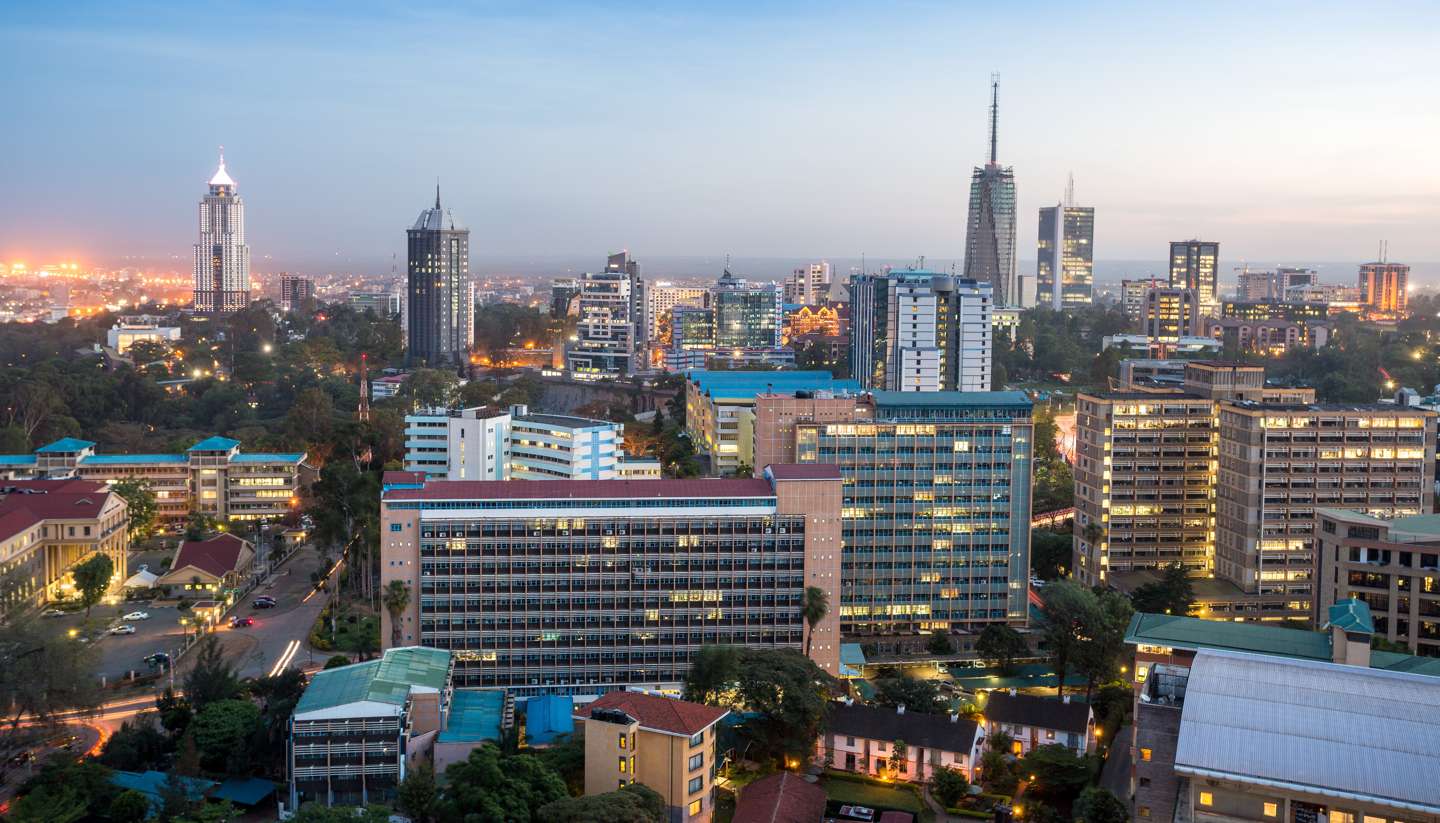
Local time Nairobi
Introducing Nairobi
About nairobi.
- Weather / Best time to visit
- Images of Nairobi
While you’re there
- Getting around
- Attractions, tours and tickets
- Things to see
- Things to do
- Restaurants
Plan your trip
- Travel to Nairobi
Kenya Information
- About Kenya
- Passport & visa
- Public Holidays
- Money & duty free
- Food & drink
Book your flights
- Nairobi Jomo Kenyatta International Airport
Nairobi Travel Guide
Part bustling African metropolis, part explorers' camp, Kenya's capital Nairobi is an intoxicating blend of cosmopolitan culture, gritty, urban slums and thoroughly modern city life.
The gateway to some of the most beautiful stretches of wilderness in the world, Nairobi is never short of tourists, even if most are simply passing through to the Masai Mara in the west or the beaches of Lamu and Malindi in the east.
Founded by the British in 1899, the city began as a dusty railway depot beside a Masai water hole known as Enkare Nyrobi (meaning "cool water"), from which it drew its current name. Today it's one of the largest cities in East Africa and home to scores of international companies and organisations, among them the United Nations Environment Programme (UNEP).
Commercial success has transformed what was once an isolated supply depot into a place of bustling central thoroughfares, 1970s tower blocks, gorgeous public parks and bustling shopping areas crammed with chic boutiques and street traders from all over Kenya.
While there's plenty to see in the city centre, including the imposing parliament building and the city's many galleries, the real excitement is found just outside city limits.
Just seven kilometres (four miles) from the city centre is the Nairobi National Park, where you can get close to lions, impala, wildebeest and elephants, the latter due to the presence of an elephant orphanage within the park, courtesy of the David Sheldrick Wildlife Trust.
Mount Kenya is also a four hour trip from the capital and day trips, although lengthy, are possible. Back in the city, slum tours have become an increasingly popular way to get a glimpse of Nairobi's grittier side, although many aren't as safe as tourists imagine.
Due to the activities of militant groups like Al-Shabaab, safety has become an increasingly pertinent issue when planning a trip to the Kenyan capital. They are primarily active on the land that borders Somalia though, with attacks upon the Capital rare due to tourist hubs being heavily protected.
Nevertheless, provided you take precautions when travelling at night and in poorer suburbs a visit to Nairobi can be an exhilarating experience, and it's well worth spending a few days exploring before heading out on safari.

Book Accommodation
Featured hotels, central ymca.
This is a well-appointed, central hostel in Nairobi. Good-value rooms, reasonable food, swimming pool, tennis courts and an aerobics studio make this feel more like a small hotel, and you don't have to be male or Christian to stay here.
Sentrim 680 Hotel
This reasonably priced mid-range hotel in Nairobi is in a decent location. It is a bit shabby and not much to look at, but is safe, has clean rooms with en-suite bathrooms, useful facilities, a restaurant and its own bar. Rooms facing the main road can cop a bit of noise, so ask for one at the back.
Upper Hill Campsite
Part campsite for overland groups, part backpacker hostel, this expansive place is a hike from the centre of Nairobi, but it makes up for this with excellent facilities. Staff can organise all sorts of safaris and excursions, and the spacious, secure compound has its own bar, restaurant and games room.
Terminal Hotel
A good-value alternative to the backpacker crash pads, the Terminal Hotel in Nairobi is simple but well located. You get what you pay for in terms of luxuries, but the rooms have bathrooms and you can walk to everything in the centre. Ask for a room at the back, away from the street noise.
Giraffe Manor
Where else in the world can you be woken in the morning by a giraffe peering into your bedroom window? Attached to the AFEW Giraffe Centre, this grand Edwardian manor is decked out with Karen Blixen's old furniture, and staying here feels like staying in a posh country home. Factor in fine food and wine and a personal chauffeur and it's easy to see the appeal.
Kenya Comfort Hotel
Well looked after, central and friendly, the Kenya Comfort Hotel offers decent facilities at a reasonable price. It's a secure hotel in Nairobi, and the rooftop lounge offers beautiful views over the city. The rooms are tiled, modern and clean, and there's a restaurant and bar if you don't feel like braving the city streets after dark.
© Columbus Travel Media Ltd. All rights reserved 2024

- Destinations
Nairobi Travel Guide
Nairobi is a modern and bustling city, rich in culture and history, but with fantastic nature and wildlife viewing opportunities only a short distance away. Once nicknamed “Nairobbery,” the city is quickly leaving that outdated image behind and emerging as one of Africa’s hippest destinations. —Helen Davies
- Terms of Use
- Privacy Policy
- Your US State Privacy Rights
- Children's Online Privacy Policy
- Interest-Based Ads
- About Nielsen Measurement
- Do Not Sell or Share My Personal Information
- Nat Geo Home
- Attend a Live Event
- Book a Trip
- Inspire Your Kids
- Shop Nat Geo
- Visit the D.C. Museum
- Learn About Our Impact
- Support Our Mission
- Advertise With Us
- Customer Service
- Renew Subscription
- Manage Your Subscription
- Work at Nat Geo
- Sign Up for Our Newsletters
- Contribute to Protect the Planet
Copyright © 1996-2015 National Geographic Society Copyright © 2015-2024 National Geographic Partners, LLC. All rights reserved
- Bangkok Food Tour
- City Guides
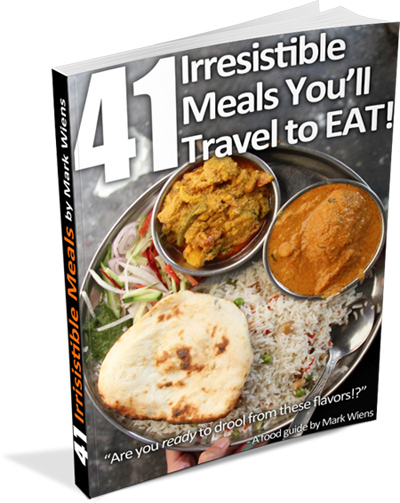
These meals will make you want to travel, just to eat!
Prepare yourself to drool over these 41 meals, each featuring mouthwatering photos, details, and where you can eat it.
I've also included some of my personal travel eating tips and answered some of your top questions... like "Mark, how do you make money to travel?".
You must love food as much as I do!
Just enter your name and email below and I promise to only send you delicious emails :)
The Ultimate Travel Guide to Nairobi, Kenya
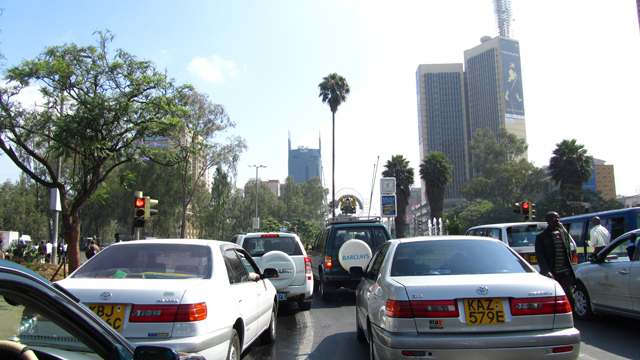
NOTE : I lived in Nairobi for 10 years and I know that the city changes and develops rapidly. If you see any corrections or have recent Nairobi travel updates to contribute, I urge you to please leave a comment (bottom of this article)!
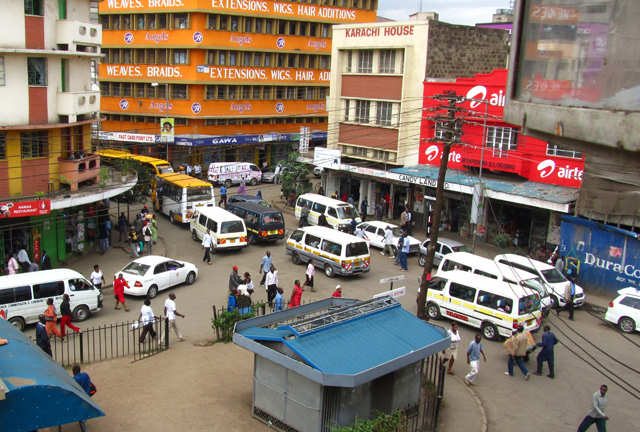
About Nairobi
Nairobi was once a swampy area in the Kenyan highlands, a retreat where the air was fresh and the climate was comfortable.
The Masaai tribe named the area “ Enkare Neerobi ,” – meaning, a place of cool waters. As the city developed it grew, people flocked to Nairobi from all over Kenya.
The city expanded, and as sky-rise financial banking buildings were erected in central Nairobi, slum villages were setup on the outskirts of town.
Transportation became hectic to say the least ; Public vans (matatus) adapted to city life by driving in the most aggressive manner.
Though it’s not exactly that quiet retreat that it once was, Nairobi remains known as the “ Green City in the Sun ,” a city where the air is still fresh (unless you are walking on the side of the road), the matatus are still chaotic, and the climate is nearly perfect!
As Kenya’s capital and largest city, Nairobi is the giant melting pot of Kenya – a gathering place for Kenyans, people from all over Africa, and a sizable population of expats.
Though the city is sometimes avoided by world travelers seeking get out of Nairobi an see the Big 5 or recline on the Indian Ocean coast, spending a few days in Nairobi can be just as rewarding!
I hope this Kenya travel guide information will help!
You’ll most likely need a visa when you travel to Nairobi, Kenya. Most nationalities can apply for a visa on arrival in Kenya. You can check this website to see which nationalities require visas.
- Single Entry tourist visa : $25 (£20) – valid for 3 months
- Multiple entry tourist visa (great if you are traveling around in East Africa): $50 (£30)
- Kenya transit visa : $10
You can also print out the visa form and be prepared to get a speedy visa on arrival! You will need to fill out a visa application form, a landing card, possibly submit photos – and paying with USD is best.
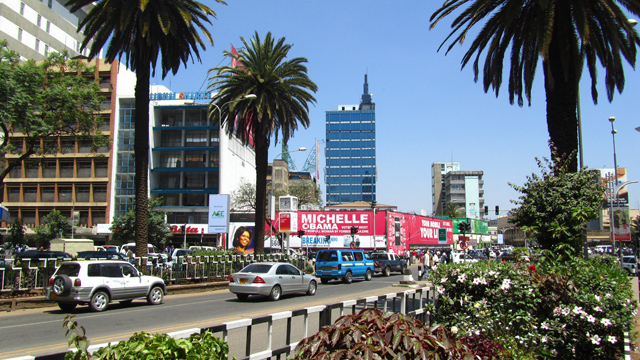
Flying into Nairobi – Jomo Kenyatta International Airport (NBO)
Jomo Kenyatta International Airpor t (NBO) is East Africa’s largest and busiest airport.
Although at times it may seem a bit congested with crowds of travelers and stuffy from a lack of airflow, it is normally the functioning base of quite a few international airlines as well as domestic carriers.
Most likely if you fly into Kenya (or even some other places in Central Africa), your flight will land in Nairobi. From there, you can choose to either remain in the Kenyan capital city or continue on to another Kenyan or African destination.
How to Get from Jomo Kenyatta International Airport to Nairobi City Center
The airport is located on the outskirts of Nairobi, about a 30 minute drive away – more depending on traffic conditions. If you have pre-booked accommodation in Nairobi, the hotel or guest house may offer airport pick-up. Other than that, there aren’t too many options.
Taxi is the main option
A taxi ride from the airport to central Nairobi should cost around 1000 – 2000 KES depending on where you are going.
Take a taxi from the airport that is operated by a reputable company such as Jatco Radio Call (E-mail: [email protected] | Tel: 020 4446096), Kenatco Taxis (even book online!), or Jimcab (excellent service and book online).
- It’s a good idea to e-mail your guest house or place of accommodation to inquire about the correct fare from the airport. They will be able to offer you a ballpark or exact price range.
- You may need to do some negotiating before you get into the taxi cab to get a better rate.
Kenyan Money
Kenya uses the Kenya Shilling (KES): 1 USD = about 86 KES. Before you travel to Kenya, be sure to check out the exact exchange rate .
Banks and ATMS:
There are plenty of banks and ATM’s located throughout Nairobi. ATM’s are in my opinion the easiest way to get Kenyan currency with a decent rate.
Normal banking hours in Nairobi are from 9 am – 2 pm, Monday through Friday. Some banks may remain open for longer periods in the afternoon and a few are open on Saturday morning, but don’t rely on it if possible.
Money Exchange :
There are money exchange services throughout Nairobi and in the Jomo Kenyatta International Airport. I often visit a forex bureau located in most shopping malls within Nairobi if I need to exchange currency.
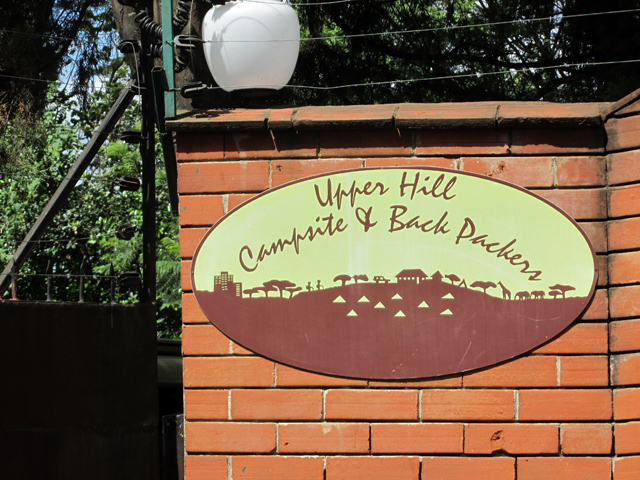
Accommodation in Nairobi
In this Nairobi travel guide , I won’t get into all the accommodation options within the city, but mostly cover a few budget choices.
NOTE : There are some places in Nairobi where you can get very cheap places to stay, but they probably aren’t very clean and may not even be safe. Be sure to choose a decent place wisely – you might end up paying a little extra, but it’s worth the safety.
Dorm Rooms and Camping:
One of the cheapest place to get a decent dorm bed in Nairobi is at the Kenya Youth Hostel . Dorm beds can be found for anywhere from $6 – $10 per night, which includes a bed in a shared room with a communal bathroom facility.
Get exclusive updates
Enter your email and I’ll send you the best travel food content.
Wildebeest Camp provides dorm rooms for around $10 per night and they also have the option of setting up your own tent for just $5 – $10 per night.
Bush House is another good place to stay in Nairobi that offers dorm beds for $12 and private rooms for $25 – $40 per night. You can also set up your own tent.
Located in a great location, also check out the Upper Hill Campsite for private rooms, dorm beds and camping options with similar pricing.
Private hostel rooms in Nairobi are in the range of $20 – $30 per night, which normally includes a private double room with a private bathroom.
Guest Houses and Bed and Breakfast:
Nairobi supports a large range of guest houses and bed and breakfast style accommodation – often used in the more upscale meaning of the word.
Guest houses in Asia are usually the cheapest places to get a room, but in Nairobi, guest houses are usually set up in nice homes offering comfortable and quiet rooms for a price. Guest houses usually charge $30 – $60 per night for a double room.

Transportation in Nairobi
Taxis don’t usually use meters in Nairobi, so it can be tricky to figure out the correct fare when taking a taxi. If you are uncomfortable, use a reliable company such as:
- Kenatco Taxis (even book online!)
- Jimcab (excellent service and book online)
- Jatco Radio Call (E-mail: [email protected] | Tel: 020 4446096),
Note : It can be beneficial to ask a random 3rd party person what a correct fare should cost from Point A to Point B (if you take a random taxi) so that you have a price range to keep in mind.

Matatu Minibus:
The notoriously rowdy mini buses that chaotically control the streets of Nairobi are known as matatus. Though they are crazy, when you travel to Nairobi taking them is a must.
Matatu routes are all over Nairobi and cost a minimum of about 30 KES per ride. Sometimes touts will charge more for specific routes, or depending on the time of travel.
Click here to see a decent map of Nairobi bus routes.
Kenya Bus Service (KBS):
In an effort for Nairobi city to get more organized with their transportation system, Kenya Bus Service offers bus routes throughout the city.
Click Here to take a look at their website and see a list of Nairobi city bus routes.
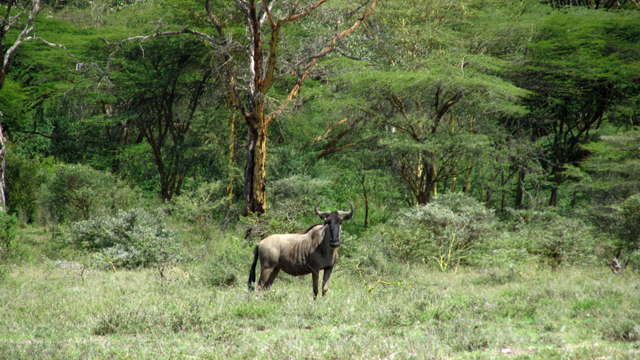
Attractions in Nairobi
In this Nairobi travel guide I just listed a few of the many attractions in Nairobi to get you started.
Please check out my other list of 101 Things to Do in Nairobi for many more ideas!
Nairobi National Park
Nairobi has its very own national park! Just moments from the city center, you can take a safari drive through the grasslands and observe cheetah, lions, hippos and giraffes in their natural habitat.
Nairobi National Park makes a great day activity. Unfortunately, there are no elephants in this park.
Nairobi Elephant Orphanage
The Sheldrick Elephant Orphanage is an orphanage that houses baby elephants and rhinos. They are truly incredible to see running around, being fed and playing with each other.
Walk Around Downtown Nairobi
Safety is improving in parts of downtown Nairobi, and that’s great, because there are lots of things to see and places to walk around. Take a stroll though central Nairobi and check out the old paliament buildings, the McMillan Memorial Library, and quite a few colonial buildings. It may be easiest to begin your walk from Nairobi Hilton hotel.
If you are interested in group tours, check out these tours of Nairobi .
Like many capital cities in the world, Nairobi is full of interesting museum. Kenya National Archives houses memorabilia from colonial Kenya and the Nairobi National Museum has exhibits displaying culture from around the country.
Tribal Art from all over Africa can also be found in the personal collections here.
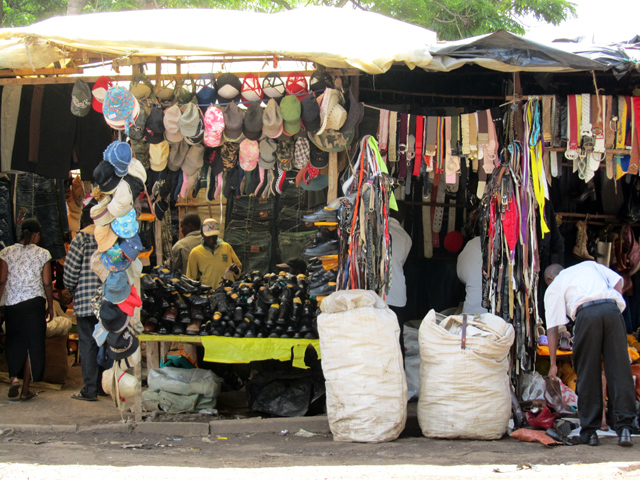
City Park Hawkers
When I travel, there’s not much I like better than going to local style produce markets. One of the biggest food markets in Nairobi is City Park Hawkers, located in the Parklands area of town.
Maasai Market
If you are looking for Kenyan made souvenirs, you’ll need to go to the Maasai Market. The giant market is filled with vendors selling all kinds of curio handicraft things.
Nairobi Nightlife
Nairobi nightlife is rather famous throughout Africa. There are lots and lots of bars and quite a few night clubs. Just be cautious going out at night and you should have a great time!
Check out the complete list of 101 Things to do in Nairobi !
Eating in Nairobi
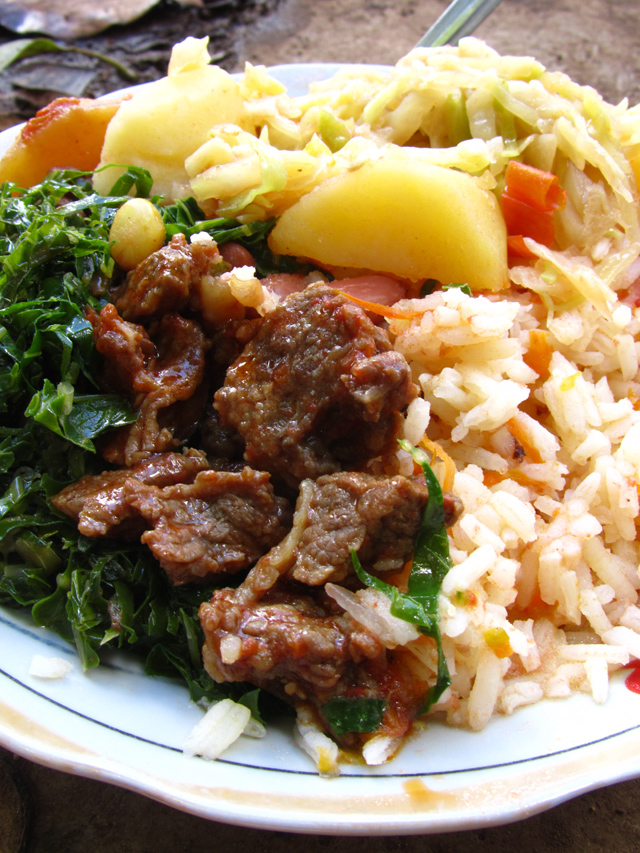
When you travel anywhere in the world, food can be one of the most important aspects. The food in Nairobi offers a pleasant mix of everything from delicious local Kenyan dishes to international famed restaurants.
Kenyan style roasted meat (known as nyama choma), Indian food, and Ethiopian cuisine are among my favorite things to eat in Nairobi. In this Nairobi travel guide, I’ll go over a few of my top dining recommendations.
Local Kenyan Food
1. Ugali : Ugali is usually made from ground cornmeal (but the staple can also be made with sorghum or cassava) that is cooked into a thick paste and is recognized as Kenya’s national starch. Many Kenyan’s eat ugali everyday.
2. Sukuma Wiki : Sukuma wiki (which in English is known as collard greens or kale) is the most popular green vegetable eaten throughout Nairobi and Kenya. The vegetable is usually sliced thinly and mixed with tomatoes, onions, and a sprinkle of mchuzi mix (secret salt flavoring).
3. Beans : Forms of beans are cooked with small bit of tomatoes and onions to create a pleasant bean dish with sauce that goes great with ugali, chapatis, or rice. I ate a great Nairobi street food meal near Adam’s Arcade.
4. Chapatis : Originating from Indian influence, the chapati has become a Kenyan staple. Kenyan chapatis are often eaten with a plate of beans and cabbage or sukuma wiki as well.
5. Nyama Choma (Roasted Meat): There’s nothing as good as Kenyan roasted meat at a local joint! One of the most popular ways to enjoy goat or beef is roasted and sliced on a cutting board right on your table! Look here for the best nyama choma in Nairobi . It’s my favorite thing to eat!
6. Chai : Despite the Kenyan coffee reputation, it’s tea that is the most popular hot beverage in Nairobi. Black tea is made strong, toned down with milk, and sweetened up with 3 spoons of sugar!

International Restaurants in Nairobi
The Smart Village:
The Smart Village Eritrean restaurant in Nairobi is a place you don’t want to miss! The powerful scent of brewing berbere sauce, sizzling meat, and Ethiopian butter is tantalizing.
Start your meal off with the mixed Eritrean platter and maybe order a few extra dishes like Tibbs or Shiro Wat. Click Here for more information and directions.
The Smart Village is one of my favorite Nairobi restaurants . Don’t forget to sample the Ethiopian coffee or the homemade honey wine!
Diamond Plaza (Indian Food):
There’s no better place in Nairobi for cheap Indian food than Diamond Plaza. The entire shopping center is full of dining options and a giant outdoor Indian food court.
From tandoori chicken and naan, to tasty samosas, Diamond Plaza is a one stop Nairobi Indian food dining spot! (Again, huge thanks to my friend Khan here for the tour, check out his African Tribal Art here)
Anghiti Indian Restaurant:
If it’s a more sit-down Indian restaurant that you are after, Anghiti Restaurant will deliver you some serious culinary quality. The Indian curries and clay pot dishes are what Anghiti is most famous for.
There are a number of location throughout Nairobi, including Muthaiga and Westlands .
Mediterraneo Italian Restaurant:
Close your eyes, sample the food, and you just might think you have been miraculously transported from the rowdy streets of Nairobi to the cobblestones alleys of Florence.
Mediterraneo serves what might be the best Italian food in Nairobi, along with a truly Italian ambiance. Click here to see the official website.
Burger Hut:
There is a certain burger that I dream about, and travel to Nairobi just to eat. It’s down a dark little alley in the Westlands Area of Nairobi, a restaurant known as Burger Hut .
Though they switch their menu quite frequently, no trip to Nairobi would be the same without the Double Hut – possibly Kenya’s best hamburger.
Nairobi Travel Video
If you have a few minutes and want to get a better feel for Nairobi, please watch this video I made!
Thanks for watching!
Prices in nairobi.
How much money will you need when you travel to Nairobi?
The cost of traveling in Kenya can be as little as $15 per day, however to be comfortable you probably need around $30 as a budget traveler. Of course, things can be much higher depending on how you are living and what you are seeing.
At the least, you’ll be paying around $10 per night for accommodation (see accommodation section in this guide). You can get a little less if you check out the Nairobi camping options. Private guest house rooms run in the $40 range and hotels might cost in the $50 – $80 range.
Street style local Nairobi food is cheap, about $1 for a meal, but international restaurants can be more expensive. You might pay about $5 – $10 for a good meal out at a sit down restaurant.
500 ml bottles of beer are $1 – $2 at local pubs, but if you go to more upscale night places, the prices will double.
As for attractions, if you are a tourist, many things are not that cheap in Nairobi. For instance, the entrance fee for Nairobi National Park is $40 per day – not cheap!
Museums and monuments cost in the $5 – $10 range for non-residents.
You can check out my more in depth guide breakdown of Kenya travel costs here .
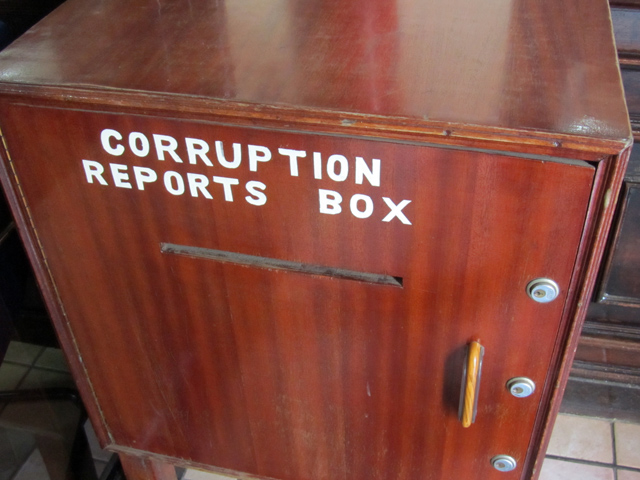
Safety in Nairobi
I’m going to write this article less about the criminal statistics, and more about my personal experience of living in Nairobi.
Just like any other city in the world, some areas of Nairobi are safe while other areas are not safe at all. Depending on where you are, what you do, and how you act, is what can make the safety difference.
Nairobi does have its share of theft, but using some common sense is a way to avoid some of it. I’ve had a couple mobile phones and a wallet stolen. When I first moved to Nairobi my Mother had a gold necklace ripped off her neck and my Father had a watched ripped off his wrist.
Lesson : Be careful what you wear, don’t wear anything flashy, and be careful with electronics ie: cameras .
That being said, I don’t feel in danger when I’m in Nairobi (in most areas of town, apart from places like Dandora ). I would definitely recommend traveling to Nairobi, but when going to places like downtown or slum areas, it’s always a good idea to find a group to walk around with or some traveling companions.
For solo women, be careful, be alert, and be especially cautious going out at night. If possible venture out with a group of people. If you go to any parties where there are a lot of people, be careful of pickpockets and purse snatches.
Be careful carrying a purse as they are quite easy to rip off. If you do use a purse, make sure it has a secure zipper and that it can be carried close to your body, maybe with your arm tightly wrapped around it.
Safety Tips for Nairobi
- Try not to wear anything overly ostentatious or over the top stylish
- Go to Busy Places with a Group
- Be Cautious Taking Photos
- Don’t Wear Any Valuable Jewelry
- Backpack When Sitting
- Be Confident and Know Where You Are Going
- Avoid Areas That Don’t Feel Safe
How to Carry Money and Cameras
I normally carry an “in the pants” wallet pouch that has a belt loop and then lays vertically down my pants. This way, I don’t obviously have money and I don’t have a traditional wallet that can be stolen with ease. So that I don’t have to keep reaching into my pants, I keep a small amount of cash in my front pocket in order to purchase small necessary things like water and snacks.
My advice for carrying money is to make it as hard as possible for someone to take it without you knowing.
Going Out At Night
Many people go out to enjoy the nightlife of Nairobi.
I normally leave my wallet in a secure location and bring a certain amount of counted cash for the night with me in my pocket (or use my in-pants money wallet). I also throw in an extra 1000 KES in my sock or somewhere hidden just in case there is an emergency.
Giving Money to Beggars
Nairobi has its share of beggars, many legit and very much in need. It’s a toss up and dilemma what to give or even if to give anything to beggars.
I’ve seen countless occasions of street boys receiving money and then fighting over it, doing more bad than overall good. Other occasions, it can be good to give food or clothes. My advice is to give food or clothes instead of money, but still be careful and use discretion on when and how to give.
Also, before you travel to Nairobi, it might be helpful to read about the current situation, you can start searching for information on places like the World Travel Watch or the US Security and Safety website.
Remember, that while Nairobi does have some crime, so does every other city in the world. It should not discourage you from visiting the amazing city of Nairobi!
You’ve made it to the bottom of this massive 3,000 word Nairobi travel guide . I really hope this information can assist you with some tips and advice on visiting Nairobi – one of my favorite cities in the world!
If you have any updated / new information, please post a comment ( below ). Thanks!
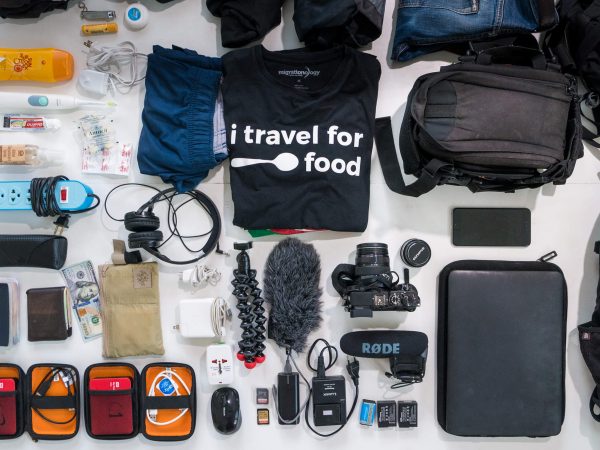
My Ultimate Travel Packing List (Everything I Carry)
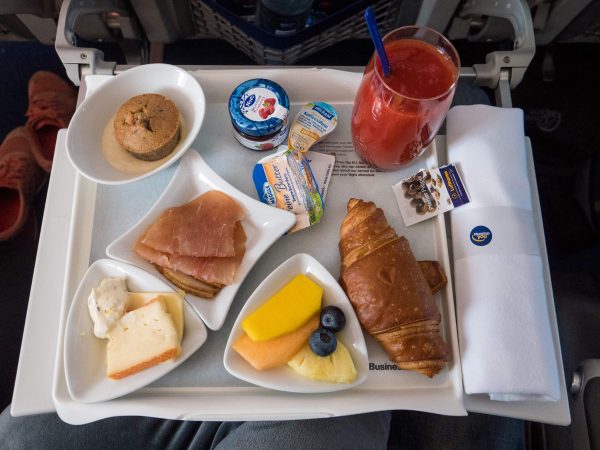
The Best Airplane Food from 10 Star Alliance Flights

How to Make Travel Videos for YouTube (and Grow Your Channel)
Enter your email and I'll send you the best travel food content.
39 comments. I'd love to hear from you!
Leave a reply cancel reply.
Your email address will not be published. Required fields are marked *
Save my name, email, and website in this browser for the next time I comment.
Austin Ross
3 years ago
Great travel guide for people like me who have never been to Kenya before. Especially, the accommodation and camping part was very informative. Thanks Mark!
6 years ago
I was interested to read the 101 things to do in Nairobi, but the link isn’t working anymore…
7 years ago
Awesome Nairobi Guide Mark! Especially the part of the cuisines. You must have loved your visit to Nairobi huh? 🙂
8 years ago
Great travel guide when travelling to Nairobi. Just one update…starting Feb 18, 2016 The Government of Kenya has waived visa fees for all children aged 16 years and below who are accompanying their parents to Kenya.
vikram sood
Very Helpful information .!
Thanks Vikram!
Francis Xavier
Your comment: I like it Mark. keep it up and visit more cities in Africa. love it.
9 years ago
Great peace that sums up Nairobi travel! This could be very useful to any foreigner visiting Nairobi. Update: Beer prices have gone up sadly 🙁 and also the value of Kenyan Shilling against the dollar. Everything else is on point! 🙂
Thank you Khweza, haha, those beer prices always going up!
Adam @ GettingStamped
11 years ago
Amazingly detailed write up! We are just trying to judge how much time we should allow ourselves to see the city before starting an overland trip heading south.
Thank you Adam! I guess it just depends on how much you want to see, if you want to go to the National Park, and how much you want to relax. Maybe anywhere from 4 days – 8 days or so?
To each his own, but I prefer Habesha to Smart Village. I’ve heard of people flying into Nairobi with a 3 hour layover who leave the airport to go to Habesha.
Thanks Andrew, Habesha is excellent!
12 years ago
Hi Mark, I live in Europe and my mom lives in Asia- I like to have a few drinks occasionally but my mother does not drink anything but fruit juices-where would be a good place to suit both of us and be comfortable and enjoy some good local music which is pleasant? I read about Havana, Gipsy in the forums but since Im travelling with my mom, it must be suited to both of us! Thanks a mil!
Hey Ash, thanks for sharing! Since I don’t live in Nairobi anymore, I don’t know all the latest updated information about going out, but here are some places I would recommend: Tamambo Bar and Grill, Simba Saloon or Carnivore, Kengeles (a local style restaurant with live music and beer and juice). Hope this helps and hope you have a great visit to Nairobi!
I am travelling to Nairobi in a few days. I will be there for a week. what would my daily living expanse be. I have accommodation. so how much approx would i need for food and drinks. Im coming from South Africa. Ive never travelled to Kenya so i am completely lost.
Hi Eugene, if you have your accommodation already sorted out, you’ll probably spend about $15 – 30 per day, this of course all depends on many variables – where you eat, what attractions you visit, drinking and so on. Hope this helps and hope you have an excellent time in Nairobi!
Single entry visa fee was back up to 50 USD dollars as of mid last year I think. The reduction to 25 USD was only a temporary one we enjoyed for a while:)
On the local kenyan food I think you really should have mentioned Mukimo(a side dish of mashed potatoes, beans, peas and maize) that most westerns would prefer to the rather solid ugali.
Mutura, the local meaty kenyan sausage is another delicacy served in local Nairobi choma places that is well worth sampling. I get my favorite up at Buffet Park in Argwing Kodhek, Hurlingham.
As for the beggars, I normally leave them any left over food I have from lunch/dinner. Packing left over food for takeaway is done for free everywhere, so a good way to give them something they really need. If you give the boys money they will just spend it on glue for sniffing anyway…
Well, just a couple of comments, dont have time for more now, but have spent a lot of time in Nairobi and Kenya over the last 15 years. Surely a great place to visit! You will always come back. A testament to this is my 50+ trips to Kenya since my original visit 15 years back:)
Thanks so much for your added input Gunnar – I really appreciate it! Glad to hear you also love Mutura. I used to get it from a small place in South C, but it’s nearly impossible to explain how to get there – but it’s so tasty!
I’m off to Nairobi tomorrow. It will be my first time in Africa and I am so excited. Thank you for the great tips!
No problem, have a great time Annika!
Thanks Mark. It was an absolutely incredible experience. I will be forever grateful for the opportunity to take this trip.
Awesome to hear that Annika!
Your candor and honesty (without being offensive or distasteful as is the case with many who write about Africa) is highly appreciated. This can only come from someone who is not afraid to immerse himself in the local culture. Thank you!
No problem Nick – I appreciate you taking the time to look at it and leave me a comment. Hope it’s useful to people visiting Nairobi!
Wow! what a wonderful place to visit. Thanks for the very useful tips that you have shared with us about Nairobi. I wish i could visit this amazing place someday. Thanks for the post!
No problem Ynna, glad you enjoyed this post!
I’ll be moving to Nairobi as an aupair next month and will certainly keep all this information in mind. Thank you for posting.
You’re welcome Kelly. Hope you have a wonderful time in Nairobi!
Very good write up. I’ve never taken a trip to this part of Africa so it’s something that I’d love to do one day. The main attraction for me would definitely be the National park and the elephant sanctuary!
Kenyans seem to drink tea the same as we do in the UK, lashings of sugar and milk!
Cool to hear that Gemma – I hope you can visit Nairobi soon and see the wildlife. Tea, sugar and milk is a winning combination!
That was packed with knowledge. But, back to the Chai. No spices? The “chai” in the US adds cinnamon and a few others.
Hey Lane, Yah, unless you get spiced chai or ginger chai, normal Kenyan tea comes with just tea, milk and sugar. On the coast you can get more of the masala chai which is excellent!
Kenyans have a tea spice they use called tea masala (search for: Tropical Heat Tea Masala). It is best brewed with tea; Heat 1 cup water to 2 cups milk and add tea leaves (Ketepa Tea leaves) and tea masala and bring to boil. Seave the tea and you may add sugar or honey as you please and enjoy it
Thanks for sharing R!
mark: thanks for the very useful tips. It of great help.
No problem, hope it can be helpful for travelers visiting Nairobi!
Nairobi Solo Travel Guide
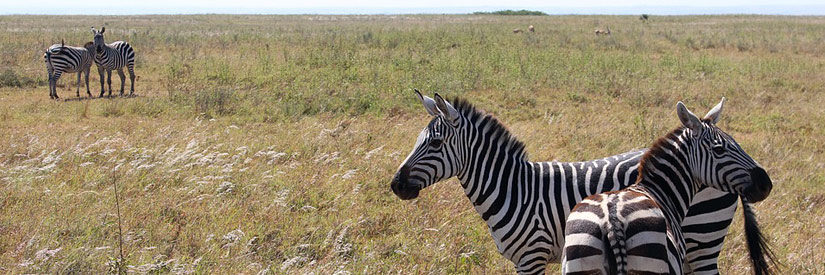
Planning a solo trip to Nairobi ? Here’s everything you need to know for your visit:
QUICK FACTS
- The capital of and largest city of Kenya, with a population of over 4.4 million .
- The only city in the world located right next to a major national park (Nairobi National Park).
- Contains Kibera , the largest urban slum in Africa (with over 170,000 inhabitants).
- Nicknames: Green City in the Sun, Safari Capital of Africa, Nairobbery (in jest).
PRACTICAL INFORMATION
- Currency: Kenyan Shilling (Ksh or KES).
- Spoken languages: predominantly English and Swahili .
- Best time to visit: from August to September (if you want to catch the wildebeest migration), or from December to February (the warmer, sunnier months).
- Arrival via airport : The airport is located in the neighborhood of Yoff, toward the tip of the Cap-Vert peninsula. It’s about a 30-minute drive to the city center, and taxis from the airport should run around 3,000 KES .
WHERE TO STAY
- Best Nairobi hostel for solo travelers: Pinkroses Gardens . Exceptionally clean, in a great location, and very safe (located in a compound with security guards). Friendly, English-speaking staff that do their best to create a welcoming atmosphere. Big daily breakfast included.
- The city offers plenty of accommodation options, including upscale hotels, furnished and serviced apartments, and budget hotels (primarily around the main bus station ).
GETTING AROUND
- Public buses, mini vans (dubbed matatus ), and taxis are the primary modes of transport. Taxis are available at designated areas in the city centre – all taxis (and matatus ) have a yellow line painted across the middle.
- There is also a train service from Nairobi to Mombasa, managed by the Rift Valley Railway company.
NAIROBI NIGHTLIFE
- Drinking age is 18 , last call is 11 PM for bars (clubs close down at 4 AM).
- Hip/local scene: Bars along the Kimathi Street in the Central Business District (CBD).
- Trendy scene: lounges/clubs in Westlands , the city’s main entertainment area. The neighbourhood is frequented by expats.
- College crowd: bars along Kimathi Street in the CBD.
- Looking for a good sports bar? Head to Kengele’s Lavington Green.
- Looking for great cocktails ? Head to The Alchemist.
UNIQUE LANDMARKS TO VISIT
- The Jomo Kenyatta statue at the Kenyatta international Conference Centre.
- The Nairobi National Park (must visit) and the Nairobi Animal Orphanage .
- The Dedan Kimathi and Tom Mboya monuments.
- Located off State House Road (3 km from the city center), the Nairobi Arboretum is a 30 hectare collection of different plant species. Established in 1907 for research and conservation purposes, the Arboretum is a living natural museum.
- Various buildings along Kenyatta Avenue that include: Kipande house, Cameo Cinema, Standard bank building, the Macmillian Library, and Koja Mosque. These are some of the oldest and most historic buildings in Nairobi.
INTERESTING WALKS
- Uhuru Park is the city’s main leisure park. Go for a walk, take a boat (or camel) ride, or just have a picnic in the park.
- Day trip idea: the Karura Forest is both a natural attraction and a historical landmark, having previously been the hideout for the mau mau in the pre-Colonial era. Go for a stroll (or jog with the locals), and you won’t be disappointed.
- Located within the Oloolua Forest, the 5-km long Oloolua Nature Trail is a great chance to escape the bustle of the city. A favorite with visitors and locals alike, the trail is ideal for walking, picnicking, camping, and general sightseeing (you will see caves, waterfalls, and many different species of birds). The Institute of Primate Research is also located within the forest.
LOCAL WISDOM
- Tip: Avoid carrying large sums of cash . Nairobi has plenty of international banks, where you can withdraw money or use the ATM. Many places also accept major credit cards.
- Great restaurants to try: Talisman Restaurant ($$$ – best in town), La Terrazza Italian Restaurant, Mawimbi Seafood Restaurant ($$$), Red Ginger, Mercado – Mexican Kitchen, and Harvest Restaurant.
- Where to find good cheap eats : visit one of the city’s naymachoma bars/pubs, where you can sample Kenya’s trademark dish – the Nyama choma (roasted meat, typically beef short ribs). Kenyatta market, located in the Upper Hill neighborhood, is one such location. Also: check out the food court inside Sarit Centre .
- Dangerous areas to avoid : if you must visit the slum areas (e.g. Kibera), make sure that you have a guide. The slum areas are considered unsafe – even by local standards. Avoid back or side streets and ensure that you stay alert at all times. Avoid carrying your valuables or showing any displays of wealth.
Recommended trip duration: 2-3 days
- Cape Town, South Africa
- Johannesburg, South Africa
- Kigali, Rwanda
- Cairo, Egypt
Leave a Reply Cancel reply
Your email address will not be published. Required fields are marked *
Save my name, email, and website in this browser for the next time I comment.
Nairobi Travel Guide: Things to Do, Itinerary, Tips, & Accommodations
- Post author By Smart Nomad Kenya Editorial
- Post date January 21, 2024
- No Comments on Nairobi Travel Guide: Things to Do, Itinerary, Tips, & Accommodations

Nairobi has positioned itself on the world map as an ideal travel destination. Started as a railway depot in 1899, the city has grown in leaps and bounds and is now home to over four million people. Famous for its unique attraction sites, diverse cultures, thrilling events, and buzzing nightlife, you’re in for a fun-filled adventure in the city.
Being Kenya’s capital, it’s a tourist, administrative, and commercial hub. Tourists in the destination visit attraction sites such as Nairobi National Park, The Maasai Market, Bomas of Kenya, and Karen Blixen Museum. For more tips and tricks about this buzzing city, continue reading this informative travel guide to Nairobi, Kenya.
Page Contents
Things to Do in Nairobi
Nairobi, being one of the liveliest cities in East Africa, has plenty of things to indulge in. Some adventures are only experienced in the capital and not anywhere else in the world. Below are the top enjoyable things to do while visiting the city.
– See wild animals at Nairobi National Park

Nairobi National Park is a unique park as it’s located in the capital city. Since its founding in 1946, the park has been home to wild animals and birds, such as cheetahs, gazelles, African leopards, and ostriches. To add to the park’s charm, it’s only minutes away from the city center and Jomo Kenyatta International Airport (JKIA). You also see Nairobi’s skyscrapers from the national park.
– Feed giraffes at Giraffe Center
Giraffe Center is a conservation park tucked in a quiet location. It’s home to some of the world’s endangered rare, giraffe species. Get up close with the giraffes and feed them with pellets that they enjoy chewing. Pass by the facility’s gift shop for lovely souvenirs as well.
– Buy handmade artifacts and souvenirs at Maasai Market
Many tourists pass by this market to buy authentic artifacts made in Kenya by creative Kenyans. These art pieces range from jewelry to carvings. Visit the market and buy something that will remind you of your tour to Nairobi.
– Take a nature walk at Nairobi Safari Walk
Nairobi Safari Walk has a raised walkway that’s used by visitors strolling around the establishment. Go for a leisure walk around the facility, seeing wild animals such as monkeys, giraffes, antelopes, and hyenas in their natural habitat. Guided tours here let you learn about the establishment and its inhabitants.
– Visit the Kenya Museum Society
A tour around the museum is fun and informative at the same time. You learn about local history and see unique pieces of art. Well-preserved guns, bows, and arrows used during Kenya’s colonial period are displayed. To top it all off, pass by the museum’s snake park and see caged snakes found in Kenya and beyond.
– Learn local history at Kenya National Archives and Documentation Service
If you’re in search of a place with pictures, publications, and paintings portraying Kenyan history, then the Kenya National Archives and Documentation Service will not disappoint. Apart from being an important landmark in Nairobi, it’s used to store historical scripts. As it’s in the heart of the capital, the establishment is easily accessible.
– Enjoy a bird’s view of Nairobi from the Kenyatta International Conference Center (KICC) rooftop

See Nairobi and its environment atop one of the tallest skyscrapers in the city — Kenyatta International Conference Center (KICC). At the rooftop, you see some of the city’s places of interest, such as Uhuru Park and City Park. Carry your camera with you to capture stunning views.
- 14 Best Places to Visit in Nairobi
What and where to eat
Food in Nairobi, Kenya is as diverse as the city’s residents. Local and international cuisines are served in eateries across the beautiful city. Read on for details about local foods to try out in some of the city’s food joints.
– Nyama choma at Njuguna’s Place

Grilled meat, also known as nyama choma , is a common delicacy in Nairobi and other parts of Kenya. The nyama choma is best eaten with Ugali. To sample finger-licking nyama choma in Nairobi, visit Njuguna’s Place. Njuguna’s Place is along Waiyaki Way and is open daily. Besides charcoal-grilled meat, the eatery serves beers and other alcoholic beverages.
– Chicken wings at CJ’s
Eat deliciously cooked chicken wings at CJ’s, a fully-fledged restaurant with an array of tasty menu items. It has branches in various parts of the city, including Village Market and Kilimani. Chicken wings at CJ’s are delicious and served in large portions. Aside from the delicious cuisine, the carefully selected theme and customer service add to the eatery’s charm.
– Fish at Mama Oliech Restaurant

Mama Oliech Restaurant is famous for its fried fish. It’s an open-air eatery serving authentic Kenyan food. Fish lovers who visit the joint choose how they’d like their fish prepared, either deep fry, boiled, or wet fry.
Here, fish is served with kachumbari , traditional vegetables, ugali, or rice. To wash it down nicely, order a soft drink or milk. In 2016, Mark Zuckerberg , Facebook’s CEO, visited this fish joint and was served fish and ugali.
– French fries at Azuri Restaurant and Café
Located in Nairobi’s central business district (CBD), Azuri Restaurant and Café prides itself on serving tasty meals at pocket-friendly prices. One common meal in this eatery is French fries or chips, as commonly referred to by locals. The meal is prepared using locally sourced ingredients and by skilled personnel. While visiting the food joint, sit on the outdoor veranda and have a view of the busy street with people going about their businesses.
– Chapatis at Hot Dishes Restaurant

With three branches in Nairobi; Kimathi Street, Kaunda Street, and Gaborone Road, Hot Dishes Restaurants have positioned themselves as premier eateries for delicious African cuisines. Enjoy unleavened flatbread (chapati) that’s prepared with customers in mind. In the yesteryears, chapatis were mostly eaten during the festive season. Nowadays, they’re a common meal among locals.
– Samosas at Talisman Restaurant
Talisman Restaurant is a classic food joint that never disappoints. It’s popular for serving tasty meals and drinks worth trying out. Visit the restaurant and enjoy finger-licking Feta and Coriander samosas. The samosas go well with any other meal of choice. Apart from the food, Talisman Restaurant has a welcoming ambiance and nice outdoor seating.
It’s worth noting that the eateries above serve a variety of meals. So, if you’re looking to sample more than one meal in the city, the food joints are good for you.
- Fine Dining: Top 14 Restaurants in Nairobi, Kenya
Things to buy
When visiting a tourist destination, it’s always good to buy items that remind you of the place. That said, Nairobi has many things for you to buy as gifts or souvenirs. Here are some fantastic items for you.

– Maasai jewelry
The Maasai community of Kenya is known to make creative pieces of art such as bangles, necklaces, and earrings. Shop for these products and carry home something that reminds you of Nairobi.
– Hand-carved wooden sculptures
Sculptures are some perfect items for decorating your home. The good thing is you have a chance to customize some Kenyan sculptures. As they vary in size, shape, and color, it’s easy to get a pocket-friendly one.
– Kenyan t-shirts
Most Kenyan branded t-shirts on sale have something Kenyan on them. Some t-shirts have a Kenyan flag, a native message such as ‘Jambo’, or a picture of a celebrity or prominent person placed on the front or back part.
– Khangas and kikois

These cotton fabrics are worn around the waist by both men and women. You’ll have various khangas and kikois to choose from, as they come in different prints, sizes, and textures. The fabrics are also used to make clothes such as skirts, shirts, and shorts.
– Kiondos

A kiondo is a handwoven handbag that’s locally used by women to carry their personal effects. The handbags are made from sisal fibers and come in different sizes. Instead of carrying your leather handbag to work daily, try out the kiondo that works perfectly well and is long-lasting, too.
Where do you buy the above items?
Buying these items in Nairobi shouldn’t be a hassle. Visit establishments such as The Maasai Market, Utamaduni Craft Centre, Village Market, and City Market for the above items, and more. While at these markets, enquire if the price is negotiable. By doing so, you might pay less for a quality product.
- A Shopper’s Paradise: The Top 10 Malls in Nairobi
Where to stay
Nairobi, Kenya is awash with accommodation facilities . Holiday homes, cottages, hotels, and serviced apartments are some accommodations available. So, whether you’re looking for a luxurious or budget-friendly boarding facility, the city has got you covered.
Websites such as Booking.com , Agoda, Expedia, and, Airbnb are perfect for finding an accommodation facility. Go for an establishment that is in a safe and convenient location. You can check out the boarding facilities below.
– Giraffe Manor
Giraffe Manor is in Lang’ata, one of Nairobi’s leafy suburbs. The 5-star hotel sits on 12 acres (4.9 hectares) of private land with Rothschild giraffes. For a restful forest stay within Nairobi, make your way to this establishment. One exciting activity in the hotel is feeding the giraffes that frequent the hotel’s premises. There are also game drives around the extensive land. Rooms have a private balcony and seating area for you to spend time outdoors.
– ibis Styles Nairobi Westlands
For whatever reason you’re in Nairobi, ibis Styles Nairobi Westlands is out to make your stay pleasant. As it’s in the Westlands neighborhood, many entertainment joints, shopping centers, and international organizations are nearby. Furthermore, Nairobi’s central business district is 5 kilometers (3.1 miles) away. Rooms in this 3-star hotel come equipped with a walk-in shower, desk, air-conditioning, and flat-screen TV, among other amenities. What’s more, you enjoy magnificent city views from the rooftop.
– Boma Inn Nairobi
If you’re in search of a hotel that’s far away from the hustle and bustle of Nairobi city yet minutes away from Jomo Kenyatta International Airport (JKIA), then consider choosing Boma Inn Nairobi . You enjoy amenities such as high-speed Wi-Fi, free parking, and complimentary breakfast while staying in the facility. On top of that, airport transfers are offered, so you don’t have to go looking for a taxi elsewhere.
– Kenya Comfort Hotel
Are you looking for a budget hotel in Nairobi’s central business district (CBD)? If yes, make Kenya Comfort Hotel a priority. This 2-star hotel is ideal for people looking to explore the capital’s nightlife as it’s minutes away from popular entertainment joints. It’s also great for people wanting to run errands in the CBD during the day. Aside from the hotel’s central location, it has friendly staff, clean rooms, and tasty meals.
– Kahama Hotel
This budget-friendly hotel is in Ngara, near Globe Roundabout. As it’s located a short distance away from the Thika superhighway, the hotel is perfect for people looking to visit towns such as Nyeri, Meru, and Thika. From the facility, it’s easy to explore beautiful destinations such as Mt. Kenya National Park, Aberdare Range, and Ol Pejeta Conservancy found outside the city.
Additionally, access to taxi services such as Uber, Bolt, and Little Cab Kenya is easy as the hotel is along a busy road. You are treated to a sumptuous breakfast in the morning and served by helpful staff throughout your stay as well.
How to get there
Nairobi is endowed with different modes of transport, ensuring the easy movement of people and goods. These modes of transport include road, rail, and air. Consider going with the options below if you’re planning on visiting the city.

– Fly to Nairobi
There are direct flights to Nairobi from different destinations around the world. From these destinations, you alight at Jomo Kenyatta International Airport (JKIA), the biggest airport in Kenya. Besides Kenya Airways, many airlines fly to Nairobi. American Airlines, Air France, British Airways, Etihad Airways, and Emirates are some examples. Upon arrival at the airport, you can travel to other parts of the city with ease. There are airport taxis and rental cars for you to use.
– Via Wilson Airport
You can access Nairobi through Wilson Airport. Unlike Jomo Kenyatta International Airport, which serves both international and local flights, Wilson Airport caters to domestic flights. You can fly to Nairobi from destinations such as Diani, Lamu, Eldoret, and Mombasa. The small airport is 4 kilometers (2.5 miles) from Nairobi’s central business district and is good for budget-friendly airlines such as Safarilink Aviation , AirKenya Express , and Skyward Express .
– Travel by car
Kenya takes pride in having a developing road network. For that reason, it’s possible to access Nairobi by road. What’s good about traveling by car is that you’re treated to magnificent landscape views along the way.
– Travel by train

Rail transport is fast improving in Kenya. The country now has a working Standard Gauge Railway (SGR) from Mombasa to Nairobi. You can travel by train to Nairobi from Mombasa in the morning, afternoon, and night. By using the train, you’re treated to scenic landscape views as the rail route cuts across magnificent Kenyan terrain.
You’ll alight at Nairobi SGR Terminus in Syokimau then proceed to other destinations using public transport such as bus, motorcycle, taxi, or the old train. Plus, you’re also directed on where to go to access the various means of transport at the terrain station. Book a seat online using this link.
Getting around Nairobi , Kenya
On arrival in Nairobi, you’ll also need to move around. There are various ways to move around to your destination of choice. Below are a few options at your disposal.
– Taxis and hailing apps
With technological advancement and the ever-changing Kenyan innovation scene, you can now hail a taxi at your convenience in Nairobi. Taxi-hailing apps such as Uber, Bolt, and Jimcab Services Ltd. are popular with both locals and tourists. The best thing is to compare prices before starting your journey by checking out different apps.
Some taxi companies, such as Delight Cabs Limited and Absolute Cabs , don’t require booking before your trip as their services are easily acquired within the city. If you want to enjoy your ride and avoid rowdy matatu/bus interactions, then opt for taxis. It’s good to use a taxi that’s fairly priced and well-kept. Prices are likely to change depending on the company of choice and distance traveled.
– Rent a car
You can also move around Nairobi using a rental car. Luckily, many car rental companies and agencies in the city, such as Hertz Car Rental and AVIS, offer car hire services. These companies have different types of cars, ranging from vans to buses. Other than visiting physical offices to hire a car, you can use online platforms such as Kayak. Pricing depends on the car type, duration of hire, time of the year, and age of the car.
If you’re driving around Nairobi for the first time, it is advisable to use the Global Positioning System (GPS) for directions. You don’t want to get lost in unfamiliar territory.
Hire a driver
Other than driving yourself around Nairobi, you can hire a driver. Where do you get professional drivers? Most companies offering car hire services have skilled private drivers that can drive you around the city. Additionally, check out sites, such as Viator for chauffeur services by top Nairobi private drivers.
– Matatu

A matatu is a mini-bus (most privately owned) ferrying people to different locations in Nairobi. You can use a matatu to travel to various parts of the city, such as Lang’ata, Westlands, and South B. The fares charged depend on the distance traveled, time, and the type of matatu. During on-peak, most matatus in the capital hike their fares. Cash is the most common method of payment.
Be vigilant
Be extra cautious while boarding matatus as some are prone to theft, such as pickpocketers and phone snatchers. Carry a few variables while traveling in matatus if necessary. Although they’re pocket-friendly and fast means of transport, the matatus have their challenges.
Travel tips
Currency : Kenyan shilling (KES)
Official language : English, Swahili
Greetings: ‘Jambo’ / ‘Mambo’ means hello. ‘Ahsante’ is Swahili for thank you.
Calling code: +254
Driving side: Left
Carry warm clothes
June and July are the coldest, so remember to carry warm clothes. Bedcovers and heaters come in handy during those chilly nights.
Like any other buzzing metropolis, Nairobi has its fair share of shortcomings. Areas in the city, including downtown Nairobi, are prone to crime. Avoid such areas whenever necessary, especially if you’re alone. Walking in groups and being vigilant are always advisable. Avoid wearing flashy items or expensive electronics while visiting crowded places.
Nairobi’s traffic is sometimes a mess. You might be stuck on the road for some time before reaching your destination. Most roads in the city experience rush hour in the morning, from 7 a.m. to 9 a.m., and in the evening, from 5 p.m. to 8 p.m.
- Tags best of Nairobi , Guide , hotels in Nairobi , Kenya , Kenya tourism , Nairobi , Nairobi Kenya travel guide , Nairobi travel , Nairobi travel guide , things to do in Kenya , things to do in nairobi
Leave a Reply Cancel reply
Your email address will not be published. Required fields are marked *
Save my name, email, and website in this browser for the next time I comment.

Kenya Travel Guide
Your ultimate kenya travel guide, with tips, things to do, and best things to see in kenya. great for first-time and returning travelers..
I Dream of Africa. Travel in Kenya is exactly what one hopes for when going on safari in Africa.
The people are friendly, the scenery is spectacular and even though the country is progressing at a rapid pace, it still feels as if you have stepped back in time.
This Kenya travel guide will help you plan your next vacation.
Popular Guides
- Lake Nakuru
- Amboseli National Park
Our Highlight
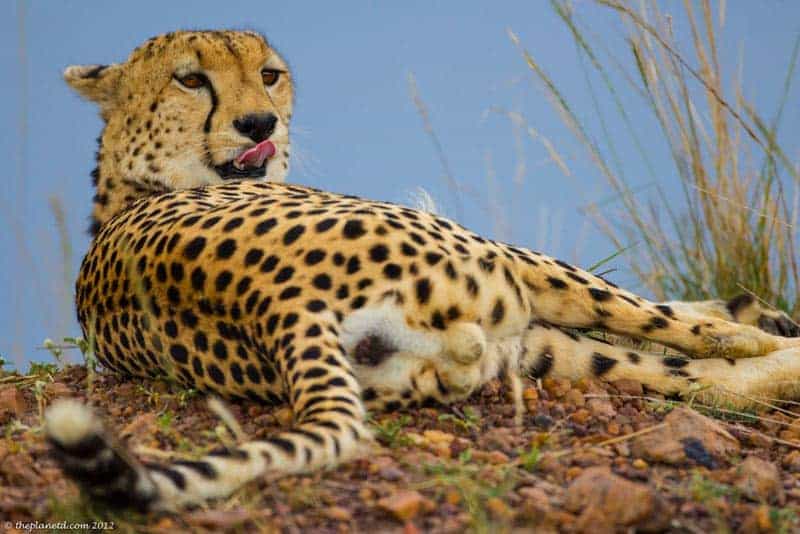
Table of contents
Table of Contents
Fast Facts about Kenya
- Kenyan power voltage is 240 V 50 Hz; Plug G.
- The Kenyan currency is the shilling and is around 86 shillings for 1 USD
- Virtually all banks in Kenya now have ATMs at most branches. Barclays Bank has easily the most reliable machines for international withdrawals. Standard Chartered and Kenya Commercial Bank ATMs also accept Visa but not the other major providers and are more likely to decline transactions.
- The best place to change money are a foreign exchange or “forex” bureaus as they do not charge commission. The exchange rates are published in the Daily Nation newspaper.
- The water is not potable ; drink only bottled water. Or bring a Steripen to purify your water and save the environment.
- SIM Cards: If you are planning on staying in Kenya for longer than a week, you can get a SIM Card Safaricom, Airtel and Telcom are good choices. You can get them in Nairobi or at the airport arrivals.
- Only select stores sell SIM cards but you can buy refill cards almost anywhere!
- SIM Cards : You can get a local sim card from Vodafone or Orange in Cairo. We suggest getting a SIM card at the airport when you arrive.
Things to See and Do in Kenya
- Champagne and a Hot Air Balloon – travel in style over the Masai Mara
- Go on a Safari in the Masai Mara – not only will you see all the big animals of Africa but you’ll witness some of the most beautiful sunsets on the planet.
- Visit Kenya’s Amboseli National Park – to see the magnificent population of elephants and witness the extraordinary view of Mount Kilimanjaro.
- Meet the Maasai People of Selenkay – a camp where travelers can learn about the Maasai culture while giving back to the community
- Fairmont The Norfolk: A Part of Kenyan History – stay at the Fairmont, a hotel that played a critical role in Kenyan history.
- Lake Nakuru – meaning “dust” or “dusty place” in the Maasai language, Lake Nakuru National Park is famous for wildlife including the thousands of flamingos nesting along the shores.
- Born Free Lives on in Kenya – In the 60s a movie was released named Born Free based on the lives of Joy and George Adamson. The Elsamere Home in Kenya still lives on and focuses specifically on conservation.
Kenya Travel Guides
Incredible Kenya Pictures an Amazing Visual Journey
- Hot Air Balloon Masai Mara – Flying High in Kenya
- Kenya Village Visit – Empowering People
Accommodation
Budget: You can find hostels in the range of 1,250-2,800 shillings per night. Stay in centrally located hostels and enjoy free Wi-Fi, security lockers, complimentary breakfast, hot showers, and your choice of a dorm or private room.
Mid-Range: For mid-range hotels, expect to pay around 2,800-11,500 shillings per night. Enjoy private rooms and suites with TVs and minibars, a fitness center, a pool, a hotel restaurant and bar, and free Wi-Fi.
High-End: Five-star hotels will cost around 13,000-53,000 shillings per night. These hotels come with room service, elegant hotel restaurants and polished bars, private suites with living rooms, spa services, a pool, and a sauna.
The cuisine of Kenya varies depending on the region. Popular staples include cereals like maize and millet, meats, and vegetables. Seafood is eaten frequently in coastal regions.
Ugali (cornmeal porridge) served with sukuma wiki (collard greens with onions and spices), kachumbari (tomato and onion salad), and maharagwe (bean stew) is a popular dish. Kenya has a variety of street vendors.
When out and about, look for Mahindi (grilled maize) or Mshikaki (skewered and grilled beef or goat meat on a stick). There are restaurants where you can try more Kenyan cuisine. In total, expect to pay around 2,550 shillings per day for food.
The Best Ways to Get Around Kenya
Getting to kenya:.
Flights: The main airport to fly into is Jomo Kenyatta International Airport, located 9 miles from Nairobi. Other airports include Moi International Airport (5.5 miles from downtown Mombasa) and Kisumu International Airport (5.5 miles from the city center). You can check for the best flights to Kenya on Skyscanner .
Transportation:
Buses : Buses are a cheap way to get around, especially in major areas like Nairobi. You can find buses for both shorter and longer distances. A typical fare for a local bus is 150 shillings, while going between cities can cost about 600 shillings. If you are traveling long-distance, it helps to book a ticket at least a day in advance.
Taxis: Taxis are another way to get around. A typical taxi ride will cost 400 shillings. Since they are usually not metered, make sure to agree on the price before starting your trip.
Car Rental: To rent a car, you need to be at least 23-25 years old and have a U.S. driver’s license. An International Driving Permit is recommended, but not required. Prices start at 6,000 shillings per day.
Uber: Uber is available throughout Kenya, especially in major cities. Little and Taxify are also popular services that operate like Uber.
When to go To Kenya
The best time to visit Kenya is during the dry season (end of June to October). During this time, zebras and wildebeests migrate, which makes for great wildlife viewing.
The dry season also means better weather for outdoor activities. March through May is the low season for tourists, which might bring better hotel rates and fewer crowds, but there is also heavy rainfall during this time, to the point where some camps will close down.
Where to Stay in Kenya
Nairobi Norfolk Hotel – beautiful historic hotel located in the heart of Nairobi by Fairmont. Hemingway stayed here. See our full review.
Hilton Nairobi: Stay right in the middle of downtown Nairobi at this four-star hotel. Right near the city square and Hilton Park, this hotel comes with soundproof rooms with flat-screen TVs and minibars, 24/7 room service, a rooftop pool, a ballroom, and three hotel restaurants.
CityBlue Creekside Hotel and Suites : When in Mombasa, come stay at this hotel. Just a quick drive to Nyali Beach, the hotel overlooks Tudor Creek and comes with numerous amenities, including private rooms with balconies and creek views (suites come with kitchenettes and living areas), complimentary breakfast, free airport shuttle, a hotel restaurant with a wine bar, a fitness center, and an outdoor pool.
Acacia Hotel Kisumu : Just a mile from Lwang’ni Beach and the Kenya Wildlife Impala Park, this four-star hotel is popular for a reason. See Lake Victoria from your hotel room (upgrade to a suite for whirlpool tubs in your room), swim in the pool, workout at the fitness center, relax on the terrace, or dine at the restaurant or café. If you want to explore more of Kenya, the Kisumu Railway Station is 10 minutes away by foot.
Check out our favorite booking platforms Booking.com , Tripadvisor and VRBO for the best deals on accommodation.
What to Pack for Kenya
Kenya is a tropical country is characterized by a warm climate that often changes to cold in the night-time, but does not fall below sub-zero.
When packing for Kenya it is important that you keep your lodgings and planned activities in mind.
Travelers should pack transitional clothing items that can carry you from day to night or from city sightseeing to safari adventures.
- Waterproof bag – the bag has two functions, protecting your stuff from the rain and also from the dust, especially if you’re travelling to drier regions.
- Footwear – especially important if going you are heading on a safari! Pack a pair of lightweight, durable, waterproof and comfortable shoes and also a pair of flip-flops or sandals that you can change into after a long day of sight-seeing.
- The protection basics – Travelers should stock up on the essentials: sunblock, mosquito/insect repellant containing DEET or a pyrethroid insecticide, sunglasses and a hat.
- Warm clothes – it does cool off at night, especially in Nairobi and the Highlands around July and August. Make sure to pack a light-weight sweater, cardigan or a pashmina scarf to keep you warm on those chilly nights.
- Cover up – in Muslim areas, including the coast, shorts, and t-shirts can be frowned upon. Try and dress modestly; wear trousers or knee-length skirts with tops that cover your shoulders.
See our packing tips: packing list for smart travel & How to Pack for a Safari
Kenya Travel Guide: Best Booking Resources
Whenever we travel to we make sure to start with these companies. We have tried a lot of different ones over the years and all of these have consistently proven to be the best when it comes to offering great prices.
We have used every one of these personally and continue to do so.
- Booking.com : This is our go site to when comparing prices for accommodation. It usually has the cheapest prices, especially in Europe and we love their interface. Not to mention you get free cancellation and you are guaranteed the best price.
- Trip Advisor : What we like about Trip Advisor is that we can look at all the reviews and then book our accommodation. TripAdvisor is where we go when we want to compare prices with multiple accommodation providers.
- VRBO : is the main search engine we use when we are looking for a home or apartment rental. It can sometimes be cheaper than hotels and it is the best way to stay in areas that offer a more local feel.
- Hostelworld : With one of the largest databases of hostels in the world, Hostelworld is the go-to site when you are looking for budget accommodation.
- Skyscanner : This is the first place we check for flights. It consistently comes back with the cheapest and best options. It allows us to compare a lot of airlines to get the best price.
- Rome 2 Rio : If you want to see how to get somewhere by plane, train, bus, ferry or car Rome2Rio lays it all out for you as well as related costs.I love how they show it all to you on a Google Map and it works offline.
- Get Your Guide: For all your day trip and city guide needs, we use Get Your Guide. It has the world’s largest collection of things to do with more than 30,000 activities in 7500 destinations.
- World Nomads Insurance: When traveling to Italy you should always have travel insurance. We have found the best bang for your buck is by far World Nomads.
Kenya Travel Guide: Related Articles
To browse all our articles and guides about Kenya click here.
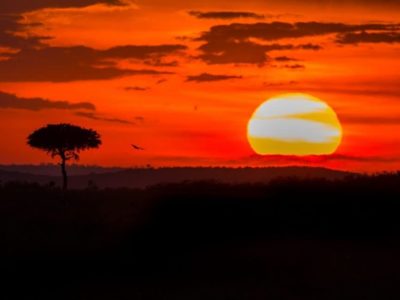
Kenya Safari – The Masai Mara Experience
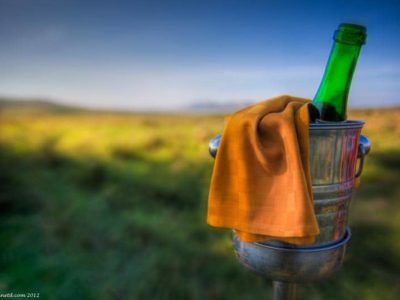
Hot Air Balloon Masai Mara – Flying High in Kenya

Explore the world with tourHQ
- Destinations
- I am a Guide
- I am a Traveller
- Online Experiences
- Currency (USD)
Hedonism and modern energy are the hallmarks of Kenya’s sprawling capital city; a city of skyscrapers, super clubs and malls that’s best explored in the company of a local guide from tourHQ.
Search Cities in Kenya
Nairobi Tour Guides
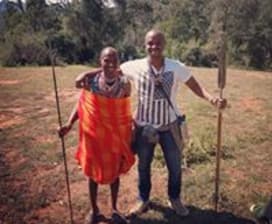
I am a 31 year old Freelance Tour Guide Kenyan with a massive passion for the outdoors, culture, ...
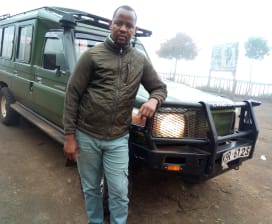
Samuel Munyua Hinga

Kwato Safaris
I have been a tour guide in Kenya for 12 years. I worked with volunteer agency and set up my own ...

Darlington Rukodza
Have been traversing Southern and Eastern Africa since 2003 as an overland guide. Groups are ...
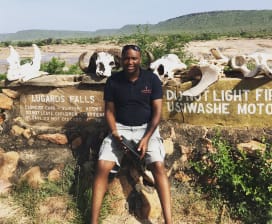
Peter Kamau Mugo
Am a professional guide registered with the kenya professional guide association of Kenya, ...
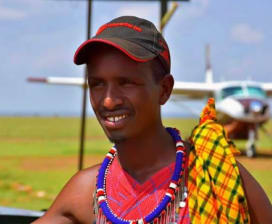
Raphael Rotiken
A local maasai warrior who went against the odds of killing lions to ditch moranism for a staring ...
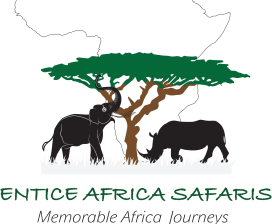
Anthony Mule
I am a nature lover, born and bred in rural Kenya. Wildlife and nature has been part of me ...
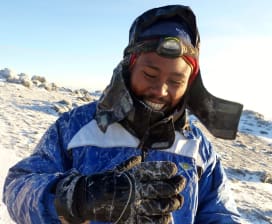
James Mountain Guide
I am a professional freelance mountain guide in Kenya since 2006 up to now. I guide in ...

Gerard Murero
I am a freelance silver level guide, I speak fluent English, Swahili and ...
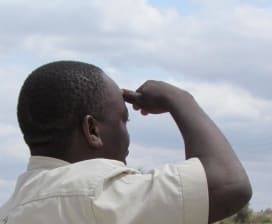
Safari Charo
Hi my name is Safari, am a tour guide by birth. Safari is in my blood and a tour ...

J R Francis
My name is J R Francis, based in Nairobi., Kenya. Lead and head of safari travel team for ...
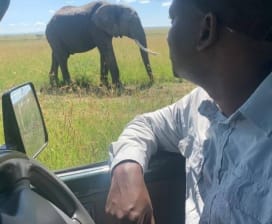
I am a professional tour guide in Kenya who has been in the field for 13 years. My area of ...
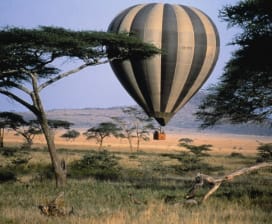
Wambua James
Safaris born and made in KenyaWe are a well established tour company based in Nairobi, Kenya, ...
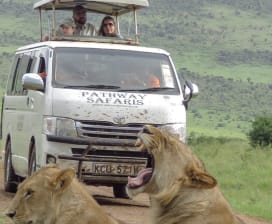
Andrew Mweti
Iam a self motivated individual, easy to go with and friendly, love to meet and make new friends ...
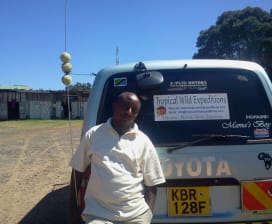
David "Safari Specialist"
I am a professional tour guide with lot of experience in East Africa map, flora and fauna. I will ...

Mwangi Sammy
I Mwangi Sammy, born and raised at the foothills of Mount Kenya. After high school, I had to ...
Once an unassuming frontier town founded on the route of the Uganda Railway line, Nairobi is now the thriving metropolitan heart of Kenya and East Africa as a whole. While without any major ‘must see’ sights, and a ‘dangerous’ tag to it, Nairobi’s charm and boundless energy thrums through its bars, clubs, cultural spots, gastronomic establishments and intriguing local character. A truly hedonistic nightlife and burgeoning culinary scene mean there’s always somewhere to go for a bite to eat or a drink in the evening, while the myriad museums are amongst the nation’s most comprehensive and intriguing. Of these, the National Museum of Kenya offers a unique insight into the cultural history of this much-colonised corner of the African continent. Nairobi is also one of the best-developed transport hubs of the whole region, and many visitors coming to Kenya on the ubiquitous safari holiday will fly either in or out of JKIA Jomo Kenyatta International. If you’re passing through and don’t want to leave without a glimpse of the iconic Kenyan wildlife, check out the Langata Giraffe Park or Nairobi National Reserve, both of which sit within easy reach from the City centre and can be found in most all Nairobi tour guide books.
Tell us your destination, date, and group size.
Our team of travel experts and guides will design a tailored itinerary just for you., enjoy your trip with peace of mind knowing everything is taken care of..
Say Goodbye to Travel Stress
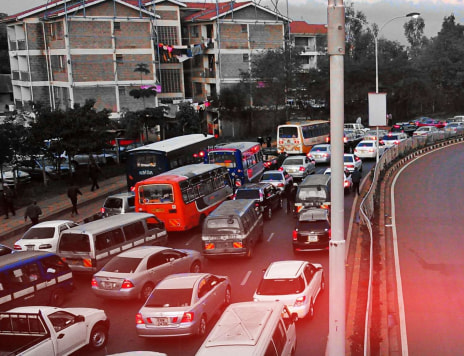
Choose Currency Close modal
- USD US, dollar
- GBP British Pounds
Cookie icon We use cookies!
We, and third parties, use cookies for technical and analytical purposes, for marketing purposes and for integration with social media. For more information, refer to our Privacy Policy and Terms of Consent.
By clicking on 'I agree', you consent to the use of these cookies.

IMAGES
VIDEO
COMMENTS
In our Nairobi Travel Guide, we weave together captivating storytelling, practical advice, and insider tips to ensure your journey is nothing short of extraordinary. - Comprehensive Exploration: Dive deep into Nairobi's neighborhoods, attractions, and cultural experiences, curated for travelers of all interests and preferences.
A travel guide to visiting Nairobi and the top things to do in Nairobi Kenya, including the most popular attractions as well as some lesser-known places. We'll also give you information and tips on getting to Nairobi, how to get around the city, where to stay in Nairobi, where to eat in Nairobi, how to book tours, and how to stay safe in Nairobi. We give travel advice based on our travels to ...
In this comprehensive Nairobi travel guide, we delve into the best things to do in Nairobi, Kenya, ensuring that you make the most of your time in this dynamic city. ... It's advisable to book your accommodation in advance, especially during peak travel times. Local Currency: The official currency in Kenya is the Kenyan Shilling (KES). It's ...
This Kenya guidebook covers: Nairobi and around, The Central Highlands, Rift Valley, Western Kenya, The national parks and Mombasa Highway, The coast, The north. Inside this Kenya travel book, you'll find: A wide range of sights - Rough Guides experts have hand-picked places for travellers with different needs and desires: off-the-beaten ...
This site is owned by Apa Digital AG, Bahnhofplatz 6, 8854 Siebnen, Switzerland. Rough Guides® is a trademark owned by Apa Group with its headquarters at 7 Bell Yard London WC2A 2JR, United Kingdom. Nairobi and around - plan your visit with Rough Guides and get travel tips, recommendations and advice for where to go and what to do.
The Best of Nairobi in One Week - A Travel Itinerary. Day 1 - Nairobi. Day 2 - David Sheldrick Wildlife Trust and Giraffe Manor. Day 3 - Safari at Nairobi National Park. Day 4 - Drive to Naivasha & visit Crescent Island. Day 5 - Naivasha - Hells Gate. Day 6 - Naivasha - take a boat tour and visit Crater Lake.
The most comprehensive tourist guide for Nairobi, Kenya with advice on things to do and see, places to visit and more. Insight Guides provides inspiration for travelling around the world. ... Book & travel securely - money-back guarantee & 24/7 support. Destinations . Italy Portugal Croatia Iceland. Costa Rica Scotland Argentina.
Book your flights. Places in Nairobi. Airports Nairobi Jomo Kenyatta International Airport; Nairobi Travel Guide About Nairobi. Part bustling African metropolis, part explorers' camp, Kenya's capital Nairobi is an intoxicating blend of cosmopolitan culture, gritty, urban slums and thoroughly modern city life. The gateway to some of the most ...
Nairobi Travel Guide. Photograph by Buena Vista Images, Getty Images. Why It's Worth It. Nairobi is a modern and bustling city, rich in culture and history, but with fantastic nature and wildlife ...
The 20 best kenya travel guide books recommended by The Philadelphia Inquirer, such as Kenya, Kenya 9 and DK Eyewitness Kraków. Categories Experts Newsletter. BookAuthority; BookAuthority is the world's leading site for book recommendations, helping you discover the most recommended books on any subject. Explore; Home; Best Books; New Books ...
Most nationalities can apply for a visa on arrival in Kenya. You can check this website to see which nationalities require visas. Single Entry tourist visa: $25 (£20) - valid for 3 months. Multiple entry tourist visa (great if you are traveling around in East Africa): $50 (£30) Kenya transit visa: $10.
The capital of and largest city of Kenya, with a population of over 4.4 million. The only city in the world located right next to a major national park (Nairobi National Park). Contains Kibera, the largest urban slum in Africa (with over 170,000 inhabitants). Nicknames: Green City in the Sun, Safari Capital of Africa, Nairobbery (in jest).
Nairobi Travel Guide: Things to Do, Itinerary, Tips, & Accommodations. Nairobi has positioned itself on the world map as an ideal travel destination. Started as a railway depot in 1899, the city has grown in leaps and bounds and is now home to over four million people. Famous for its unique attraction sites, diverse cultures, thrilling events ...
Fast Facts about Kenya. Kenyan power voltage is 240 V 50 Hz; Plug G. The Kenyan currency is the shilling and is around 86 shillings for 1 USD. Virtually all banks in Kenya now have ATMs at most branches. Barclays Bank has easily the most reliable machines for international withdrawals. Standard Chartered and Kenya Commercial Bank ATMs also ...
The standard voltage is 240 V, and the frequency is 50 Hz. For foreign travelers, I recommend buying a universal adapter (make sure it has surge protection) and using a converter for hair dryers and hot tools. Safety: Kenya is generally a safe country to visit. However, you'll need to keep an eye out for pickpockets and avoid walking around ...
Our team of travel experts and guides will design a tailored itinerary just for you. Enjoy your trip with peace of mind knowing everything is taken care of. Hedonism and modern energy are the hallmarks of Kenya's sprawling capital city; a city of skyscrapers, super clubs and malls that's best explored in the company of a local guide from ...
10. From Nairobi: Hell's Gate and Lake Naivasha Day Trip. Explore the wonderful nature at hells gate park around rift-valley and later enjoy boat ride at lake naivasha. Having limited time in Nairobi, take advantage of this 1 day trip to hells Gate and Lake naivasha safari 1.
The Complete Nairobi Travel Guide: Your All-in-One Travel Companion for Safari Adventures, Stunning Landscapes, and Vibrant Culture [Hartley, Alexis] on Amazon.com. *FREE* shipping on qualifying offers. The Complete Nairobi Travel Guide: Your All-in-One Travel Companion for Safari Adventures, Stunning Landscapes, and Vibrant Culture
Navigating Nairobi: The Ultimate Travel Guide [Dorn, Barbara] on Amazon.com. *FREE* shipping on qualifying offers. Navigating Nairobi: The Ultimate Travel Guide